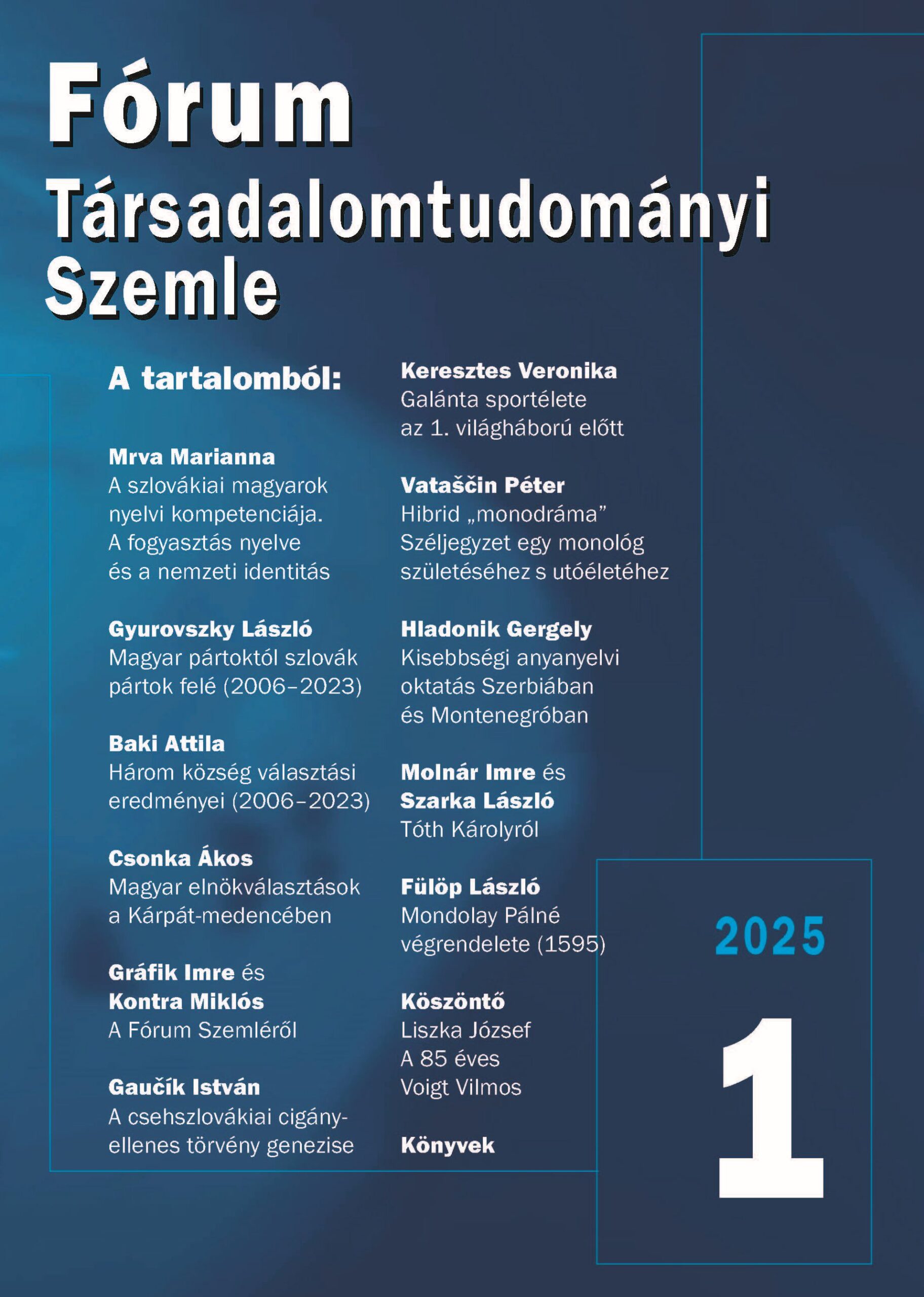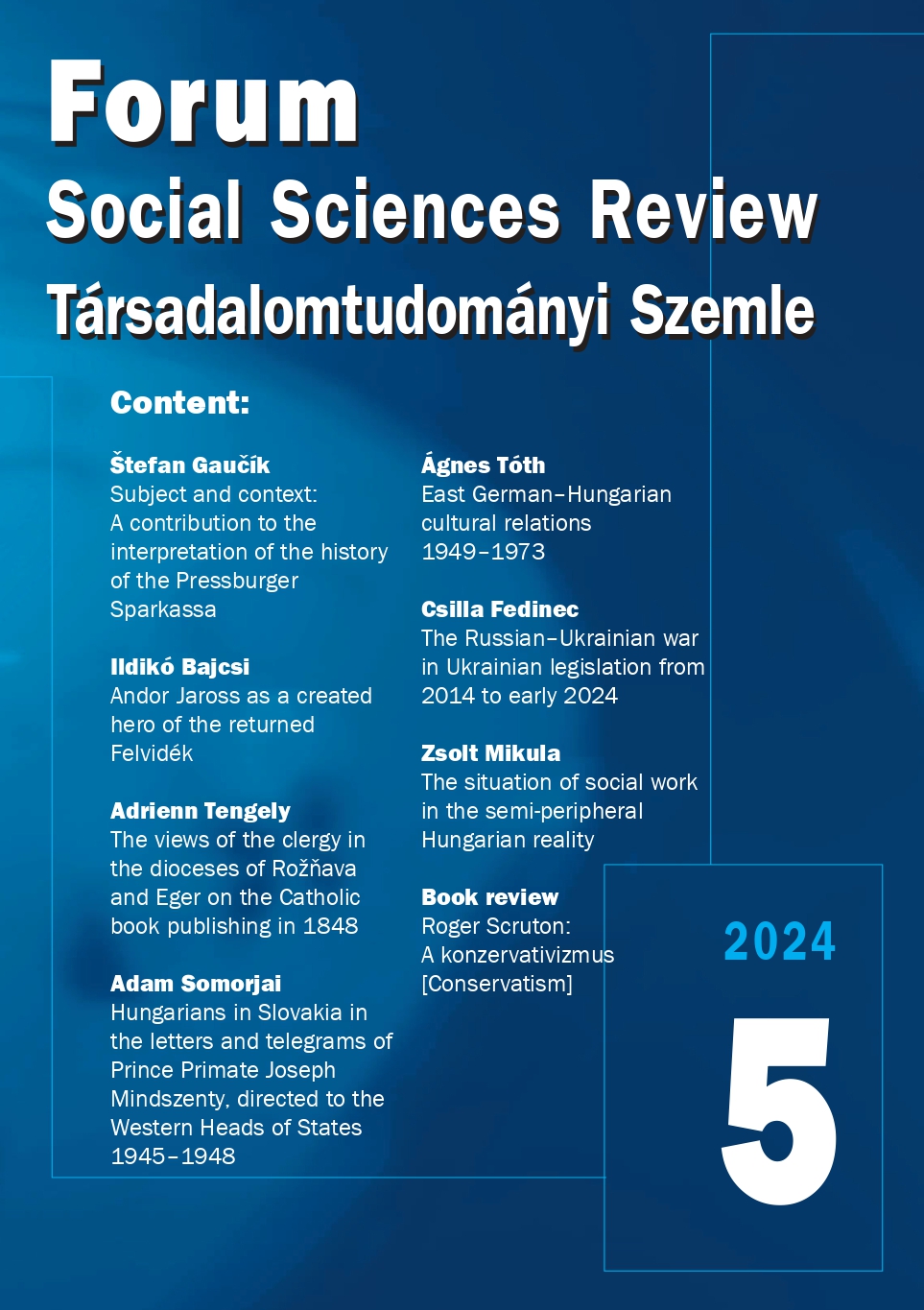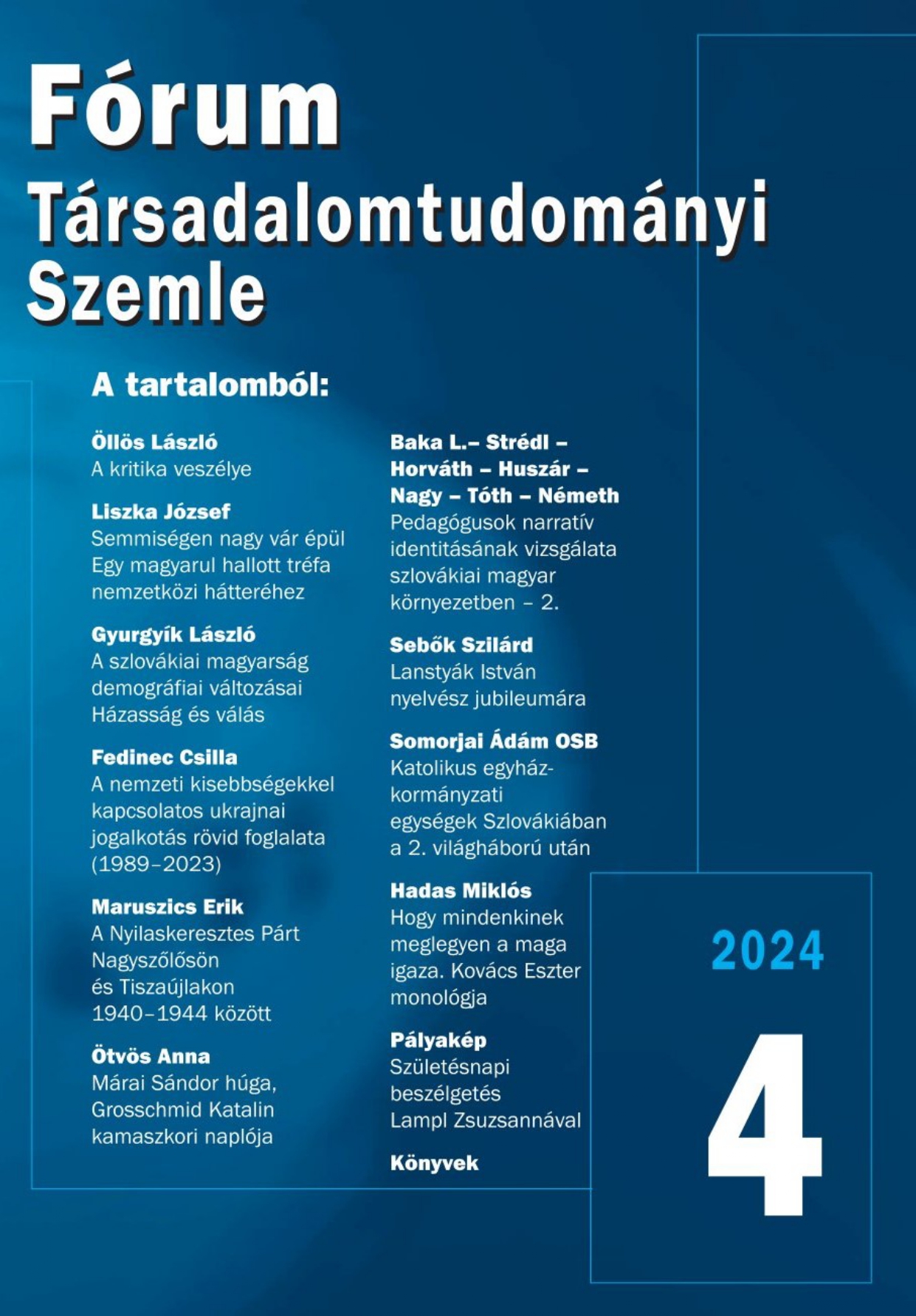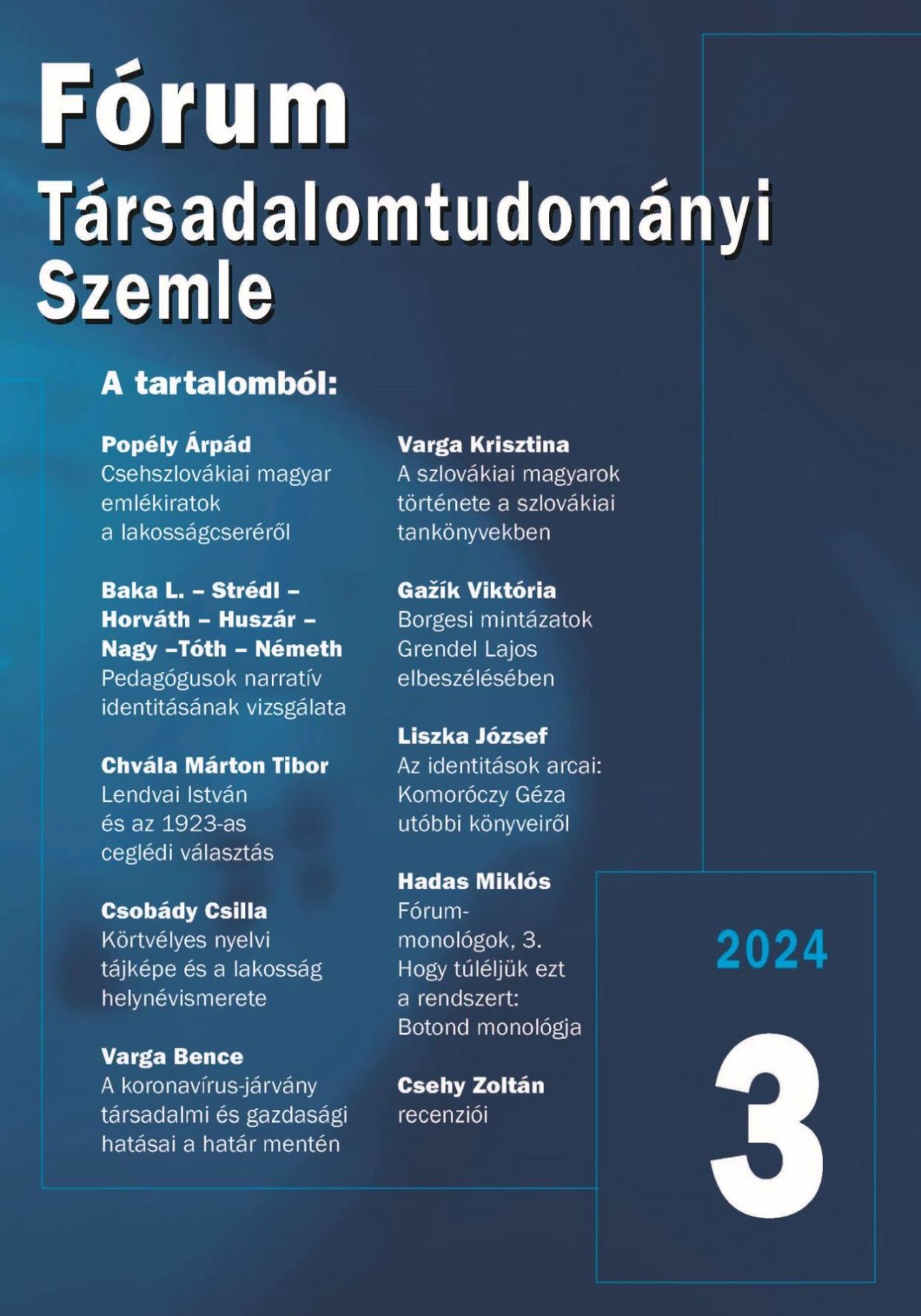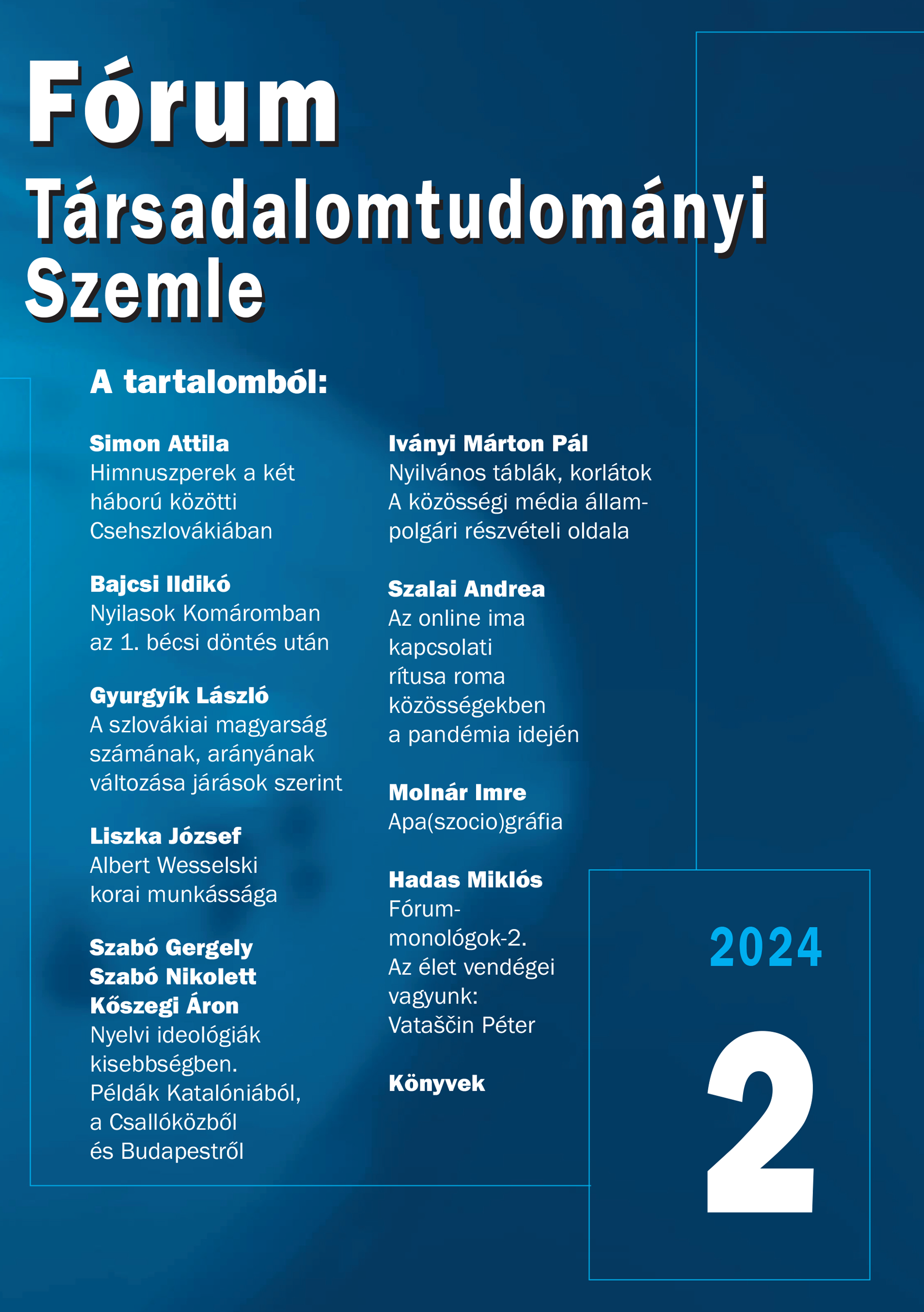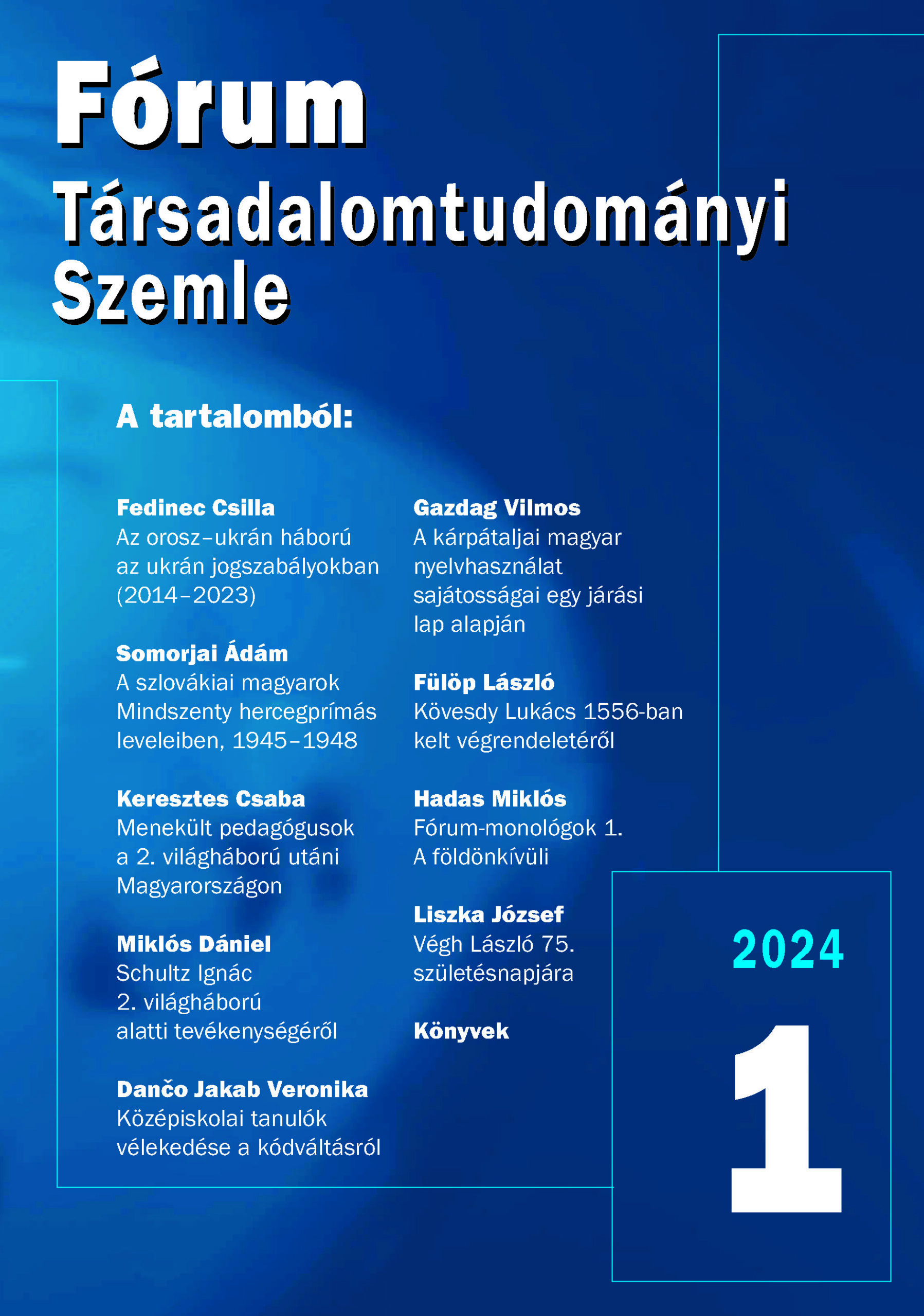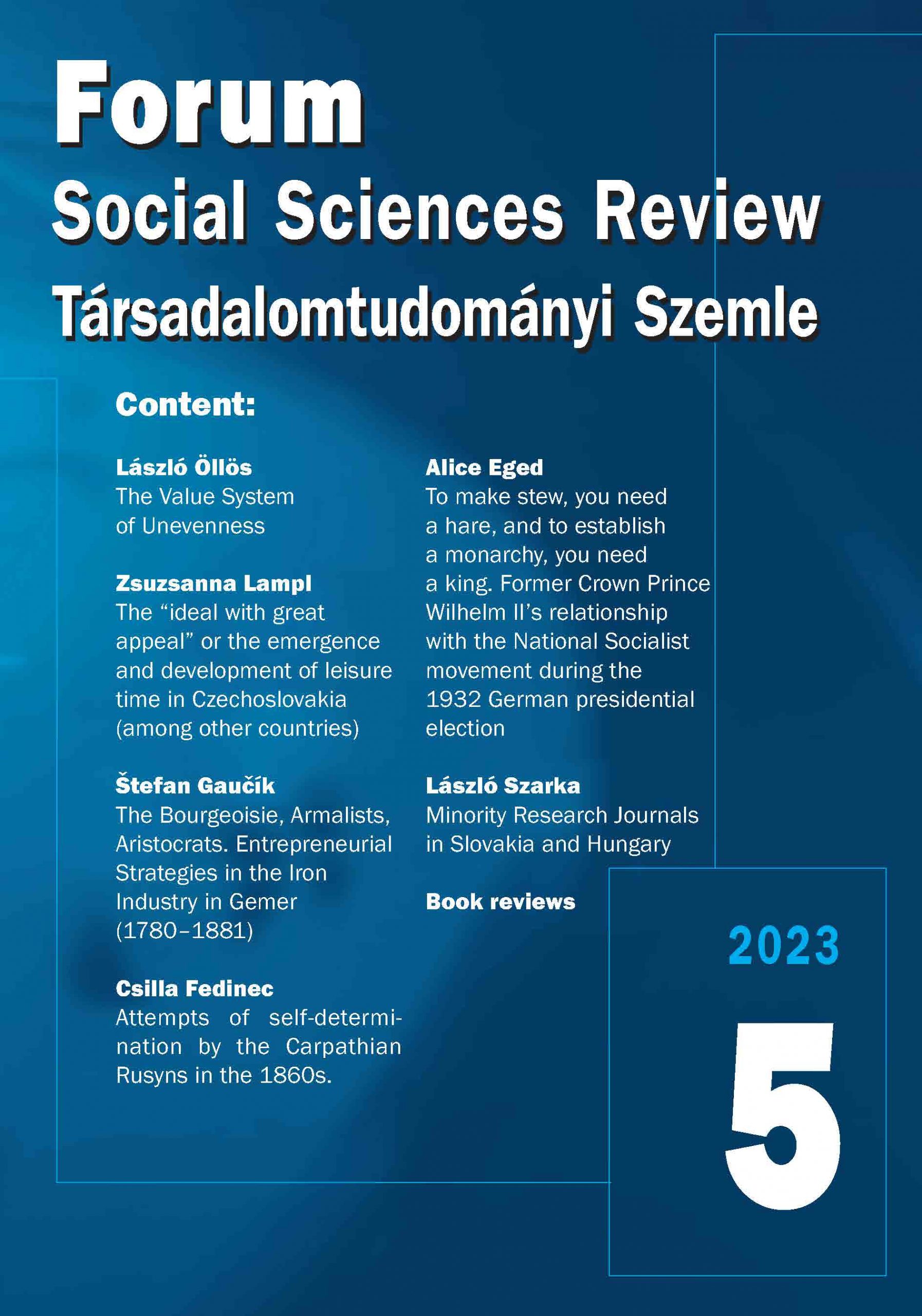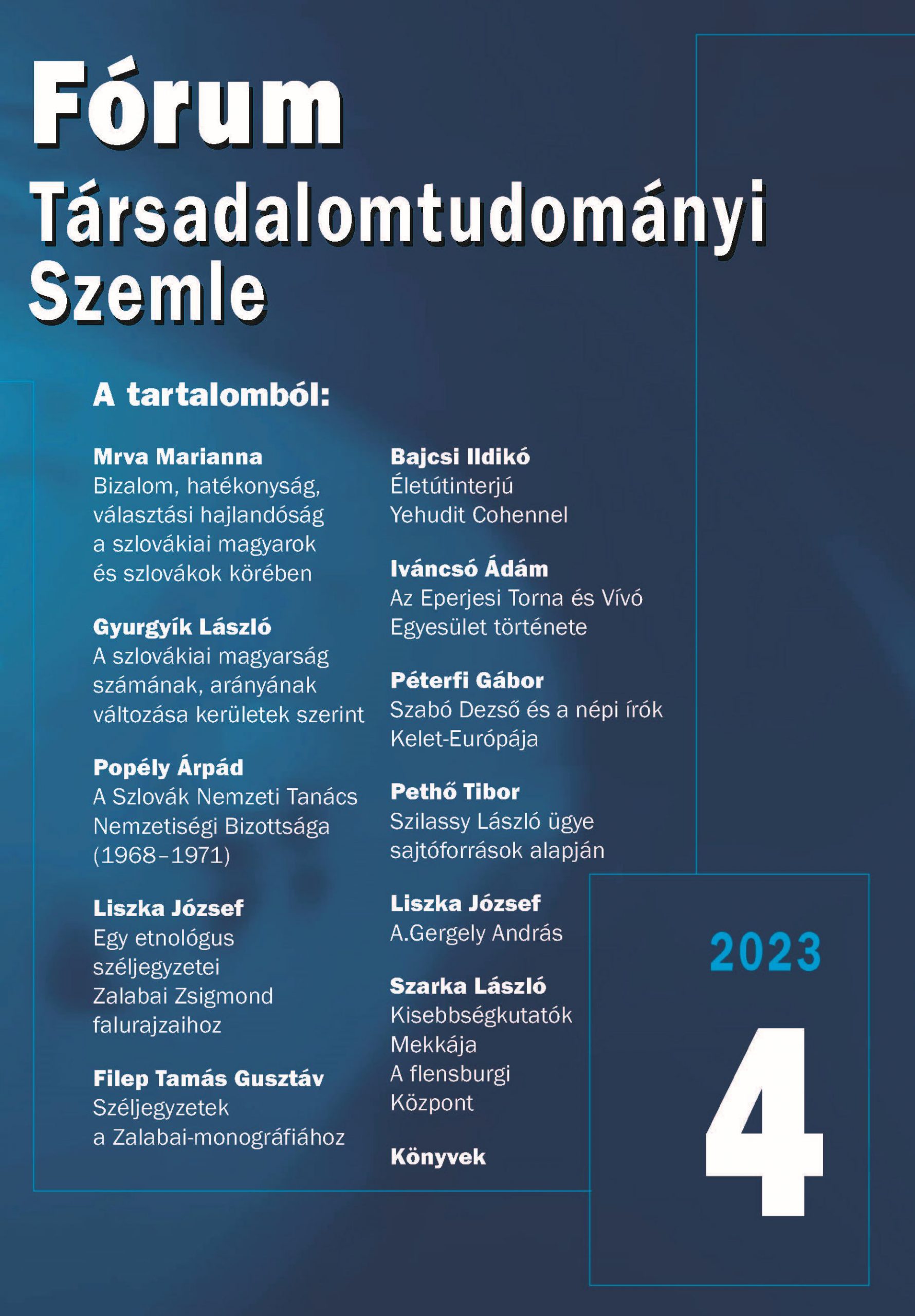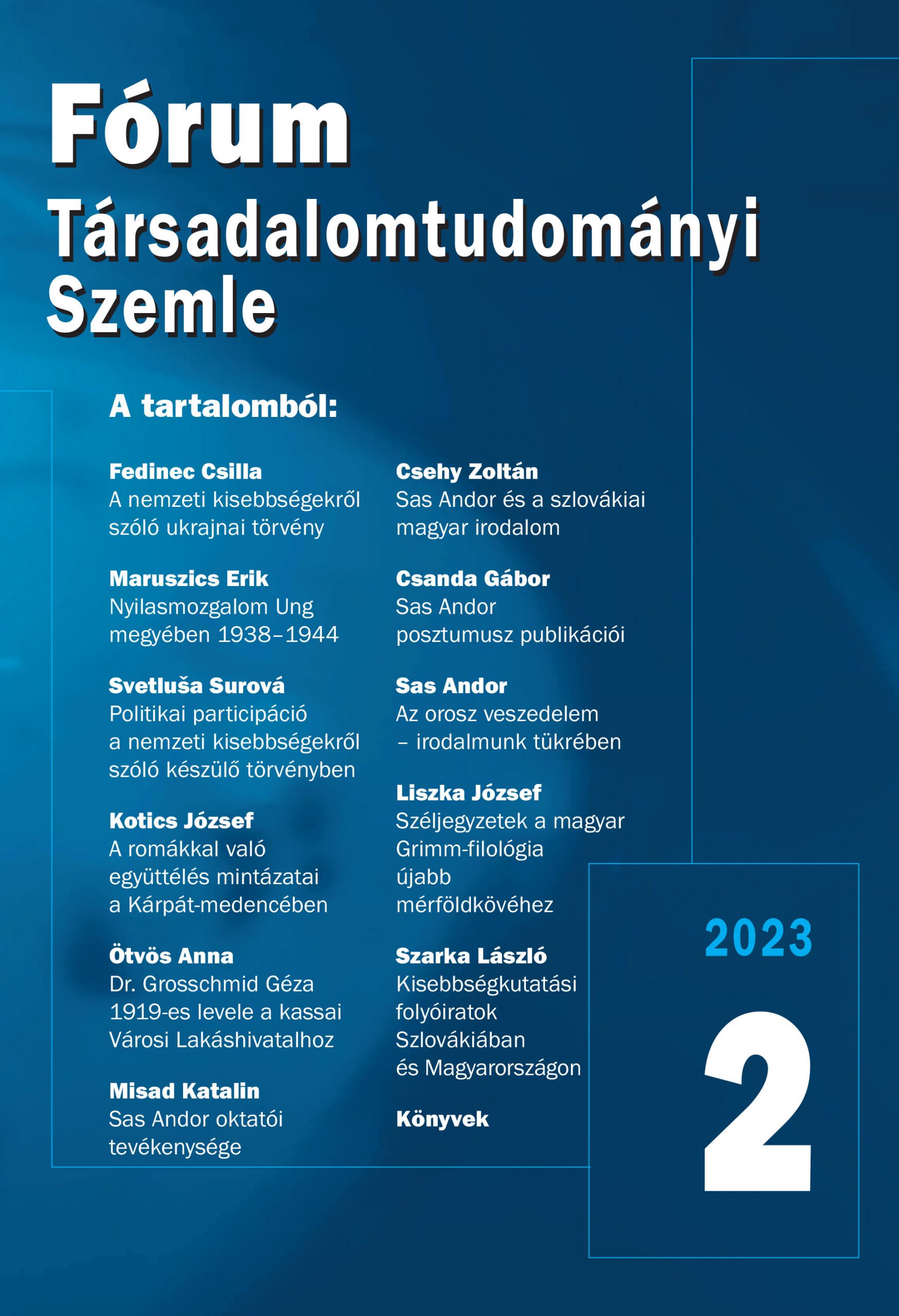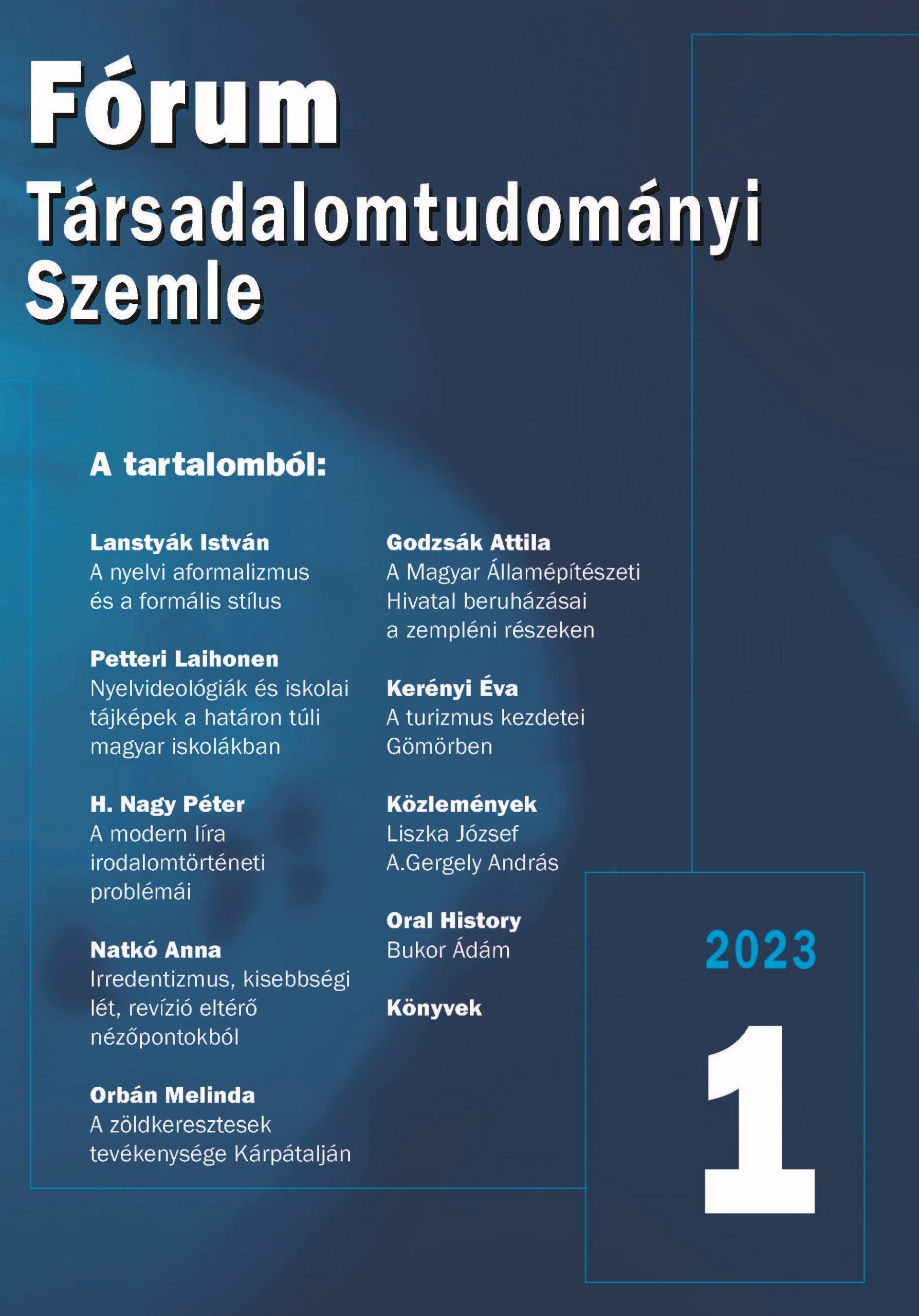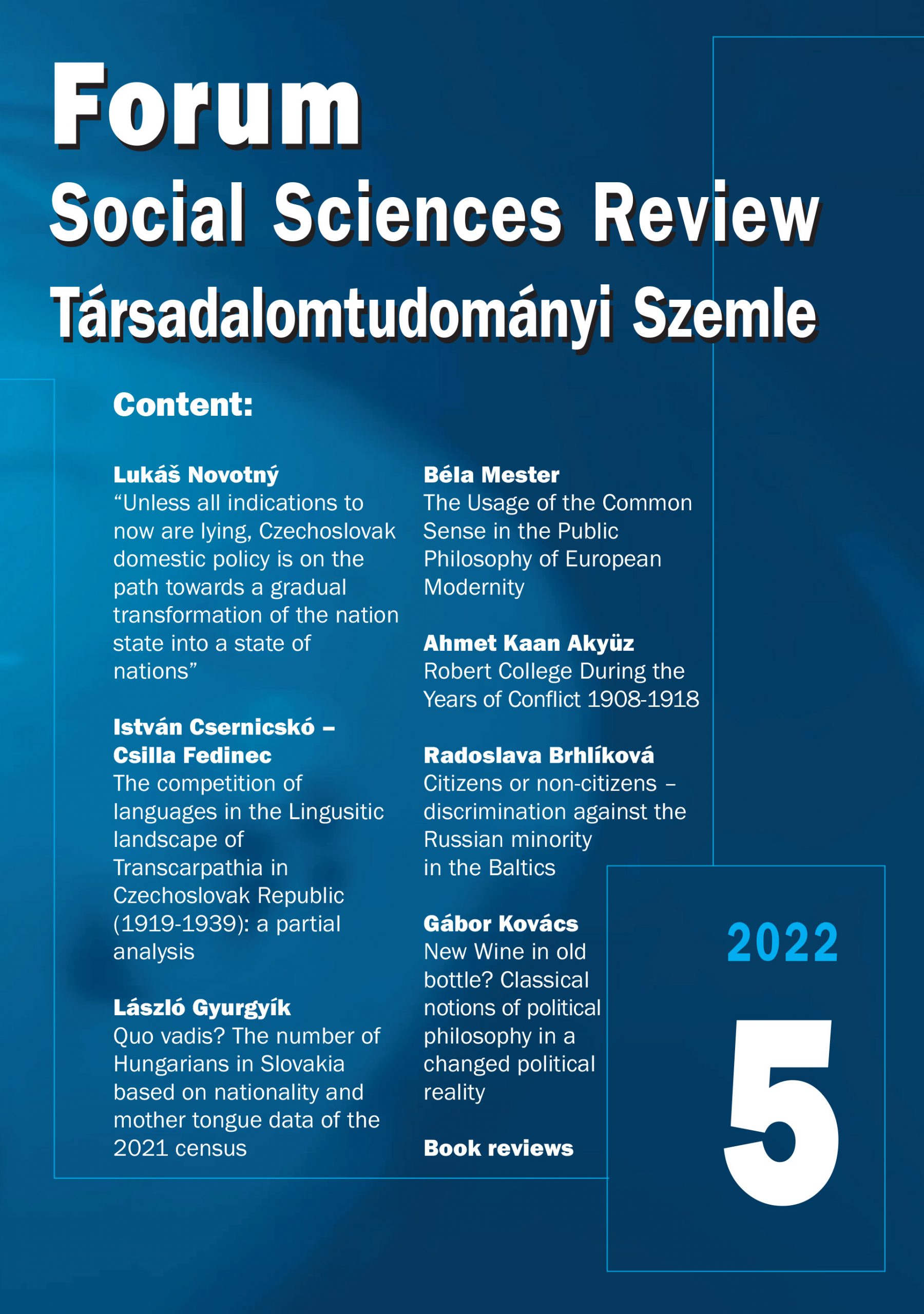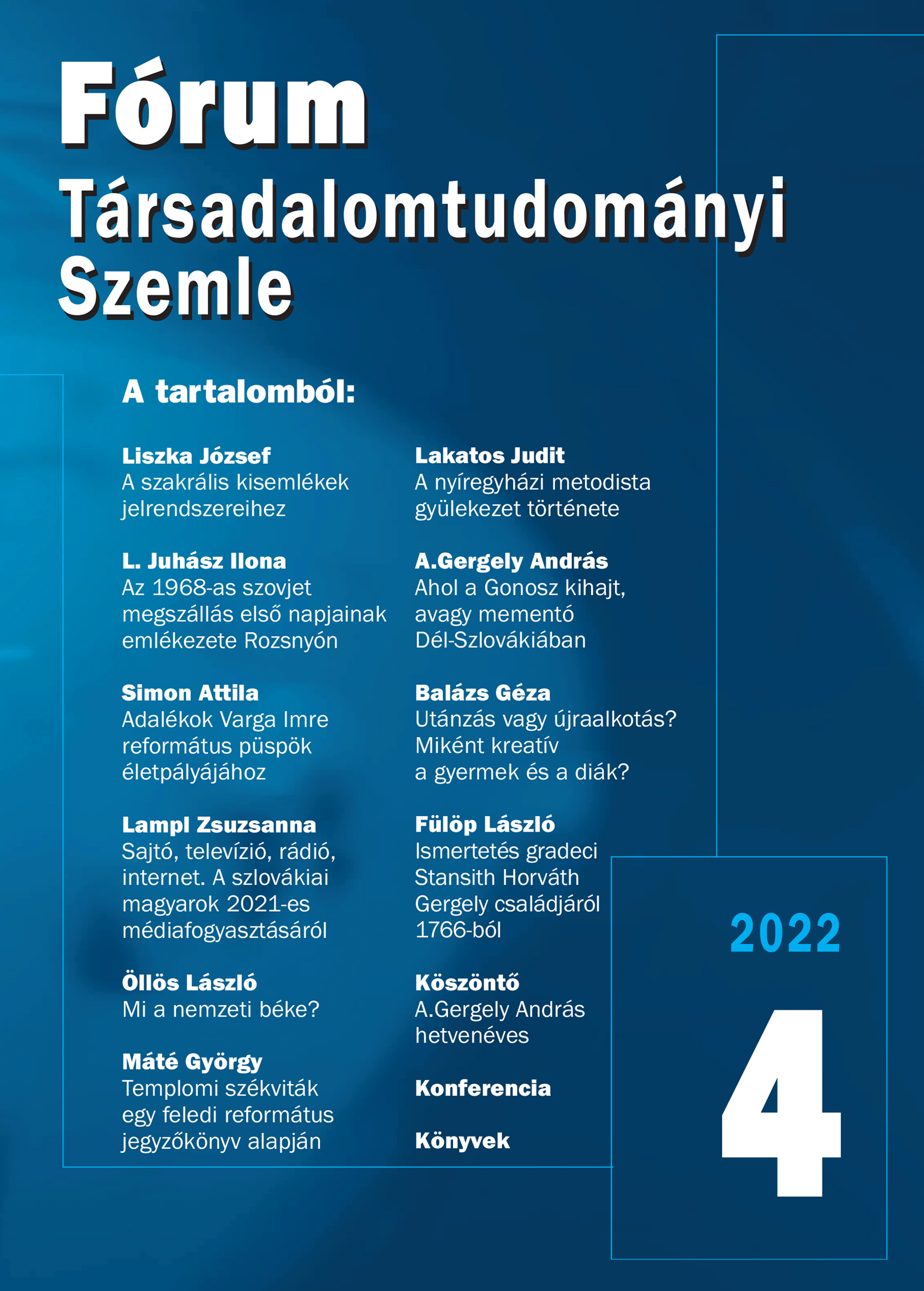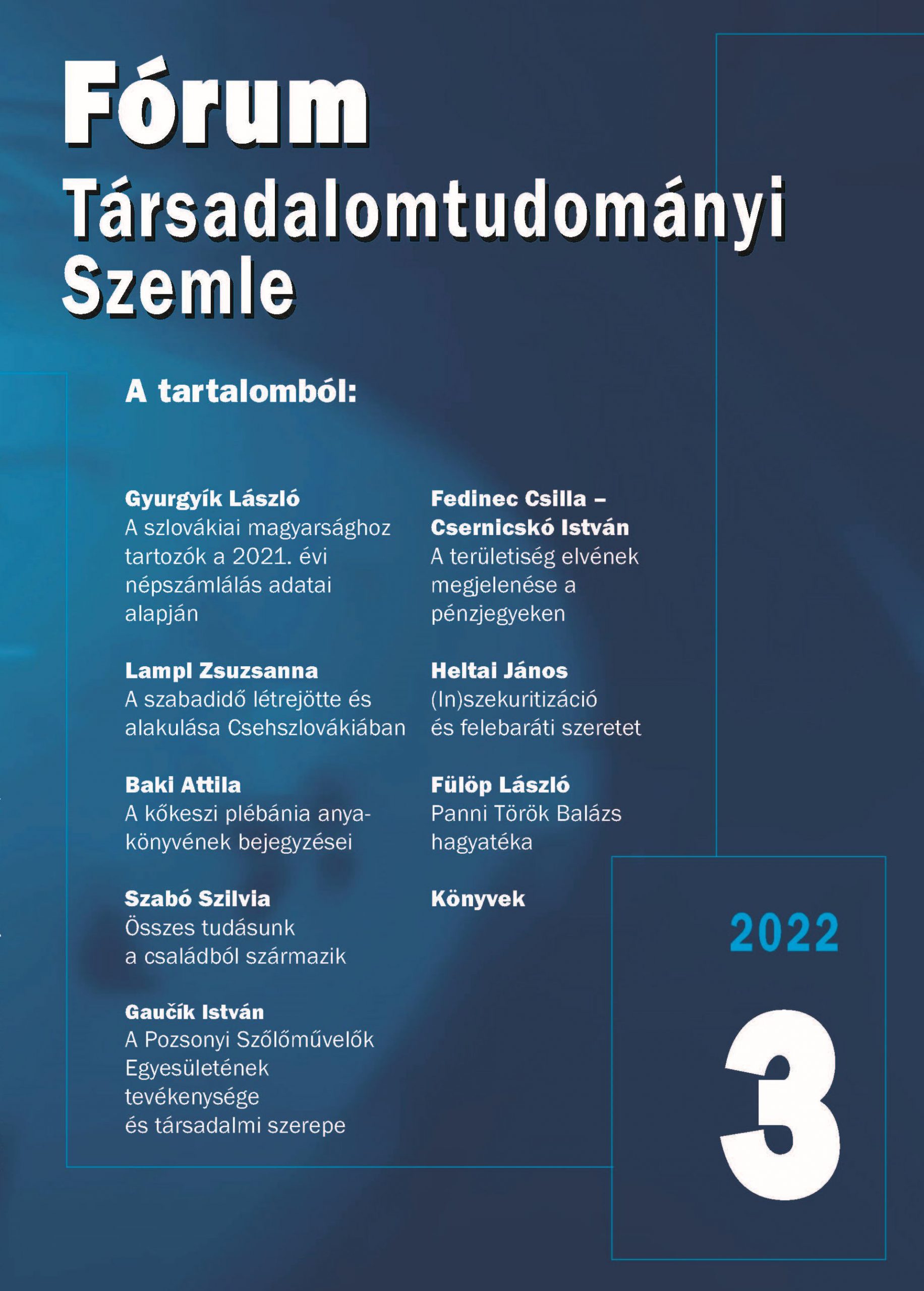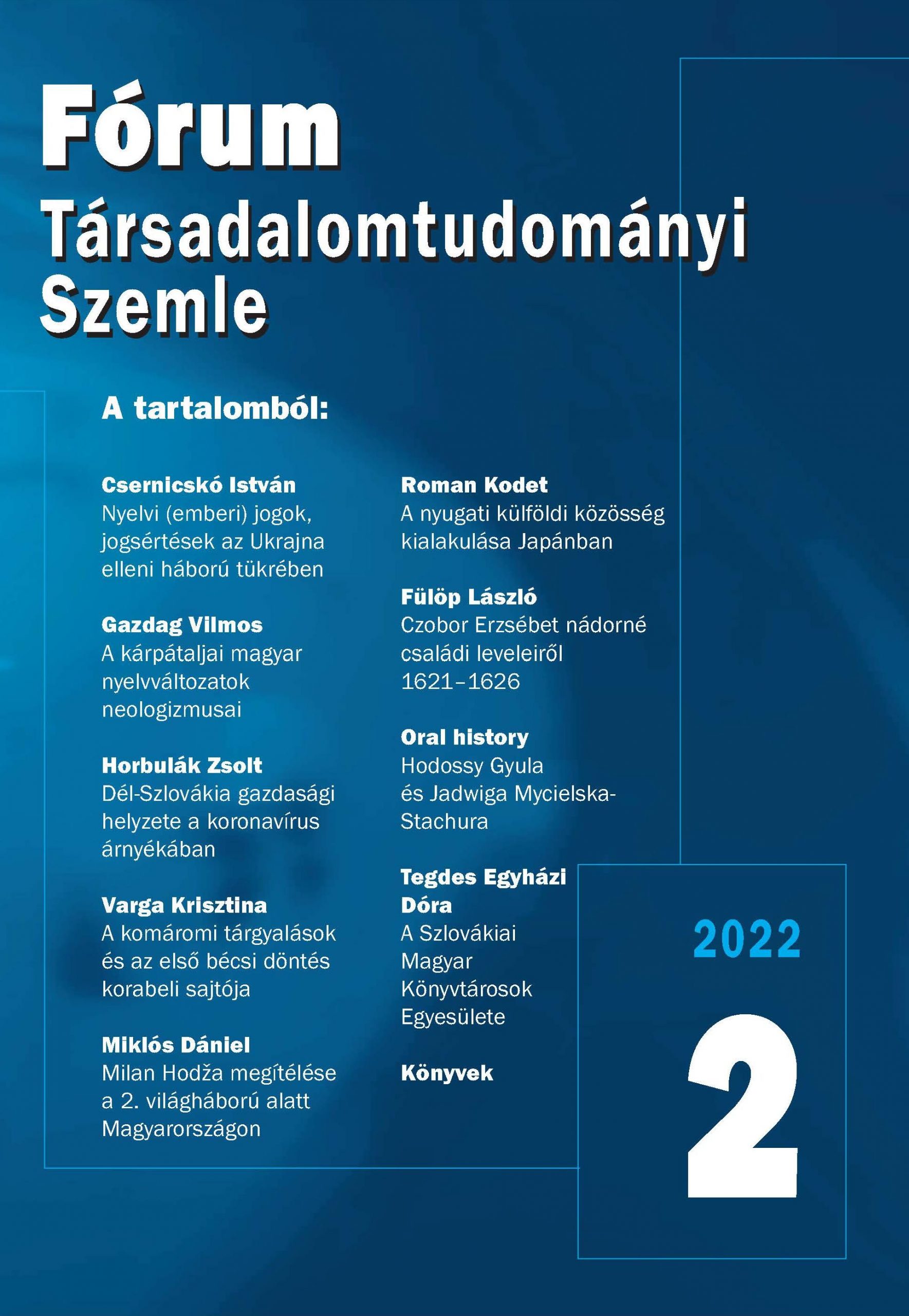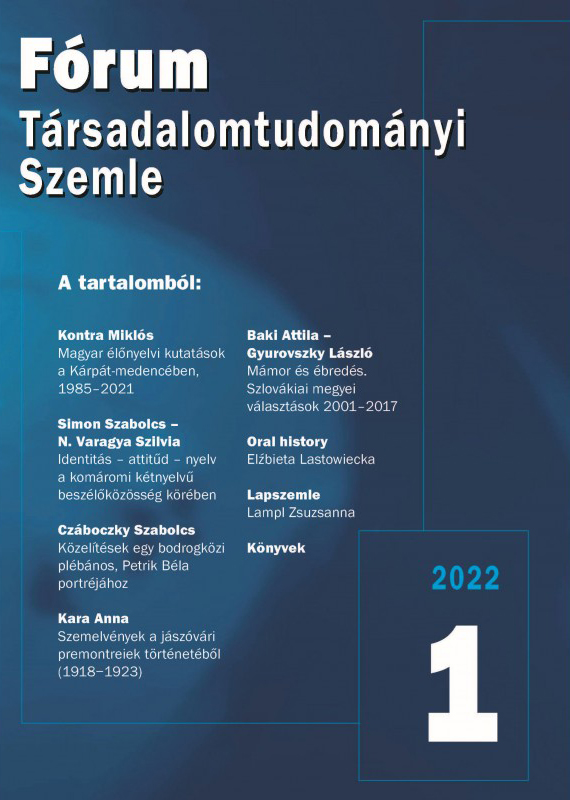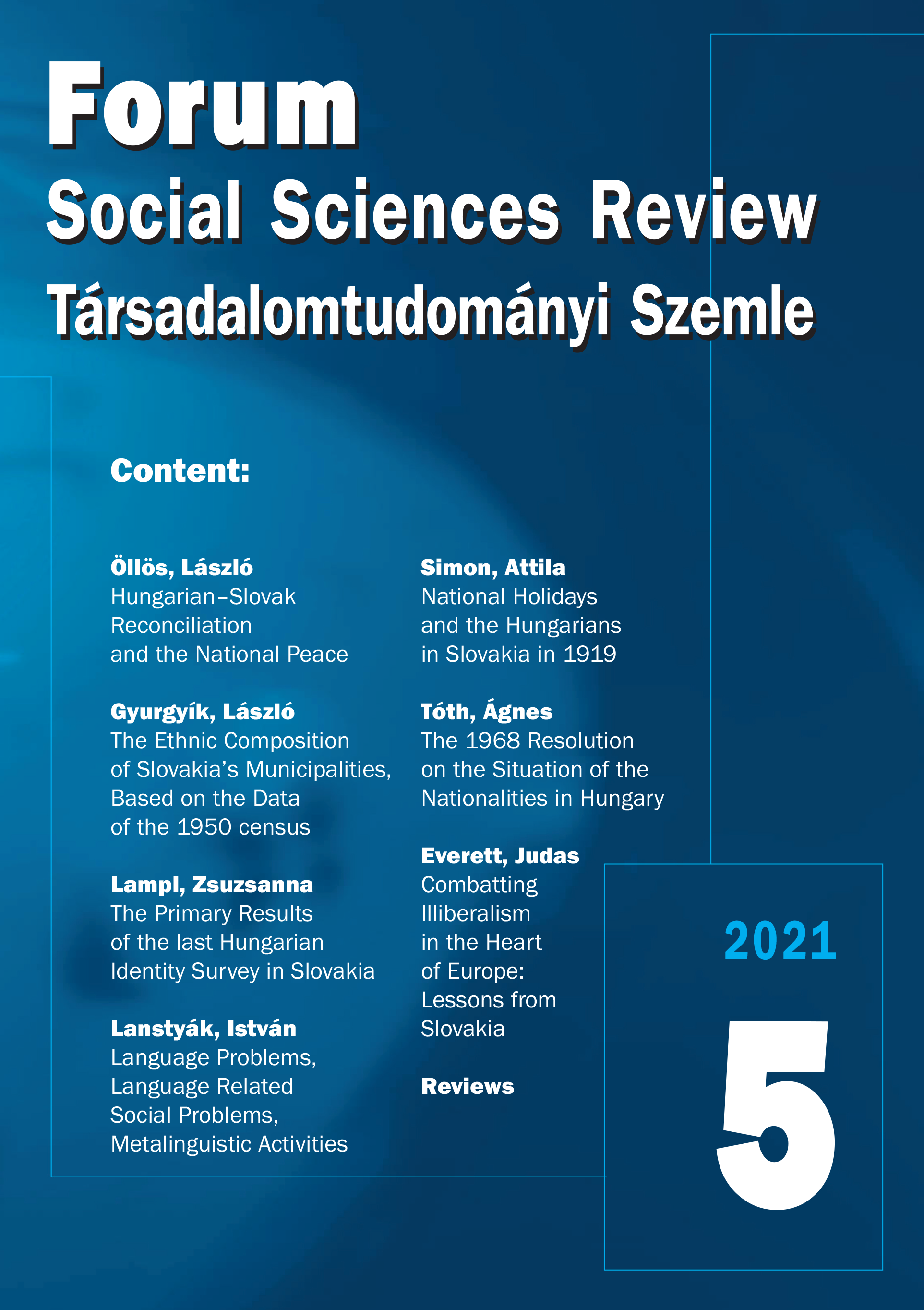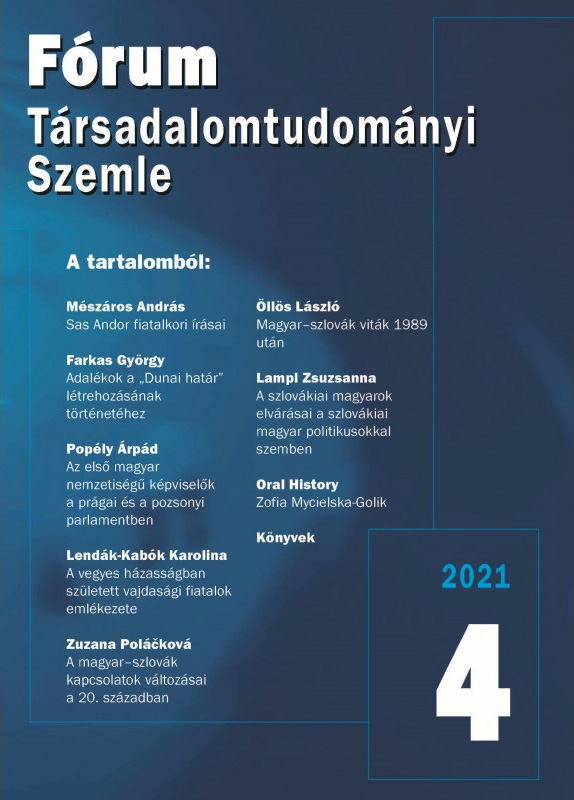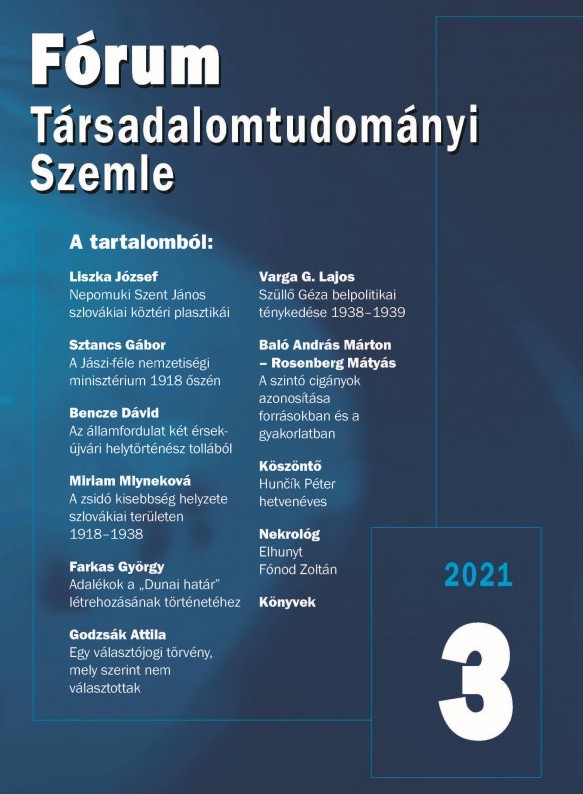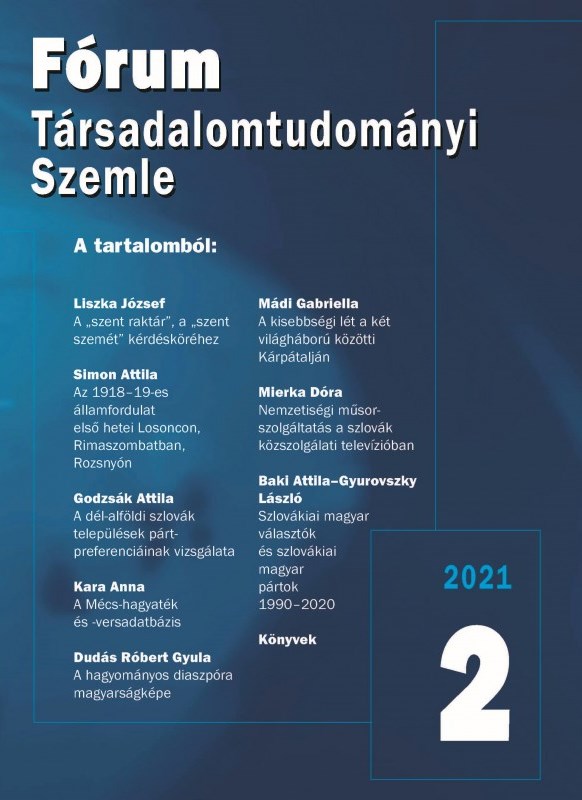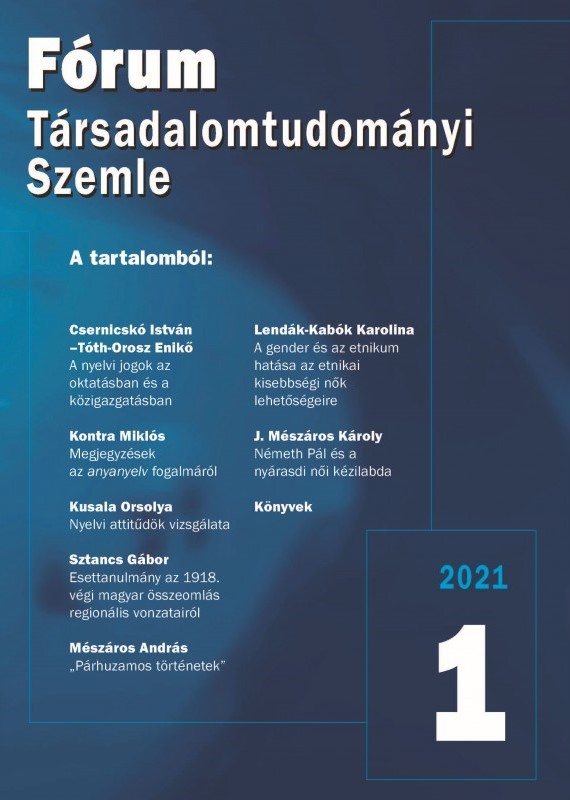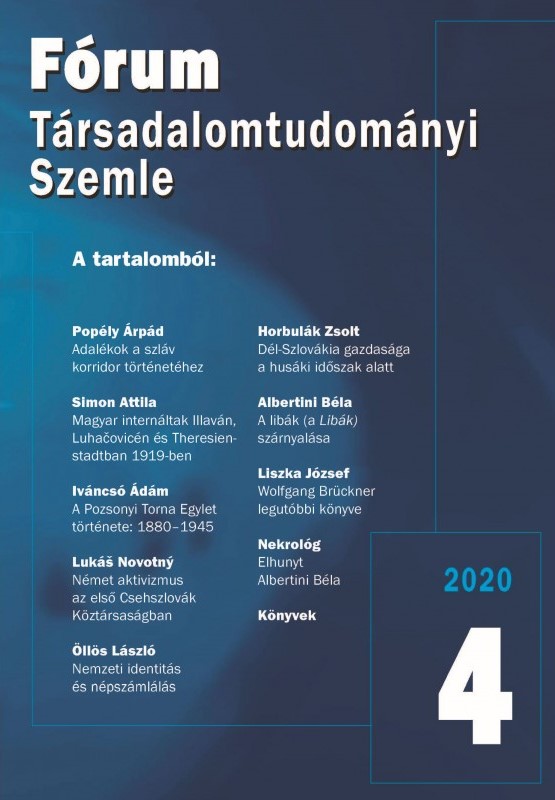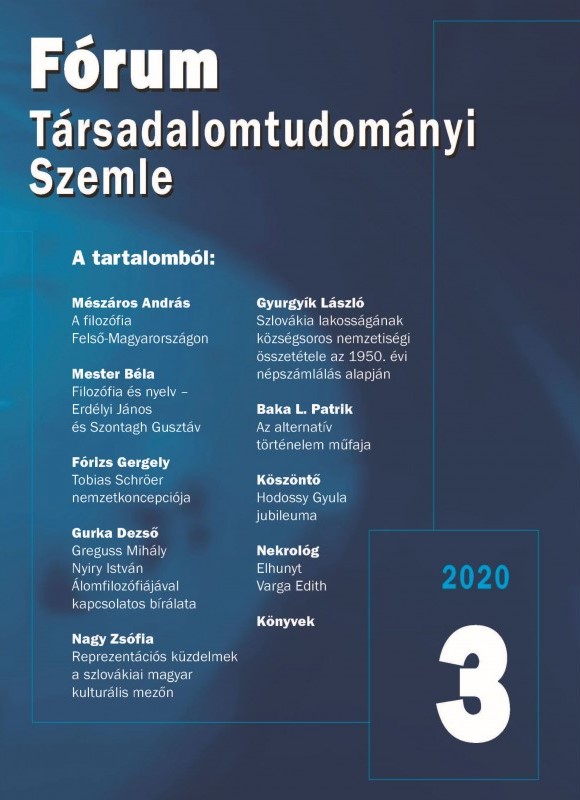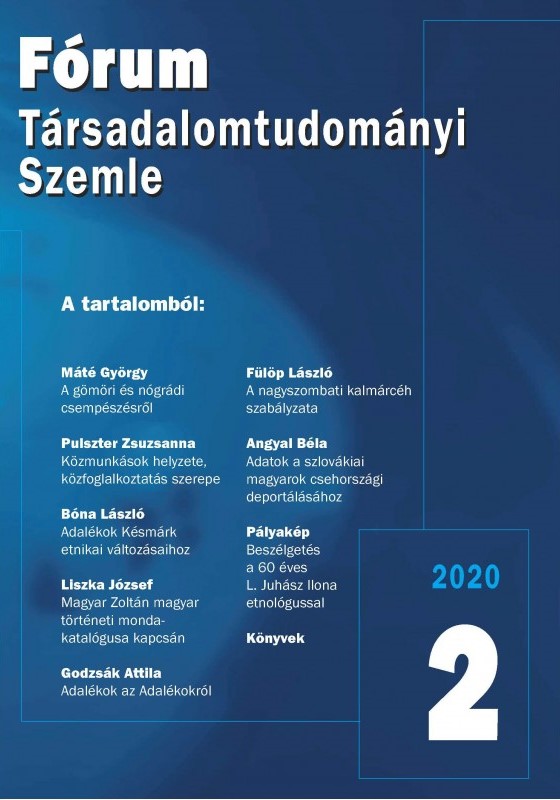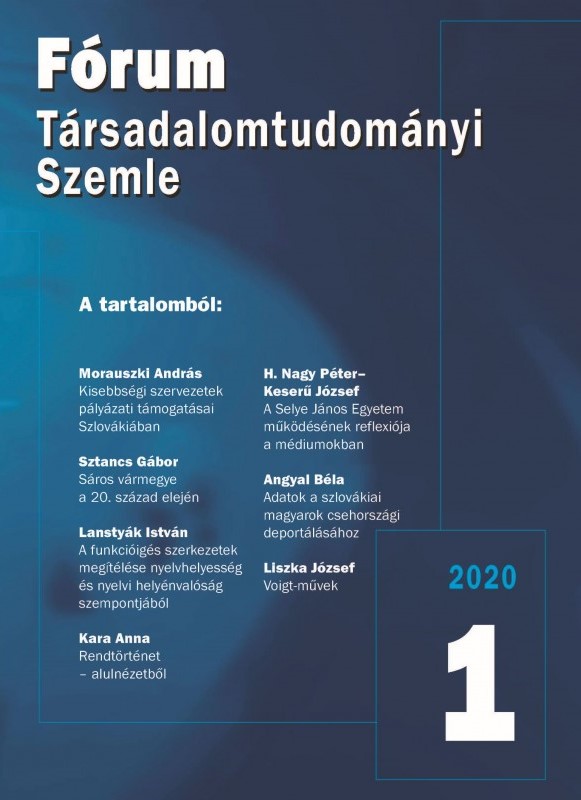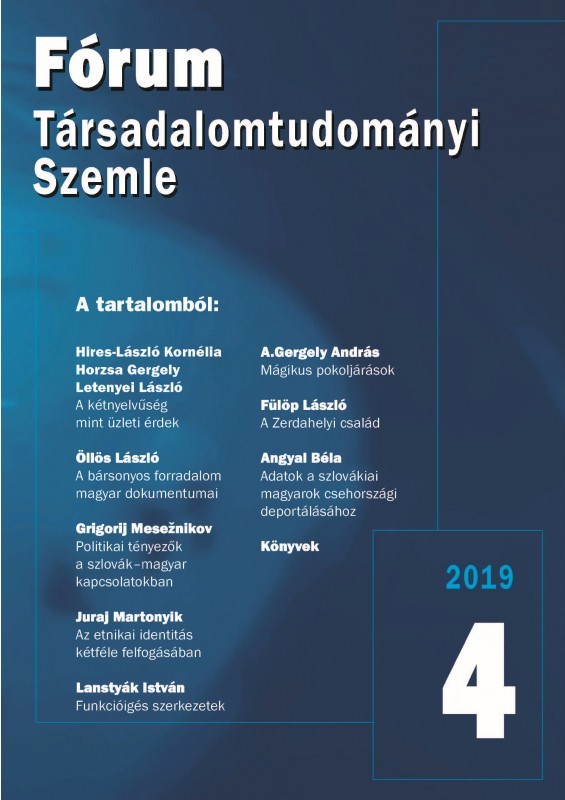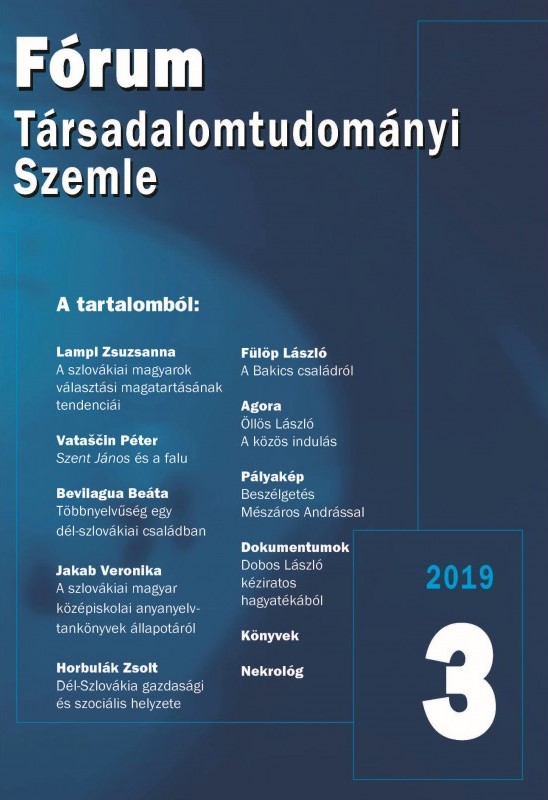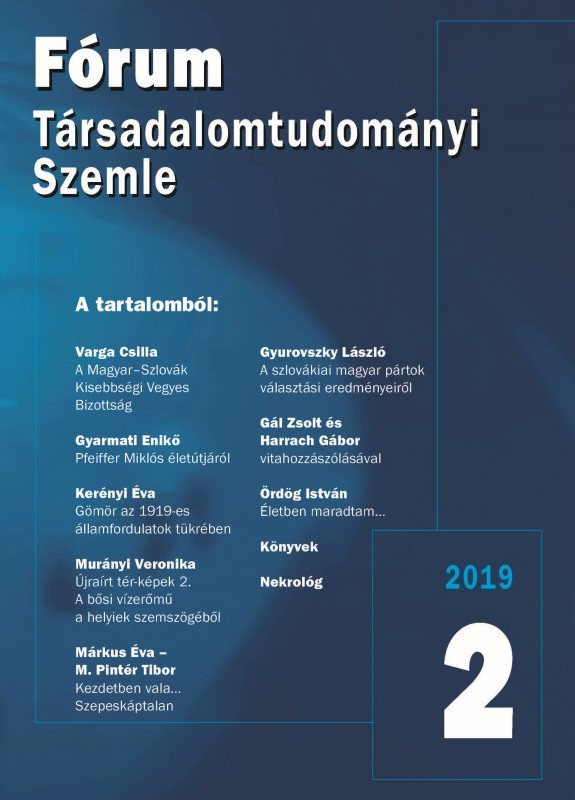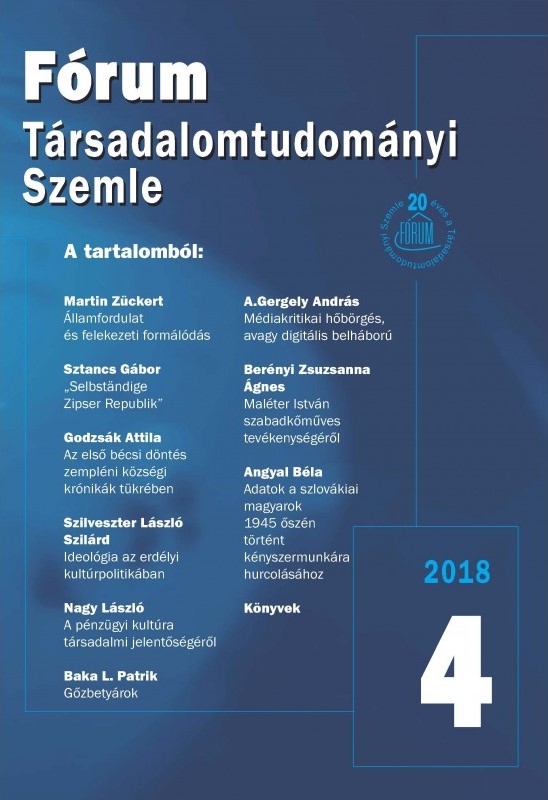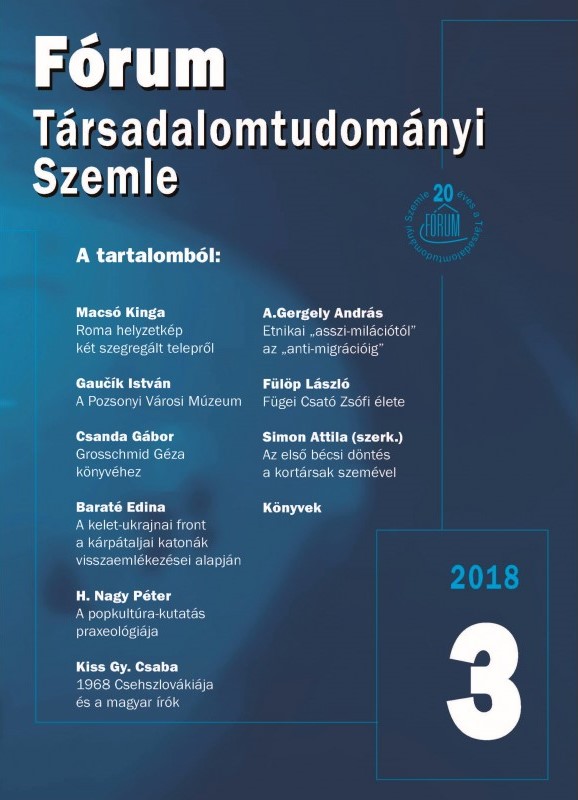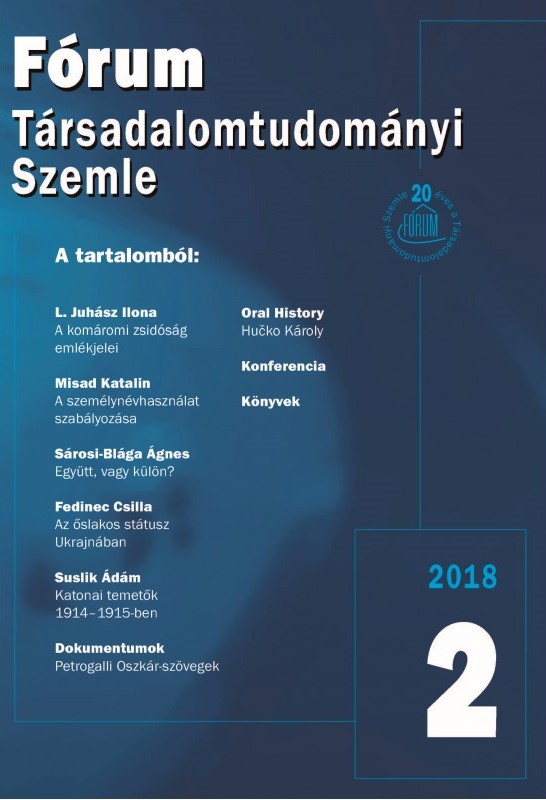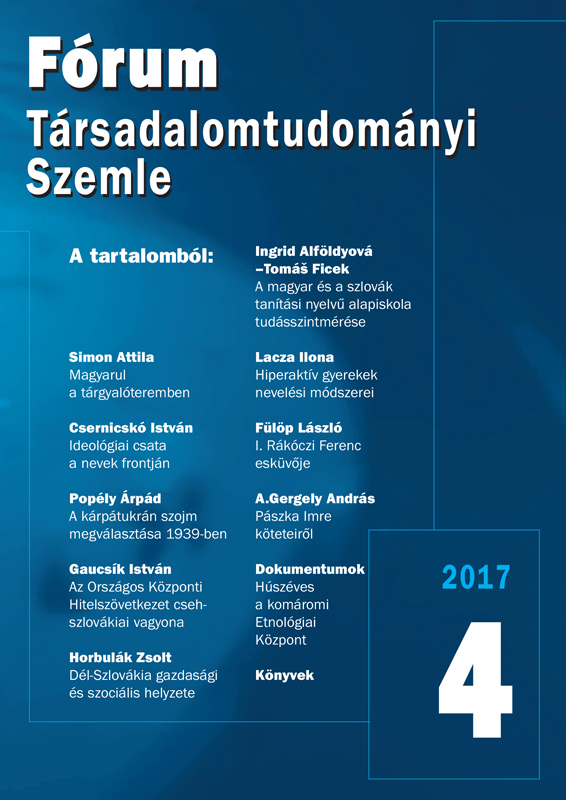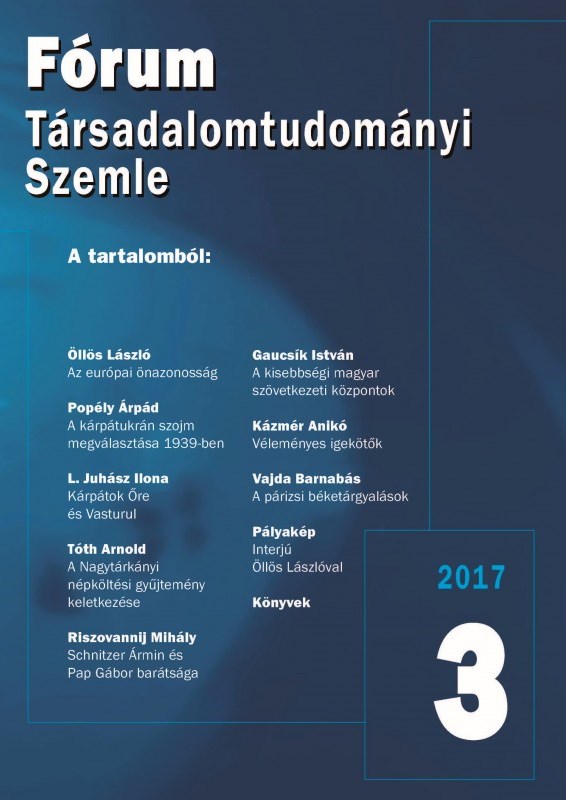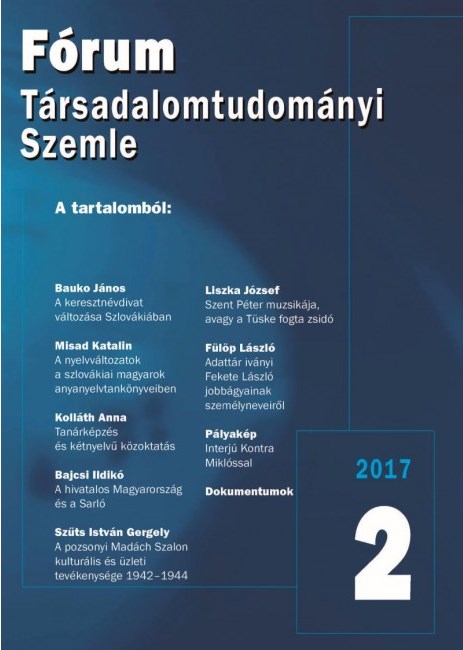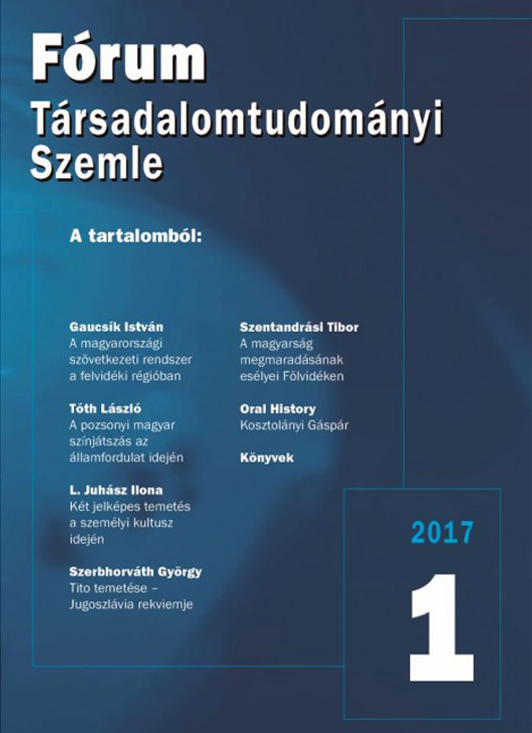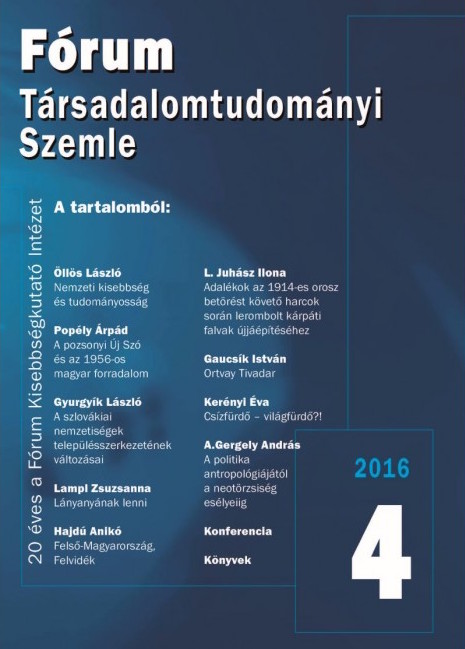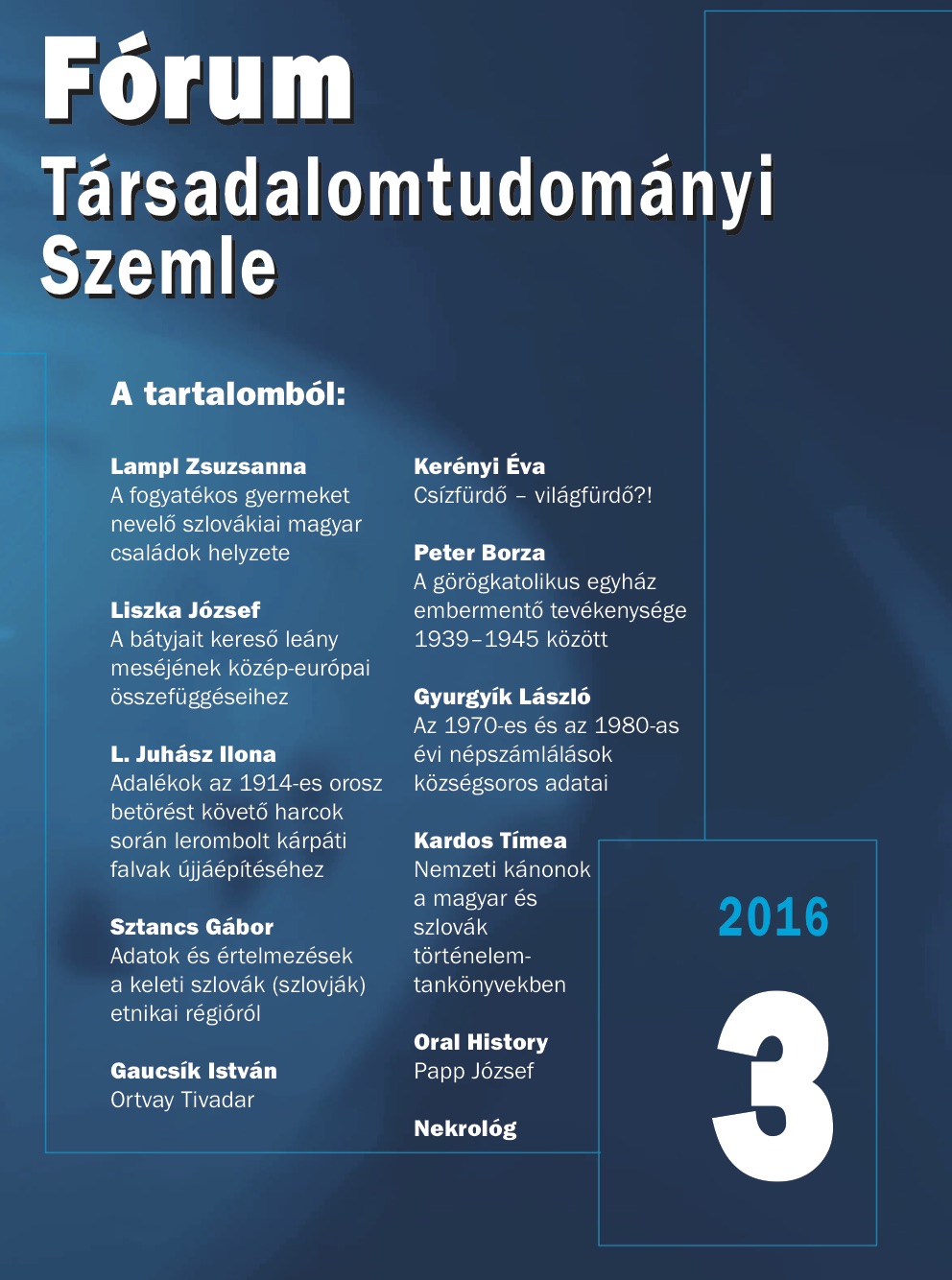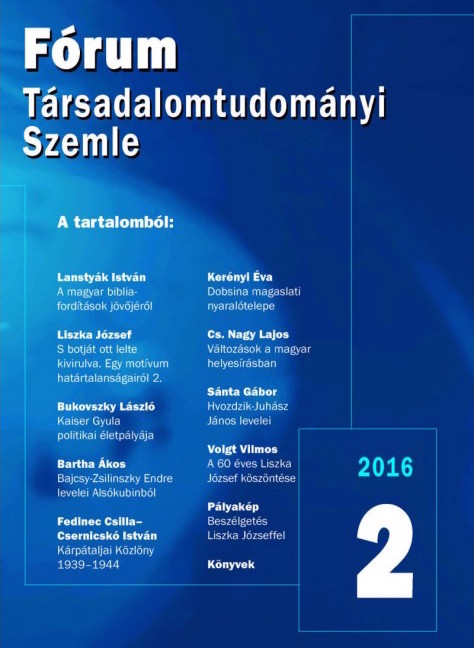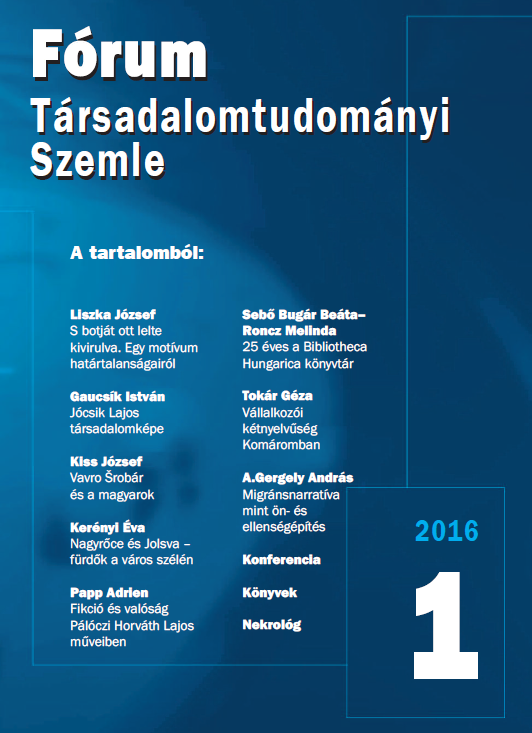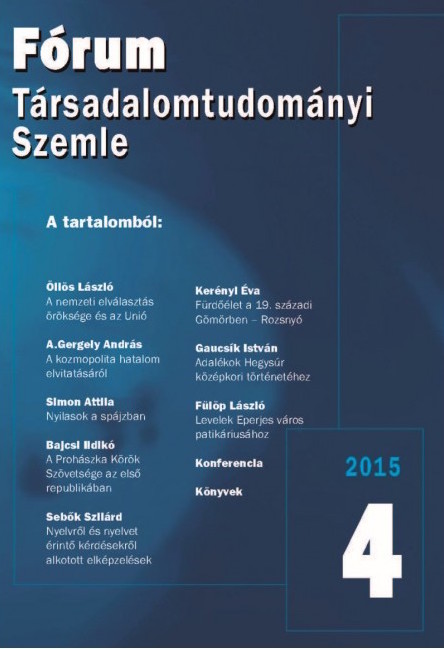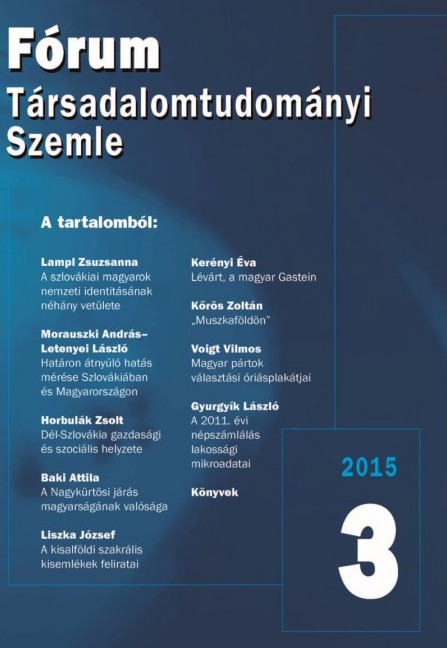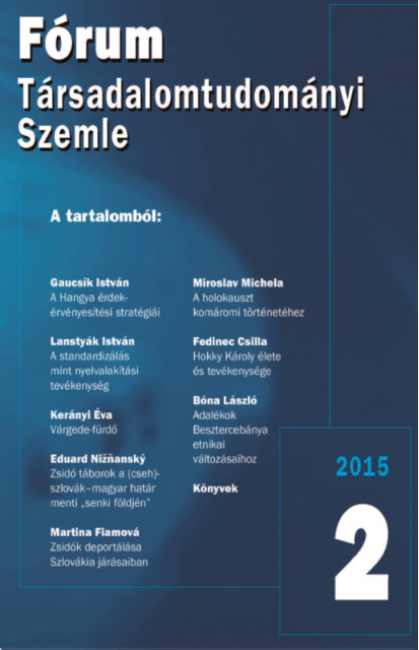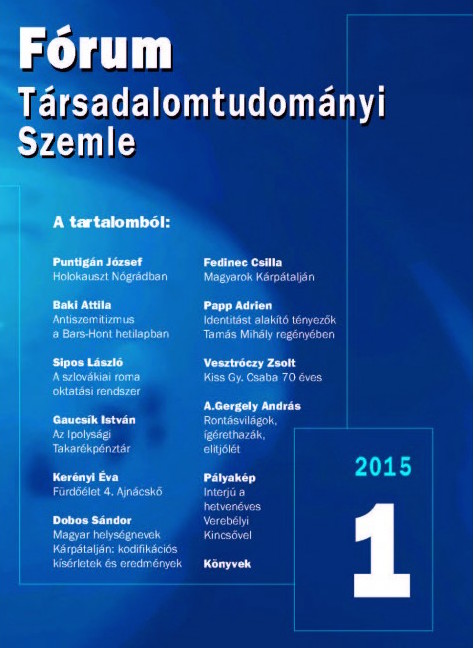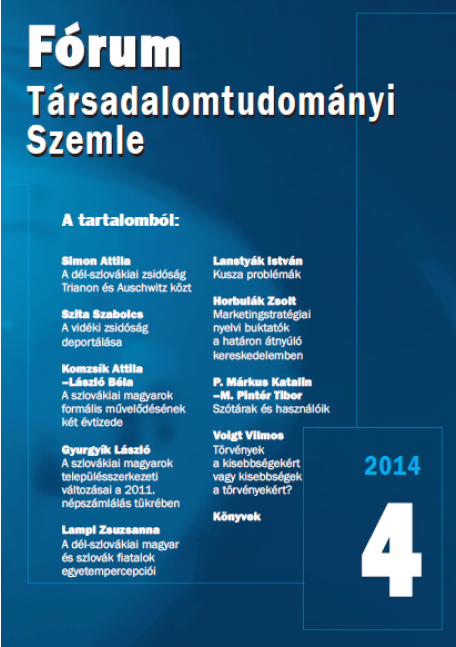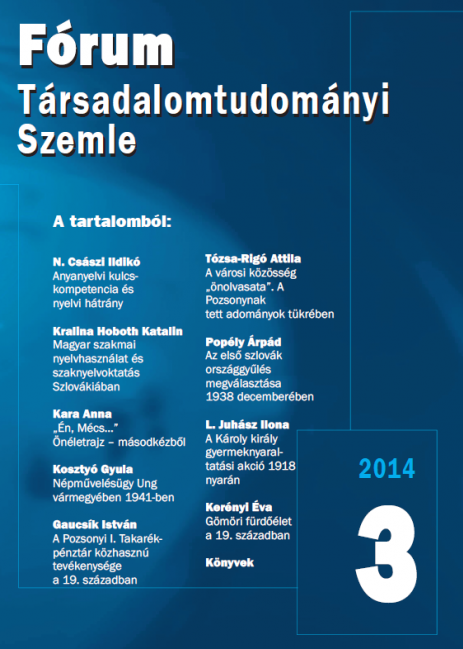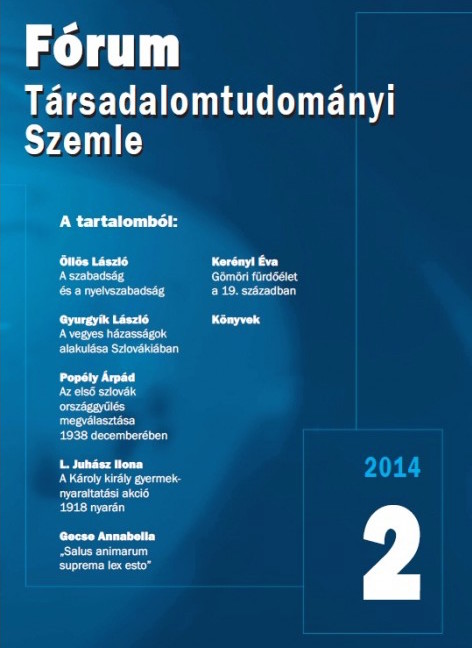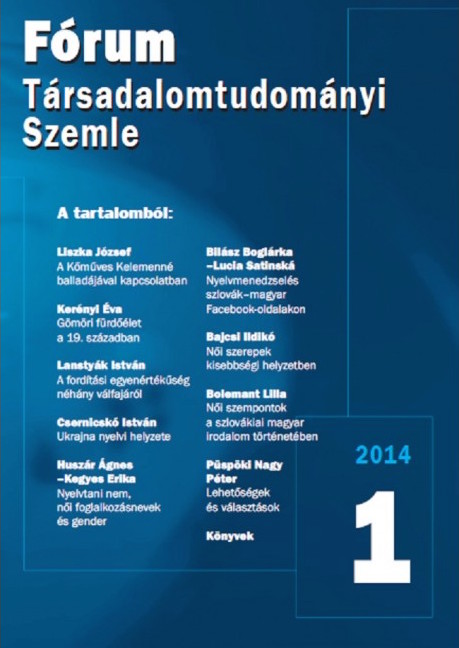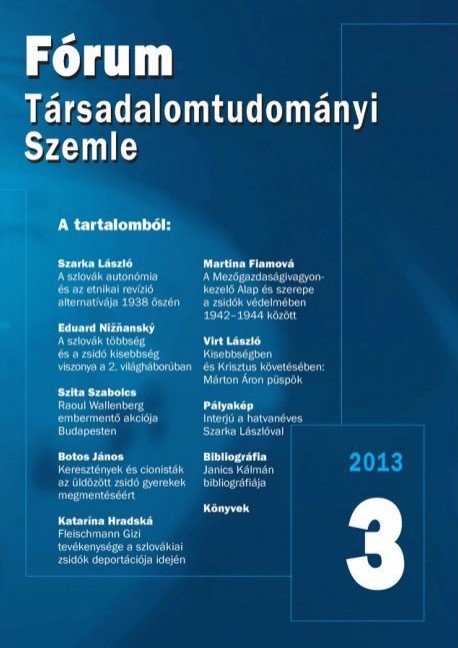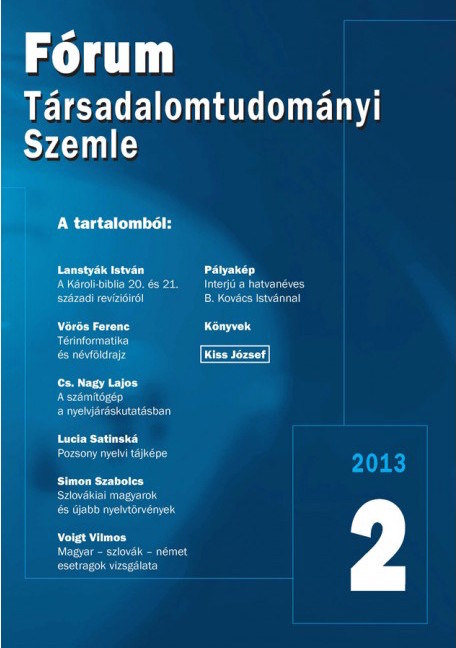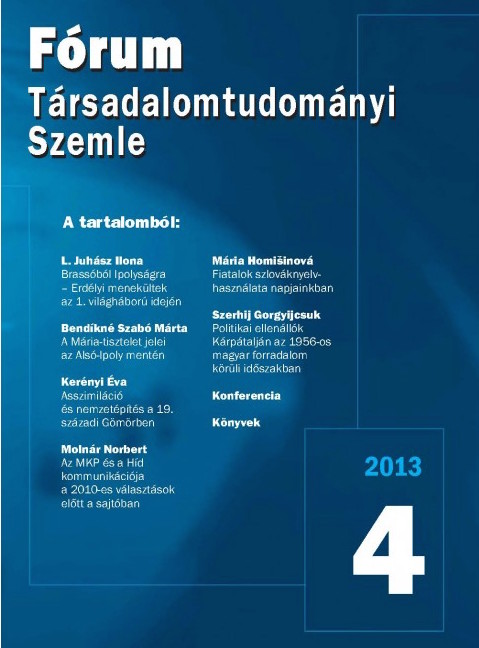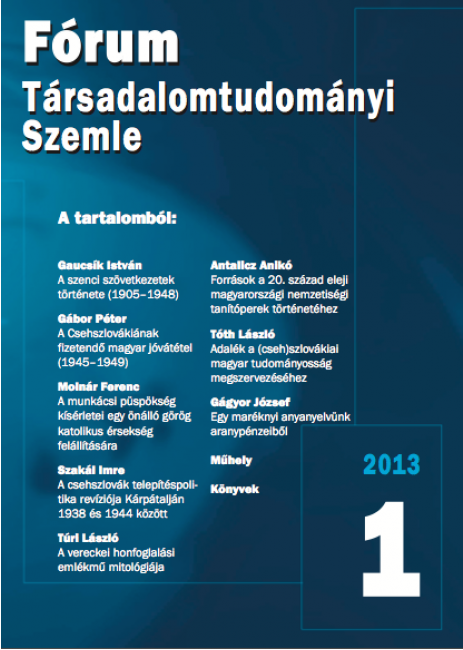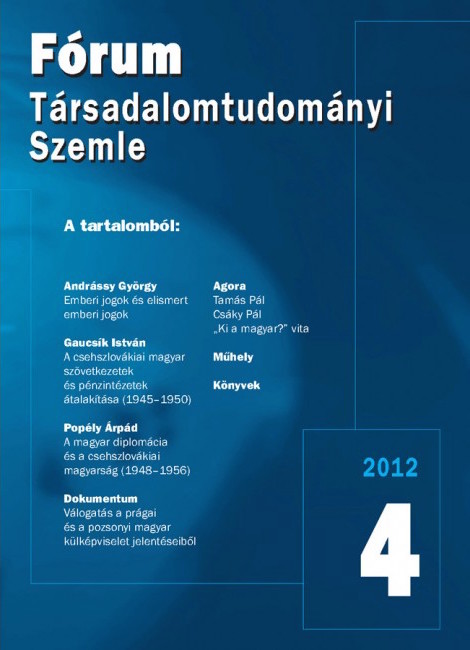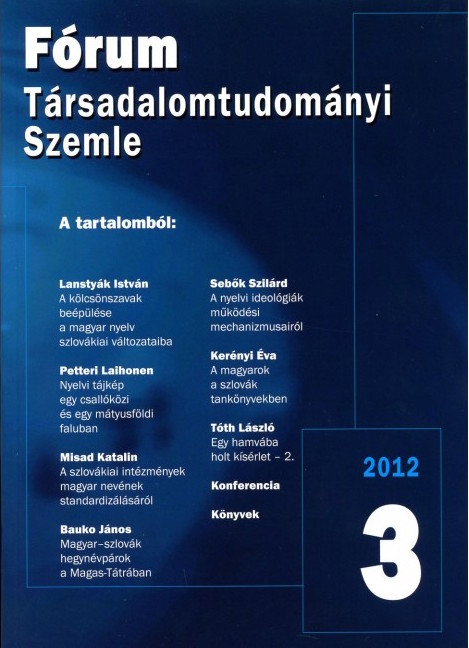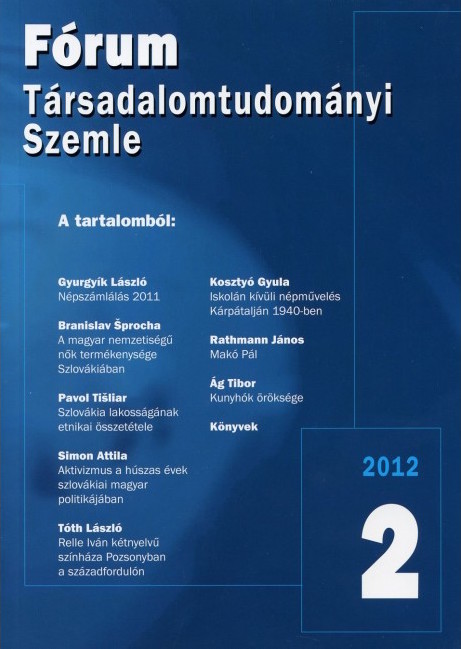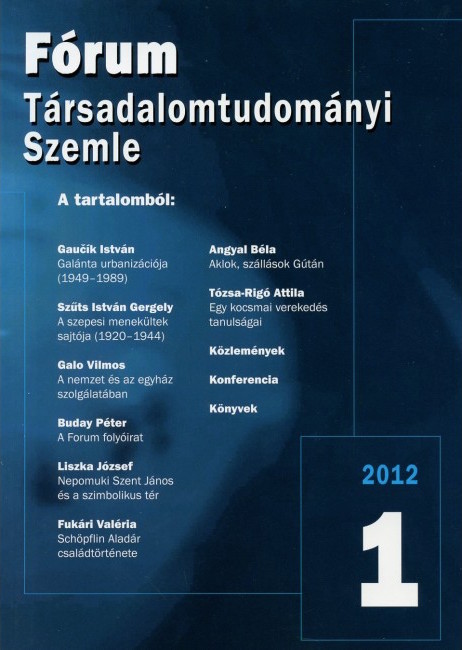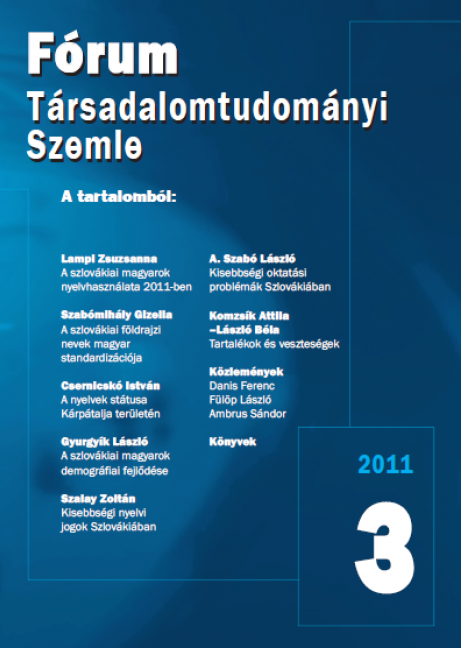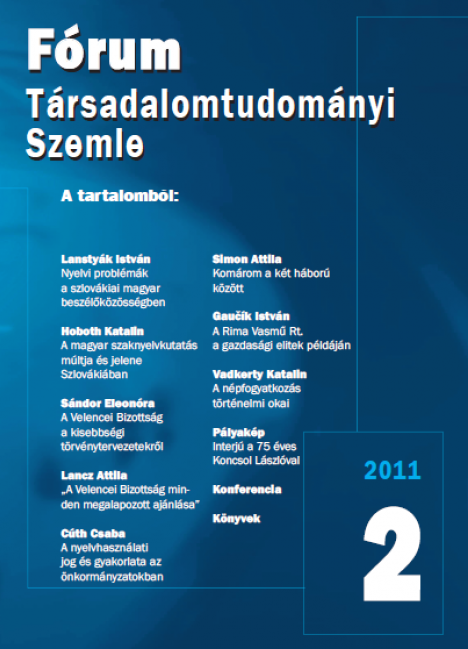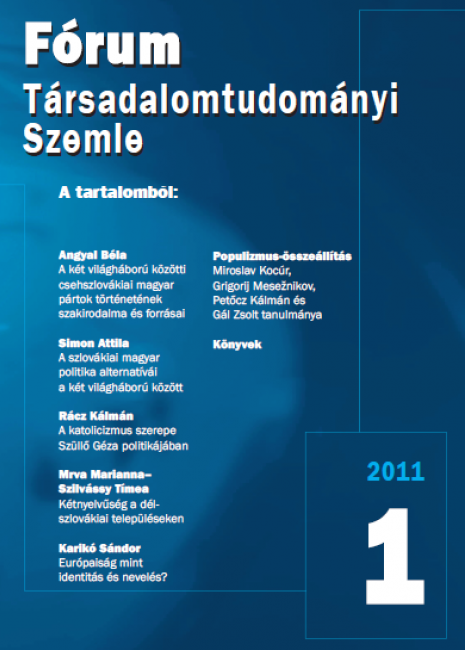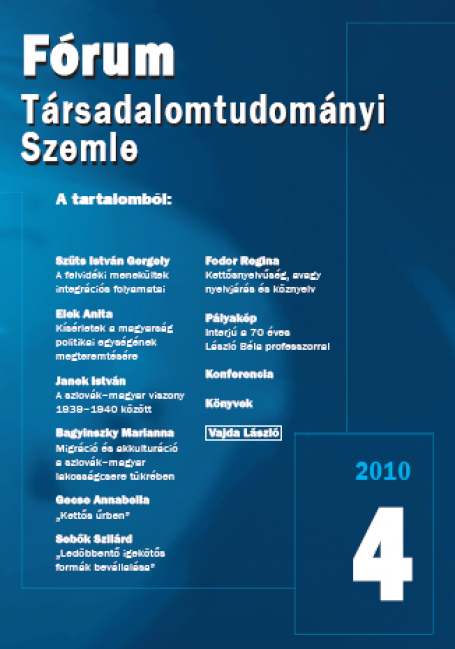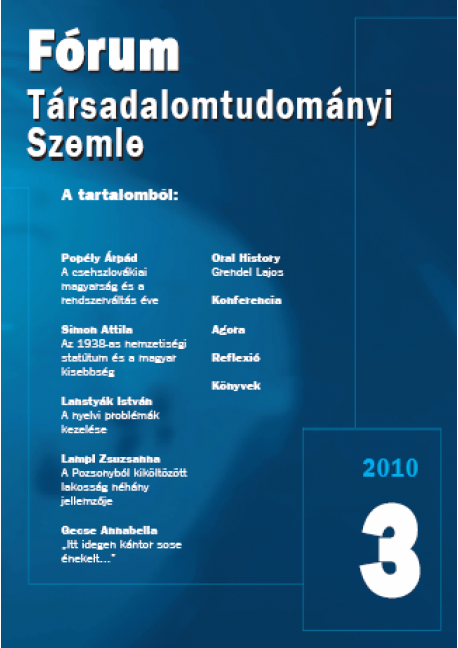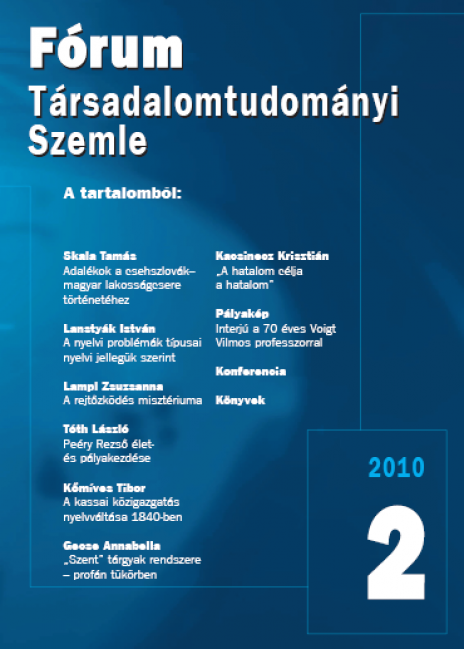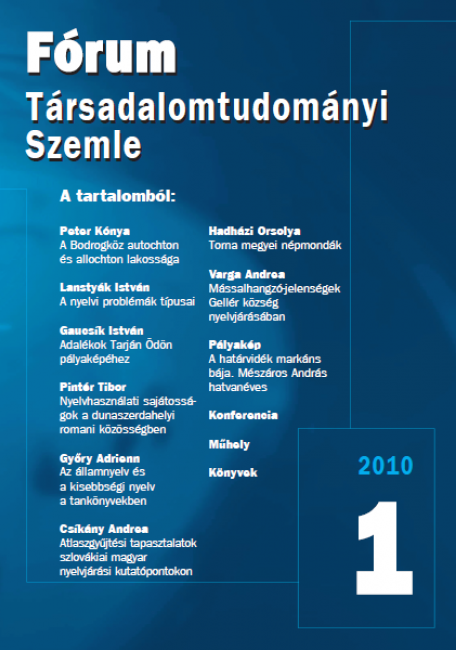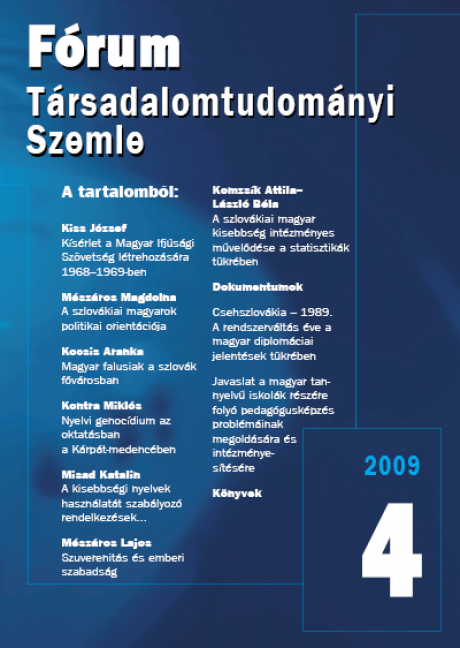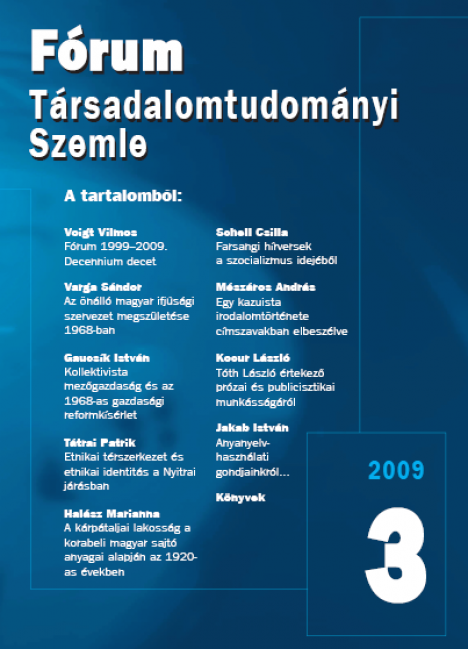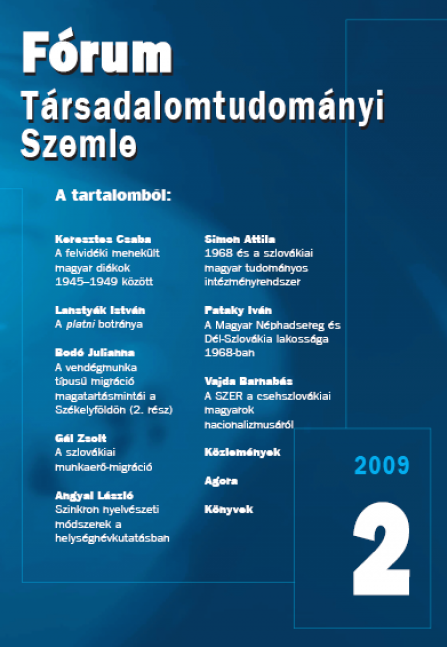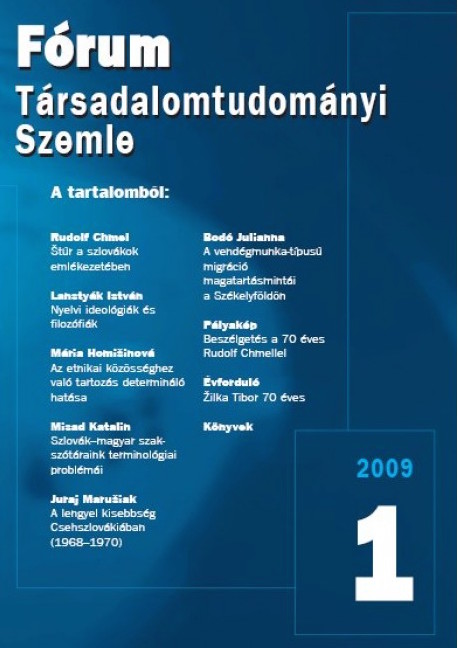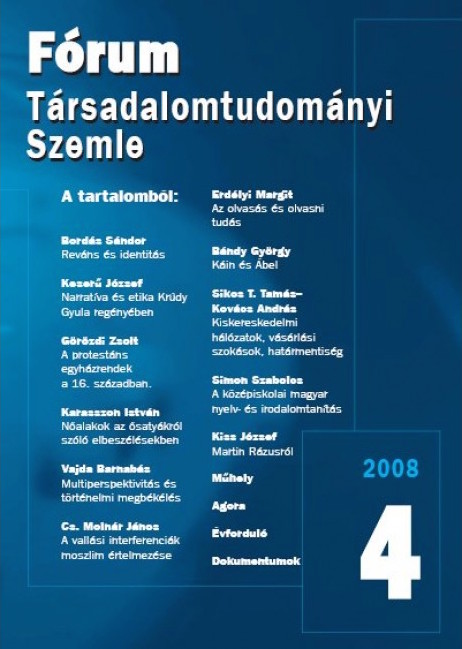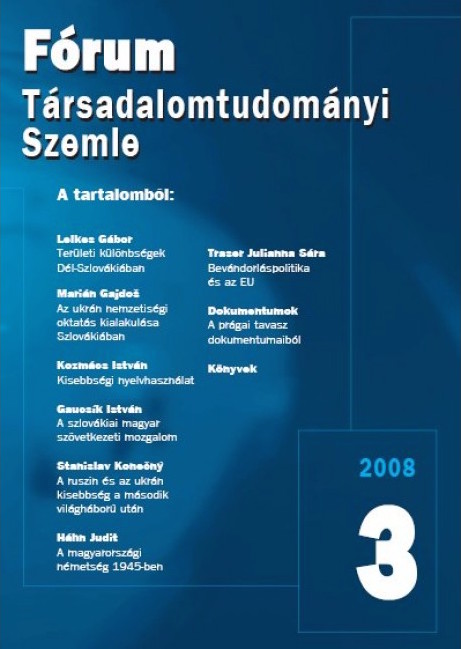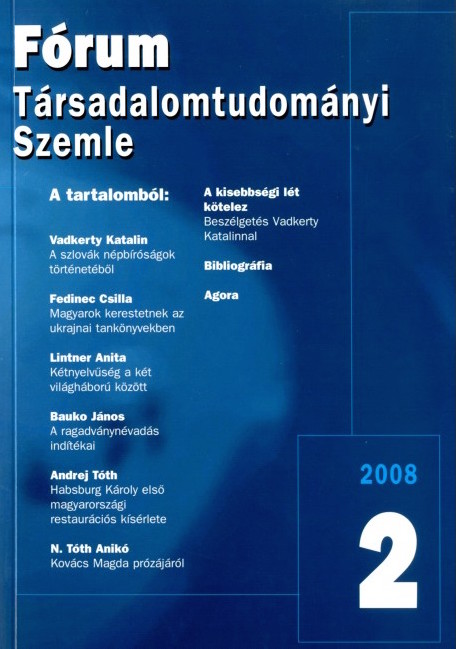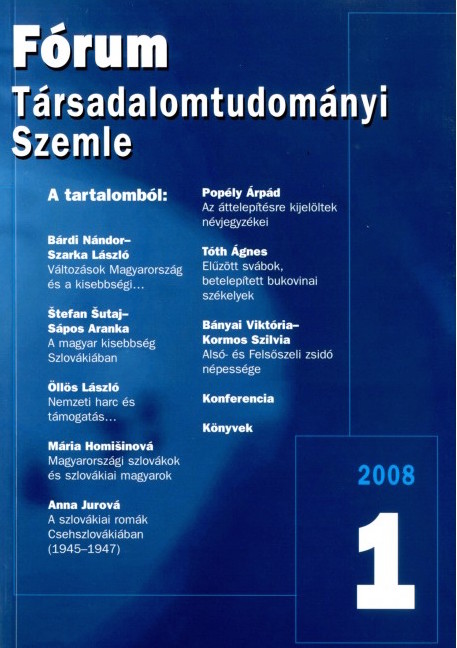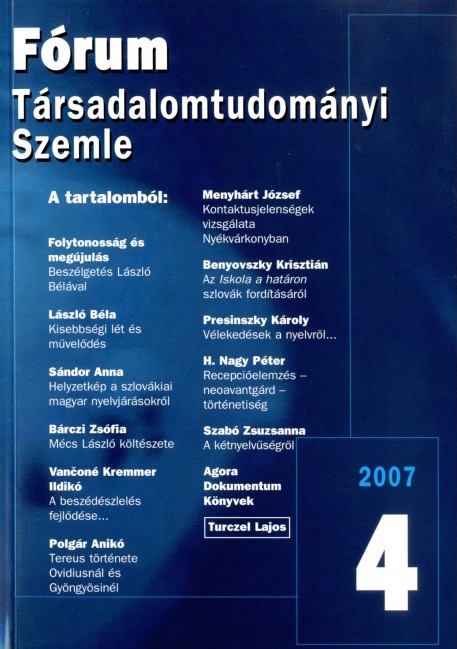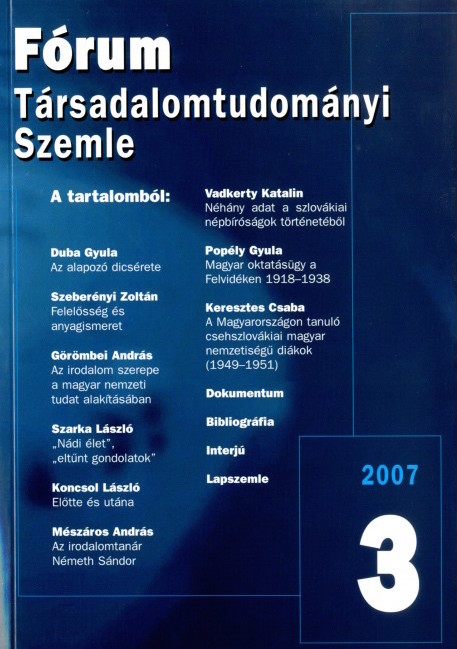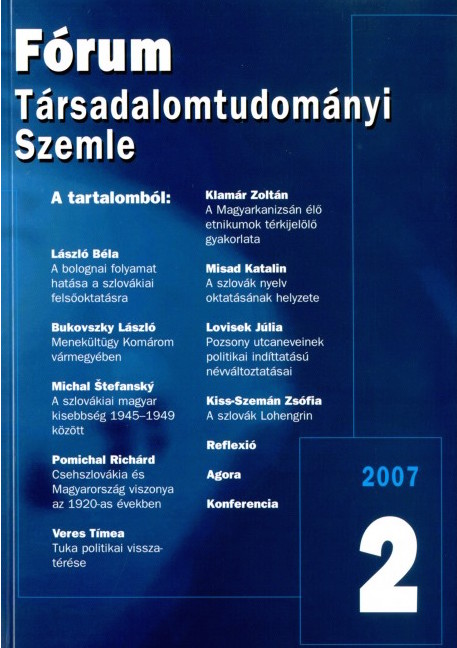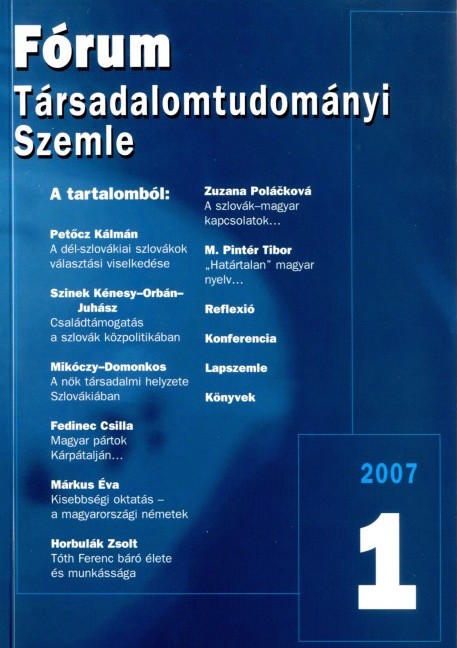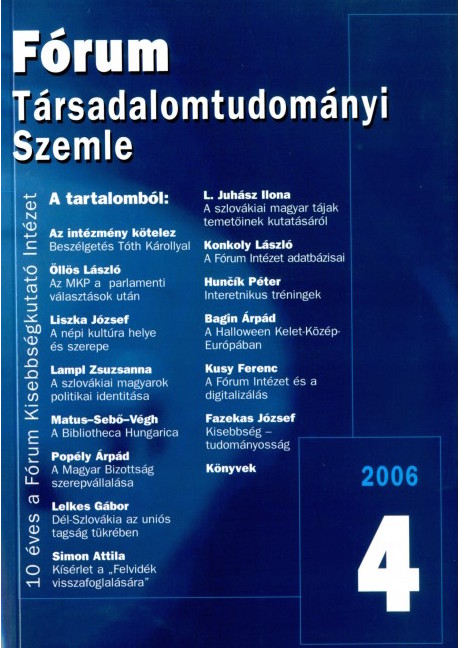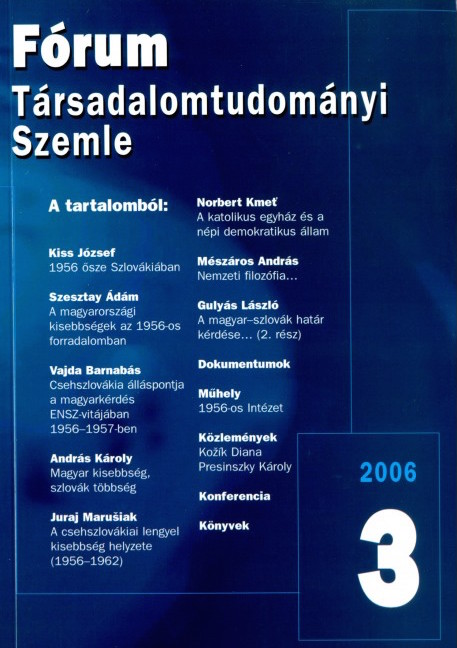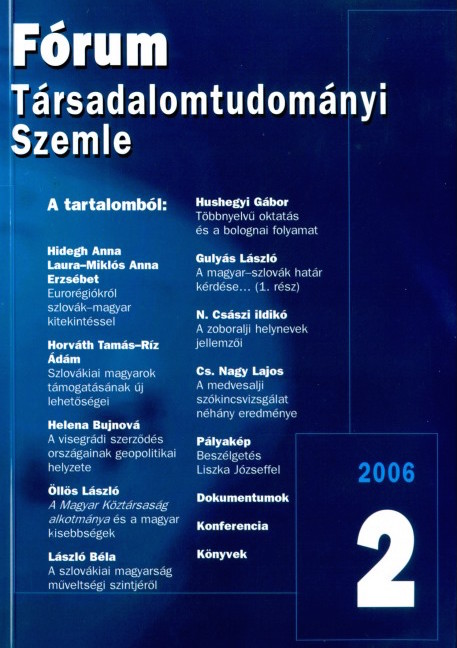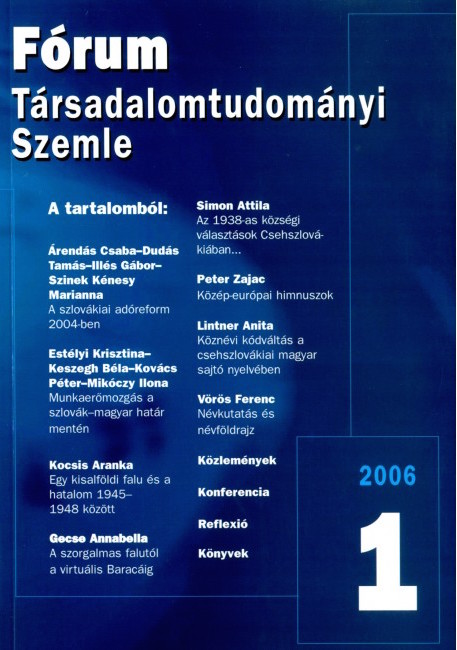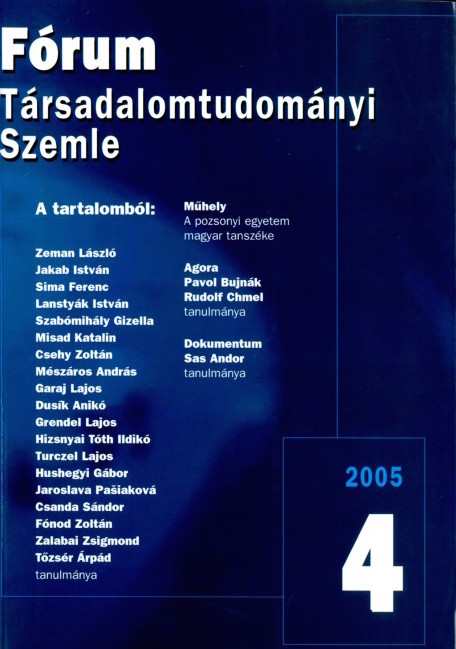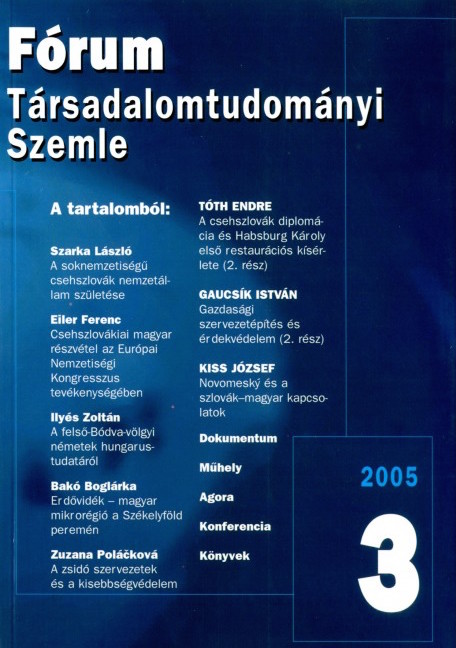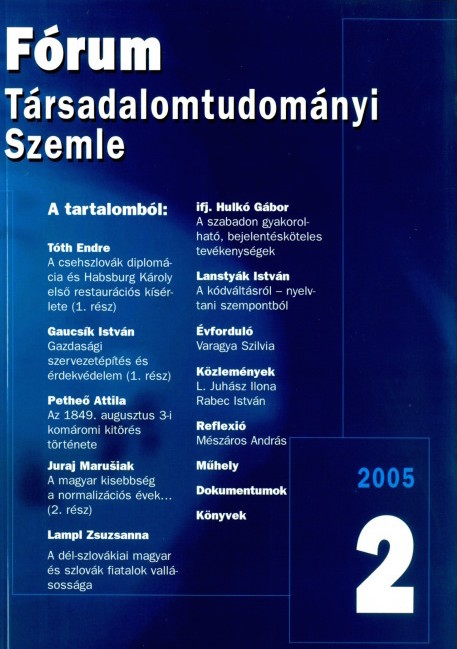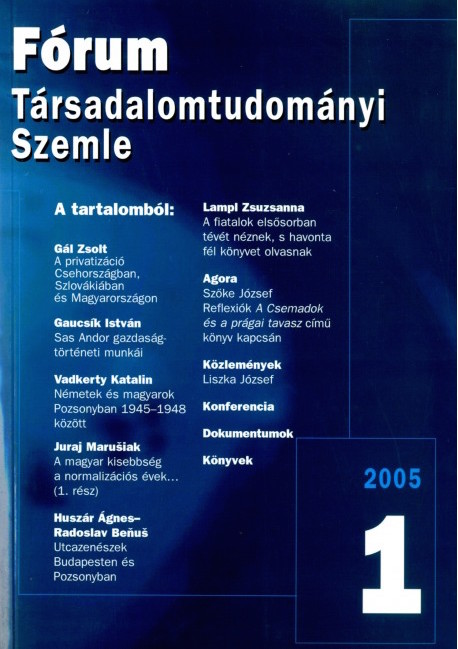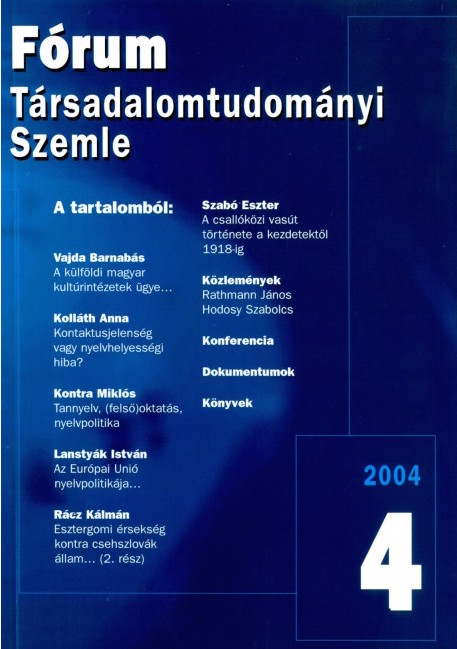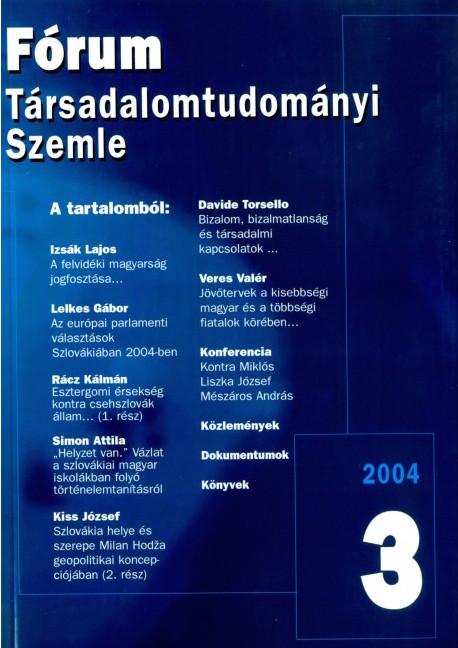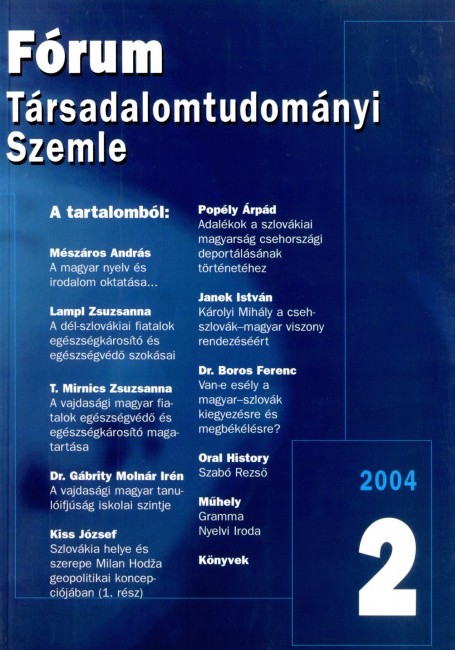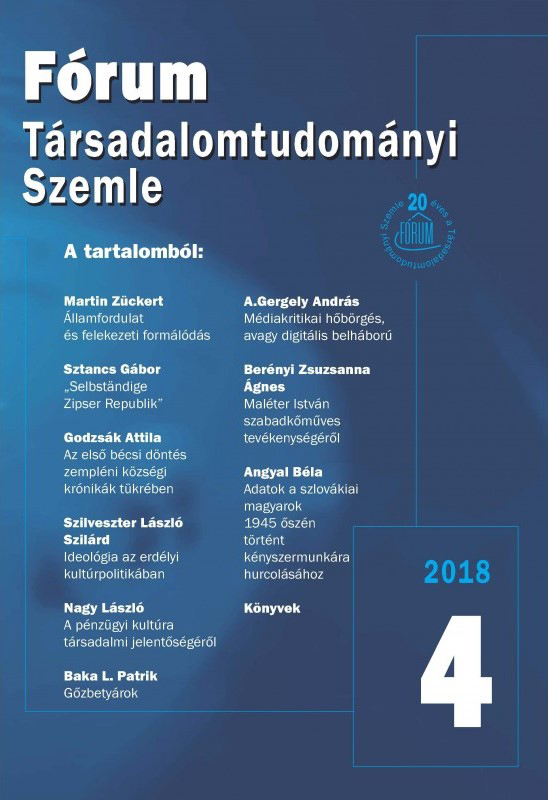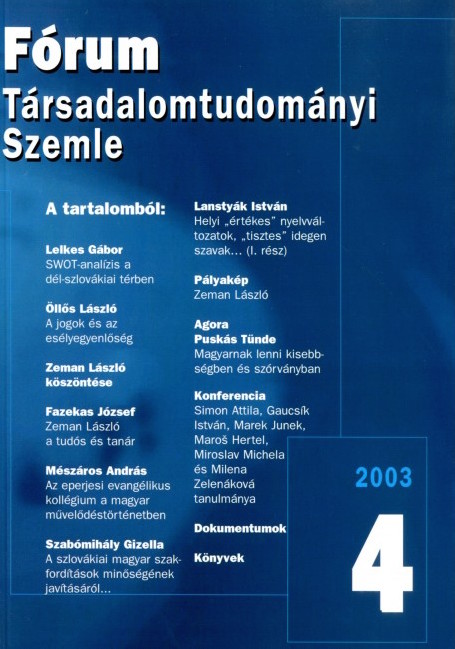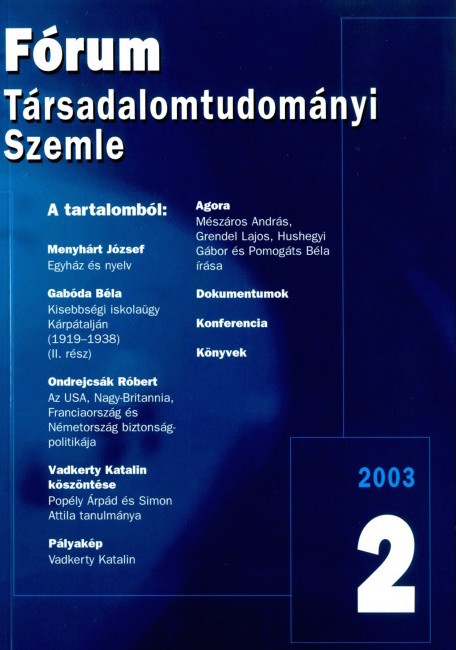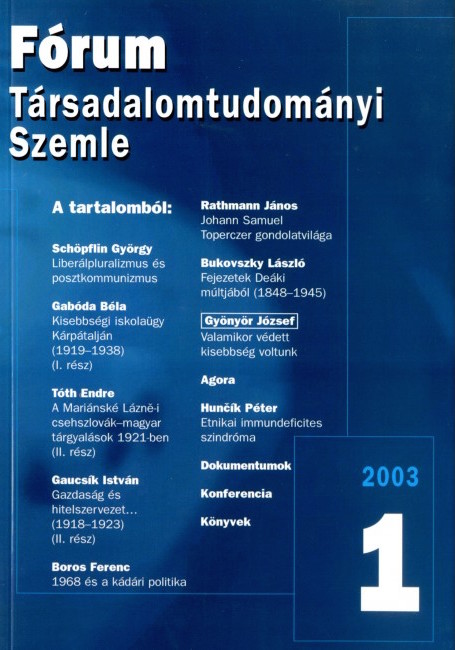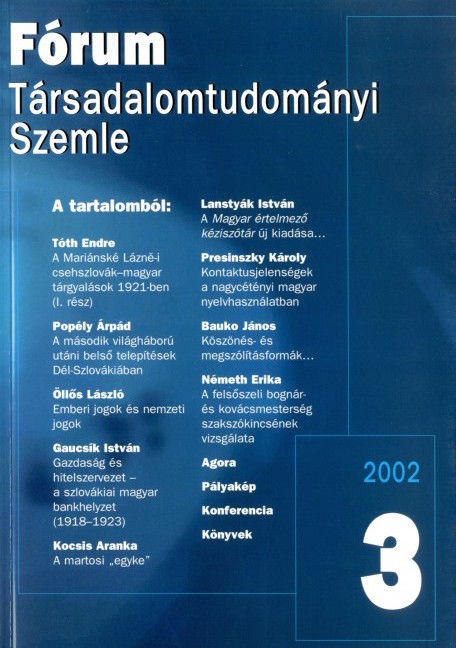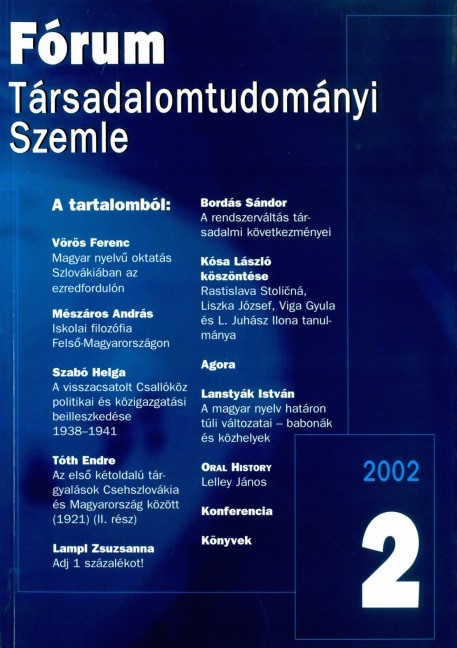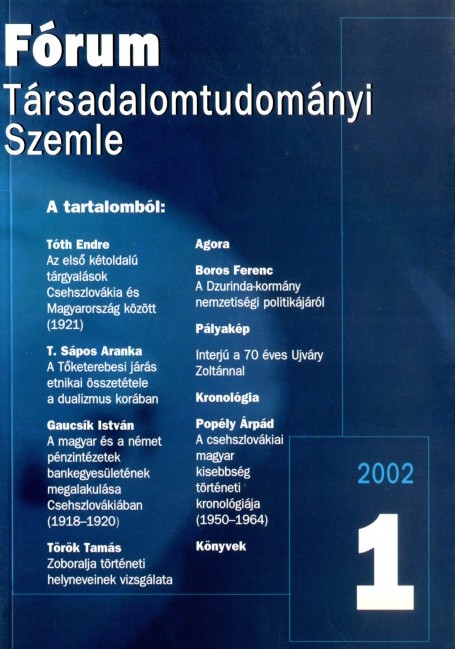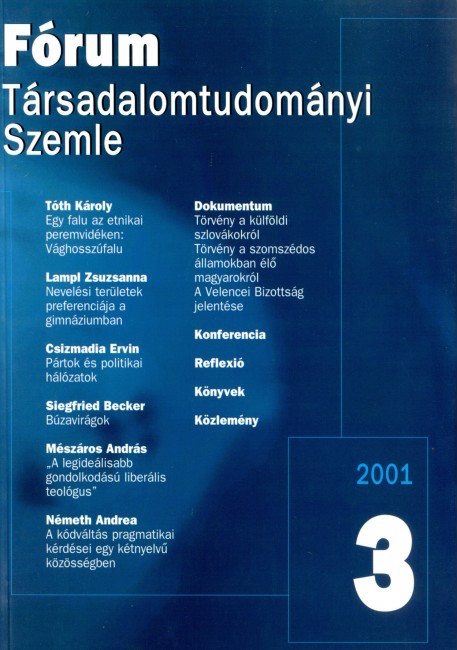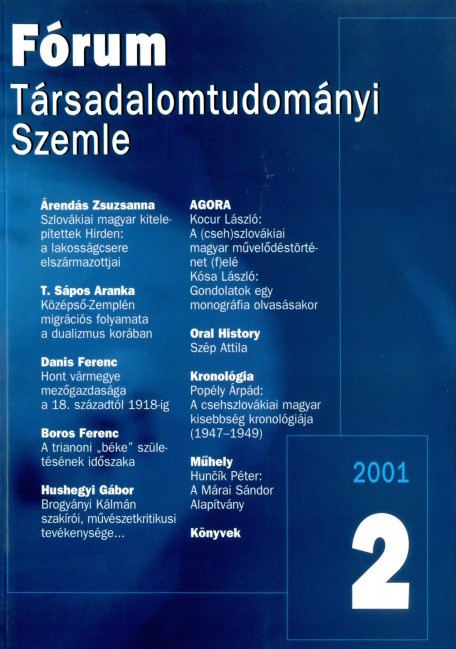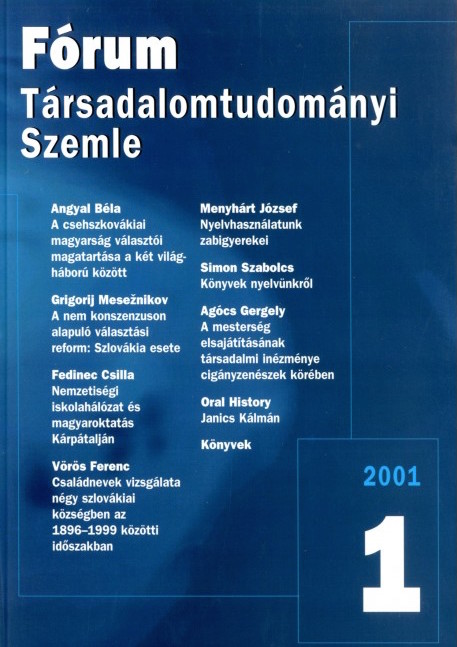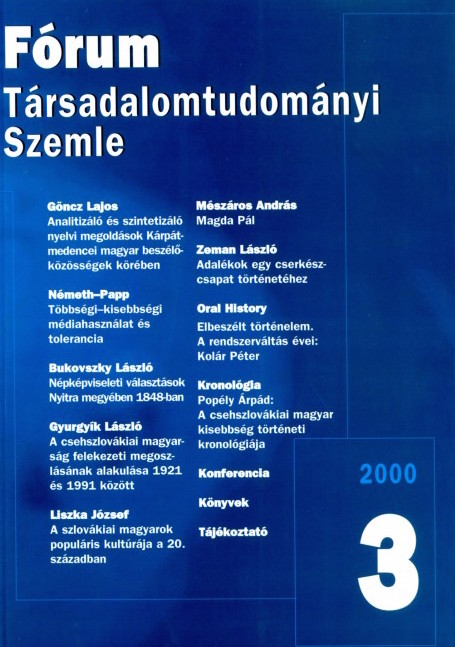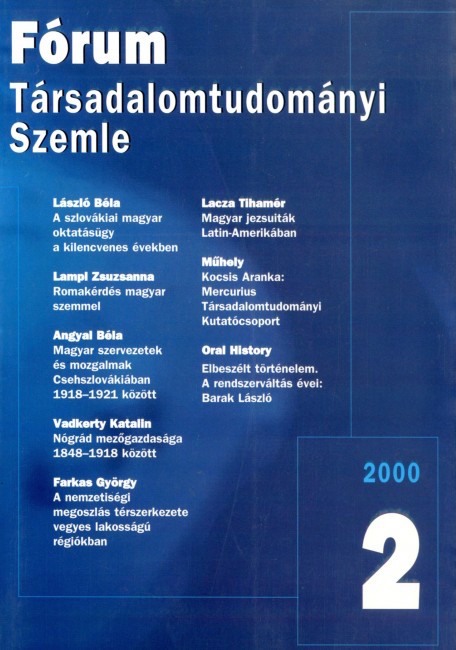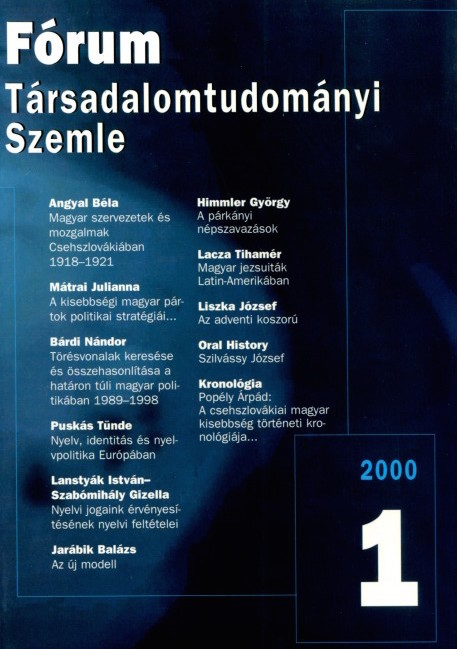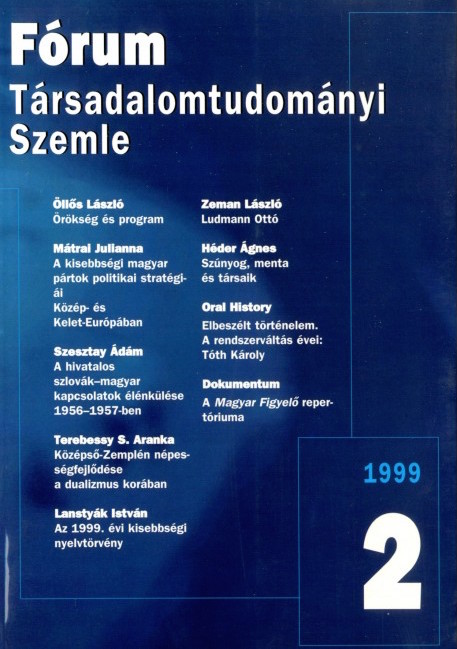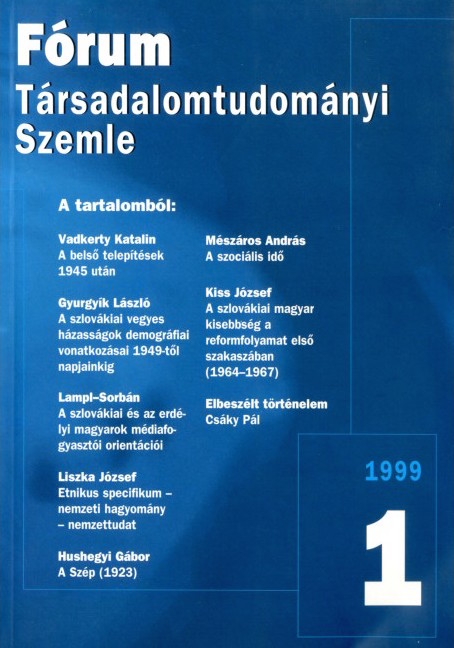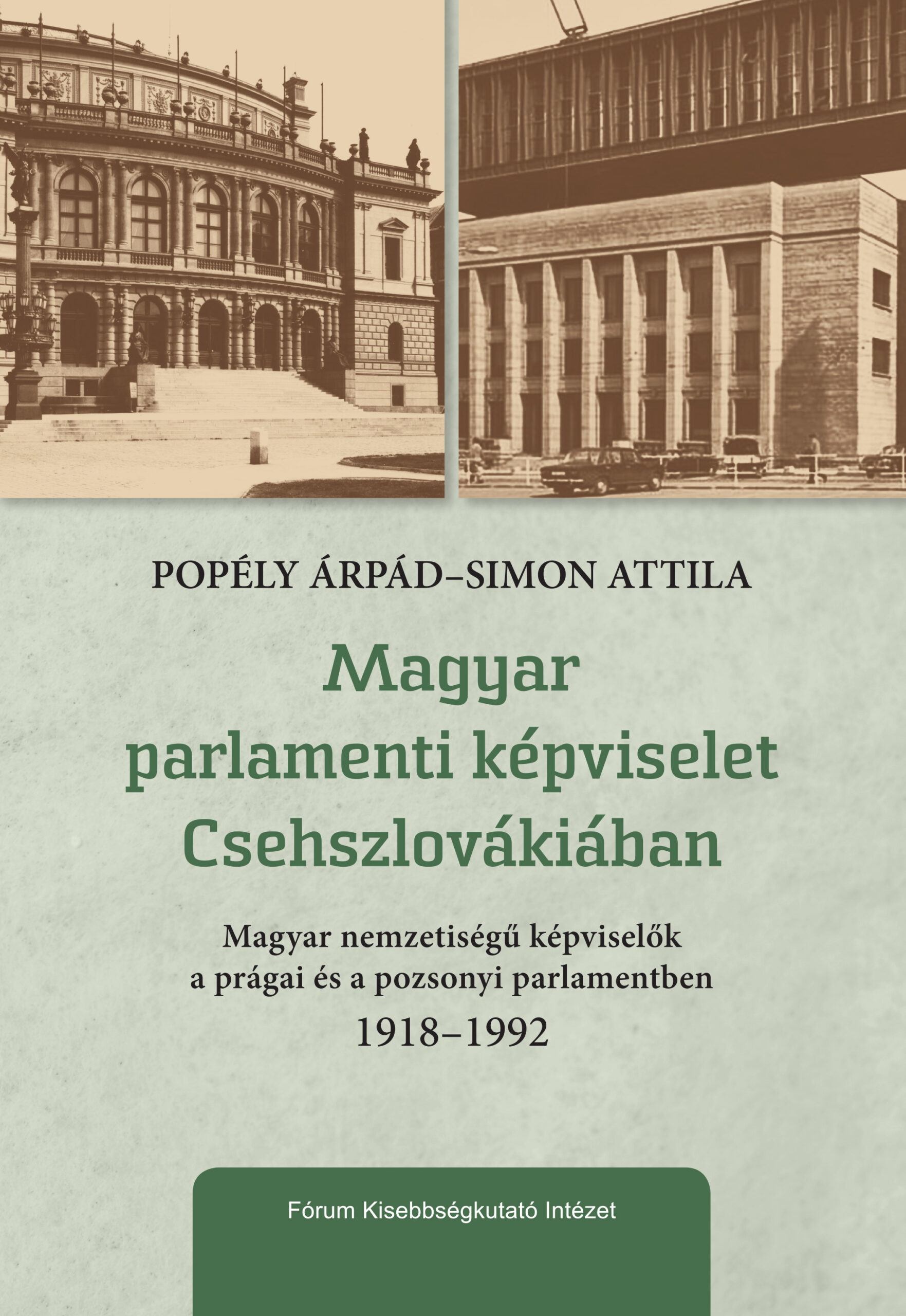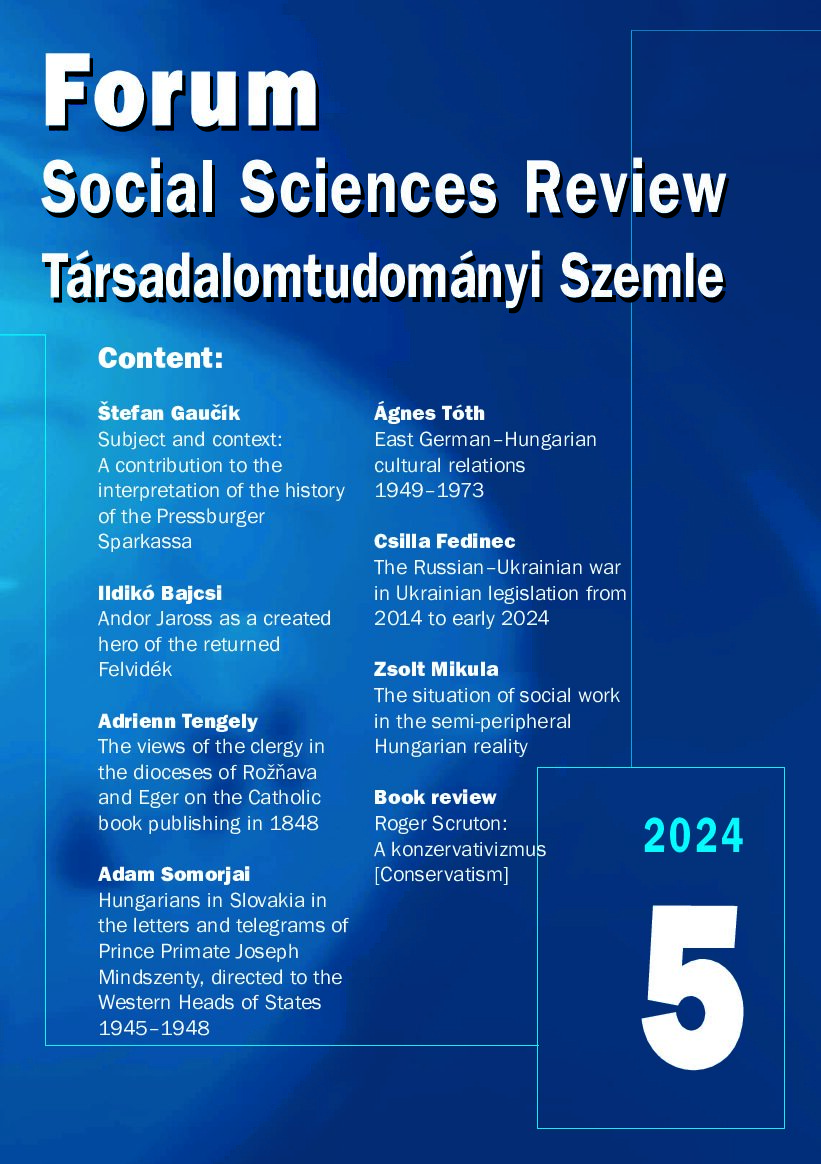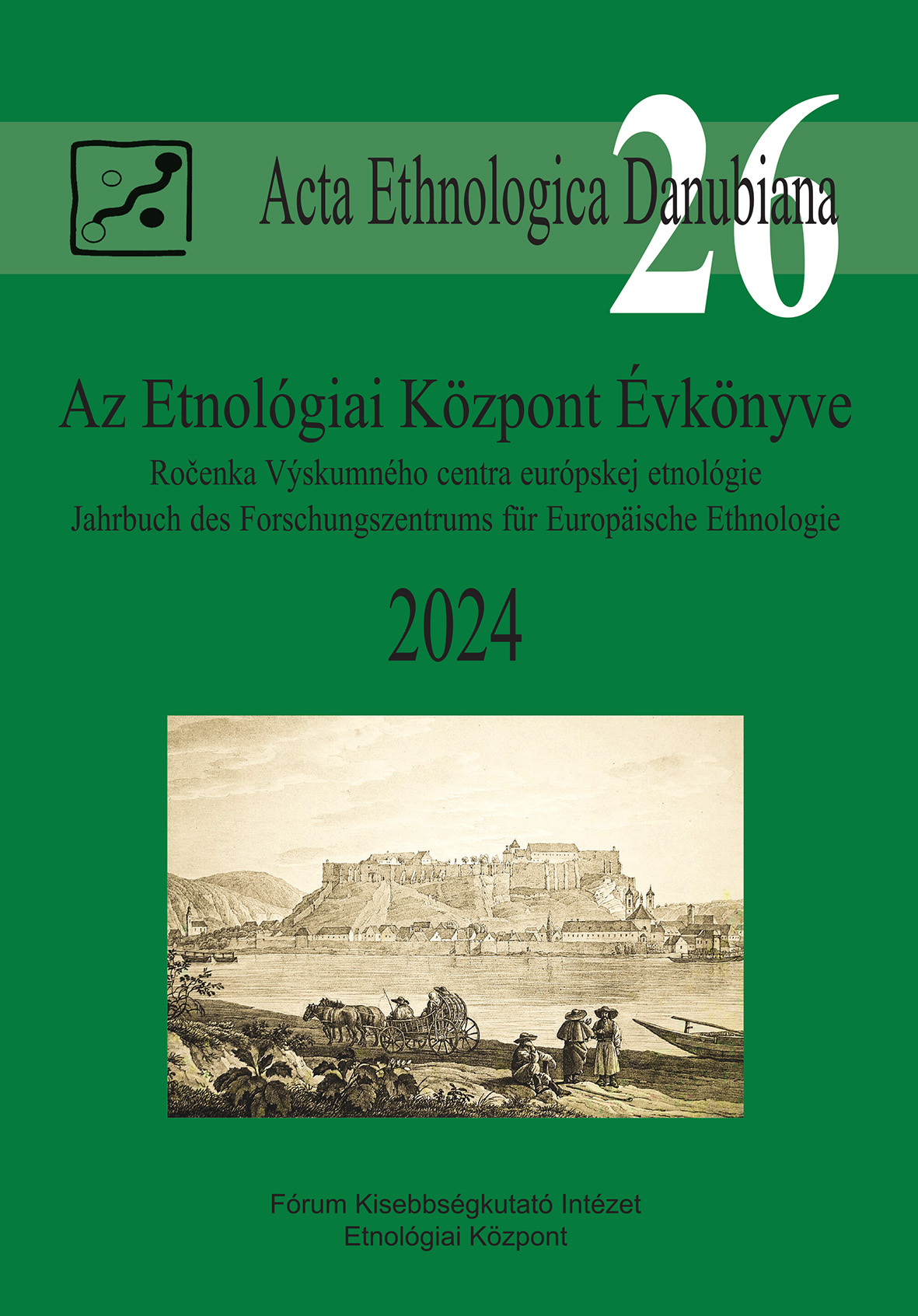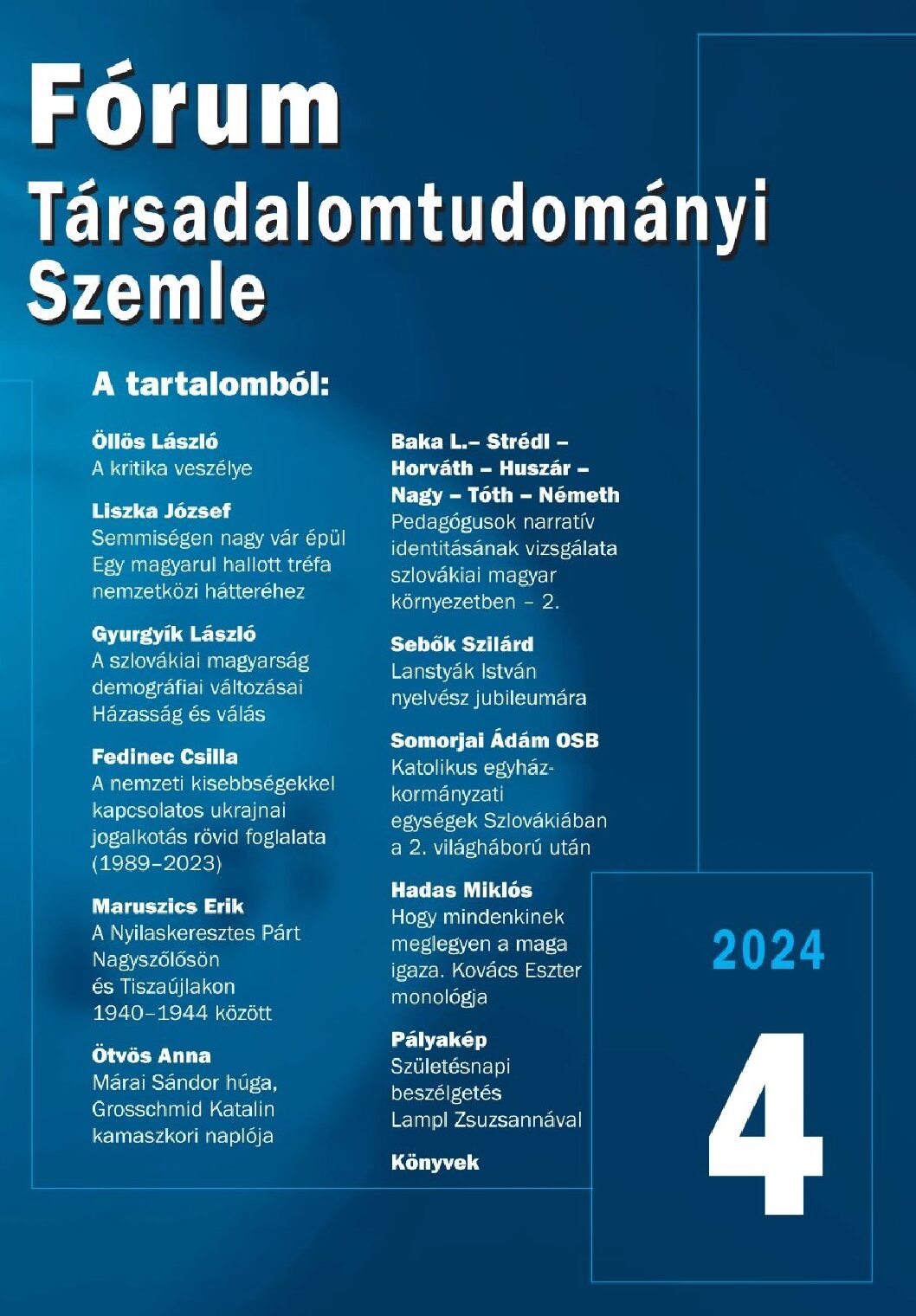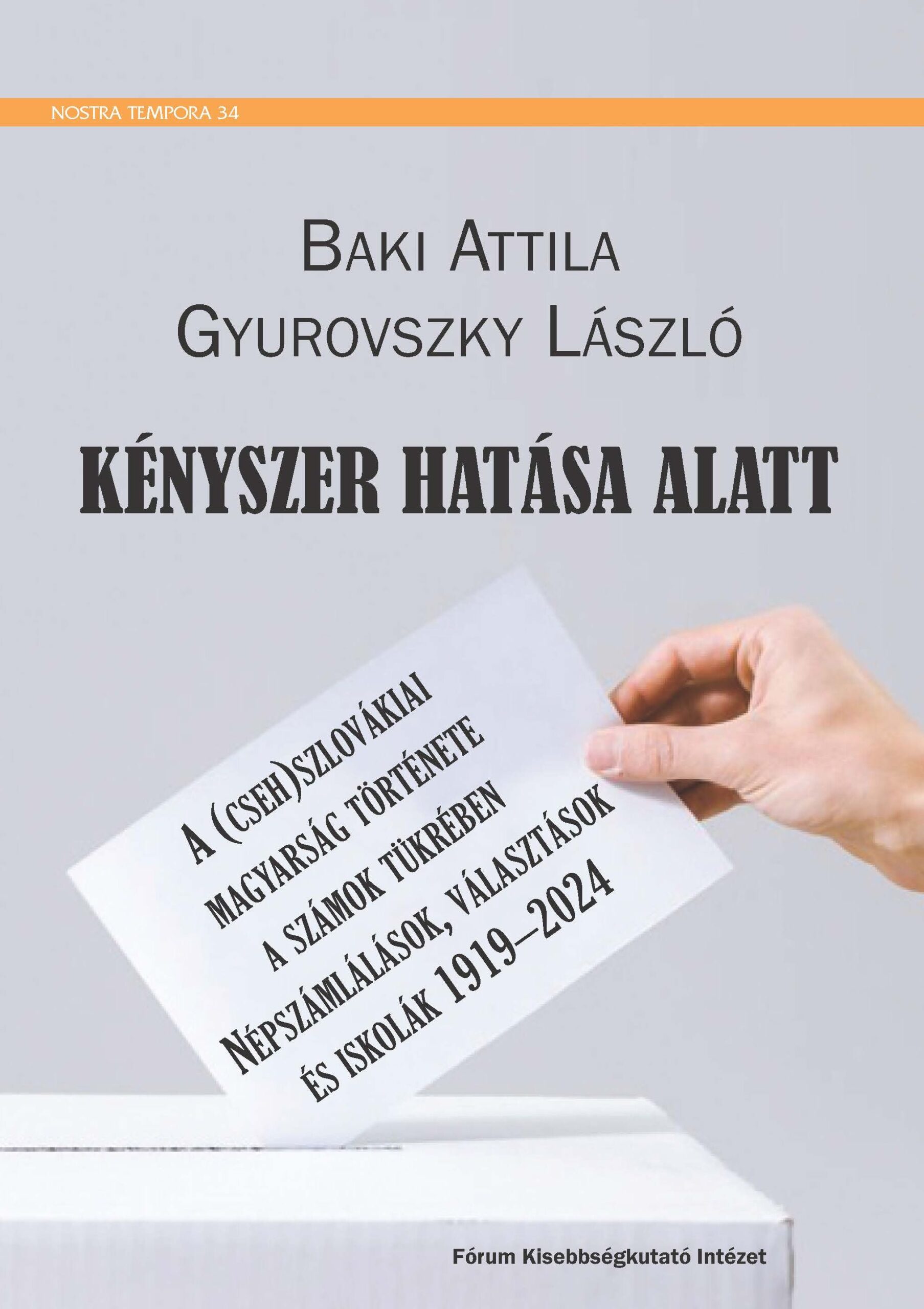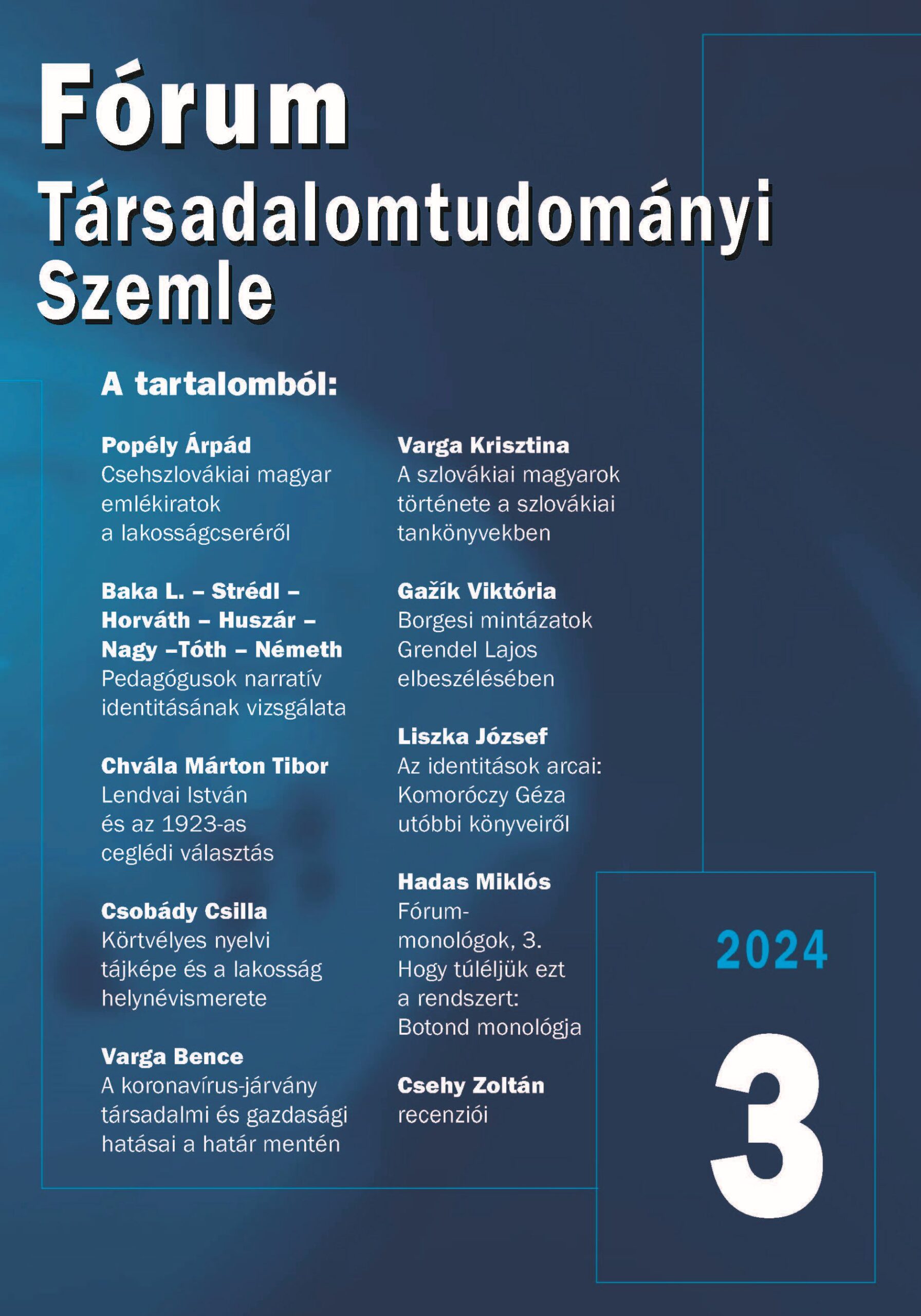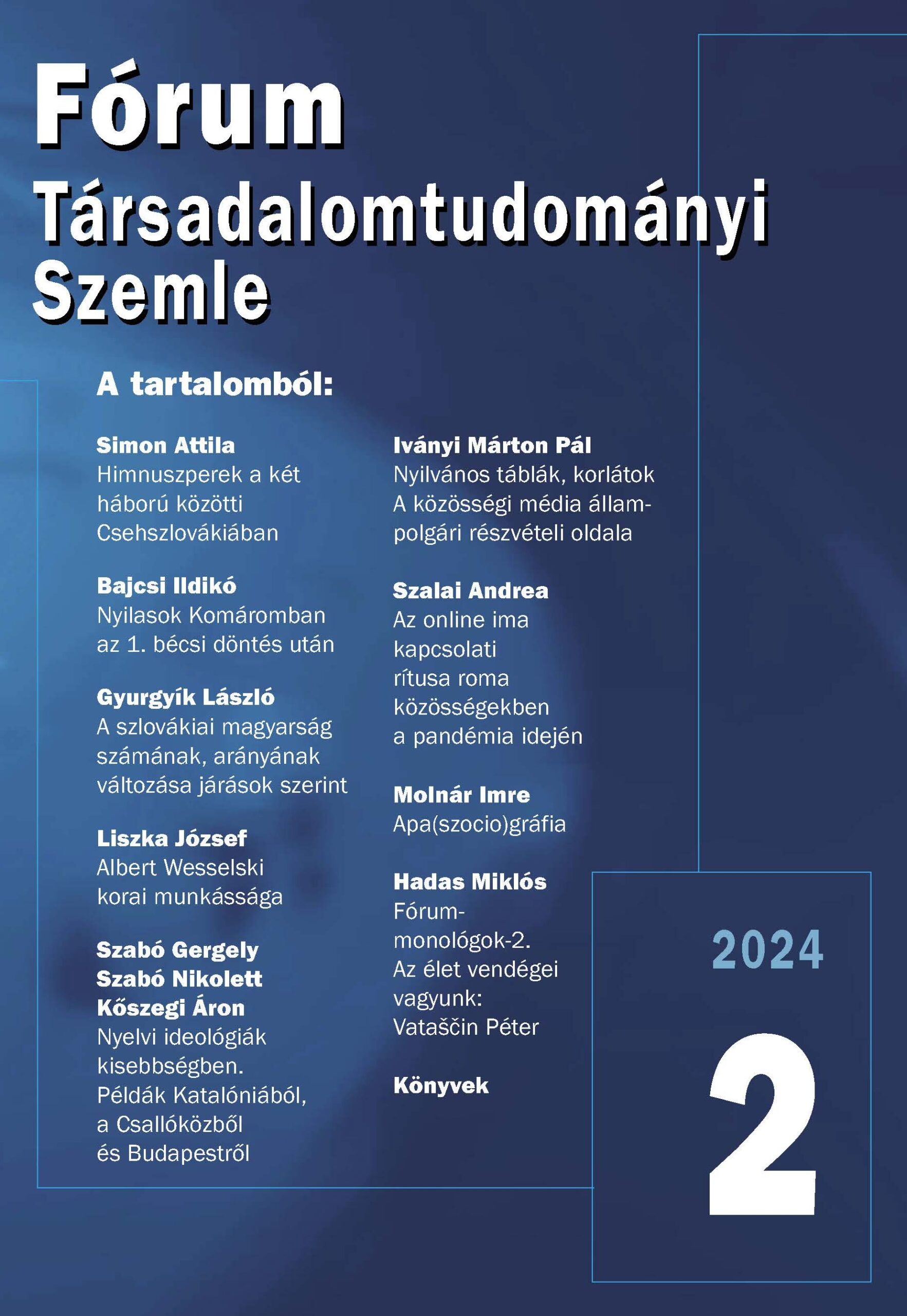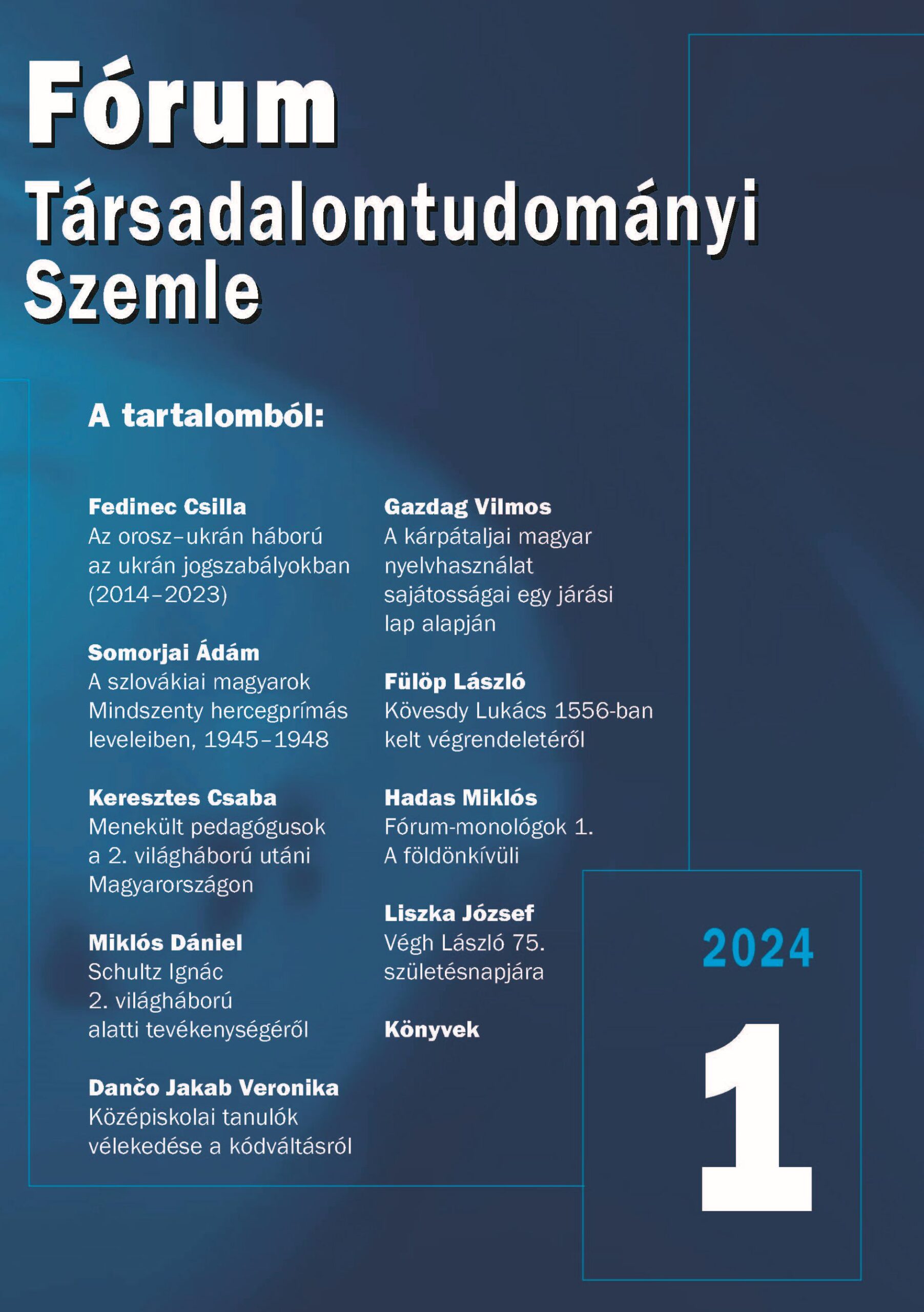Imprint 2022/5
FÓRUM TÁRSADALOMTUDOMÁNYI SZEMLE
FORUM SOCIAL SCIENCES REVIEW
ANNUAL SCIENTIFIC JOURNAL IN ENGLISH LANGUAGE
Volume XXIV(2022)
Head of the Editorial Board: LÁSZLÓ ÖLLÖS
Studies
NOVOTNÝ, LUKÁŠ: “Unless all indications to now are lying, Czechoslovak domestic policy is on the path towards a gradual transformation of the nation state into a state of nations.” German Activism in the 1920s in the Reports of the Austrian Minister to Prague, Ferdinand Marek
CSERNICSKÓ, ISTVÁN – FEDINEC, CSILLA: The competition of languages in the Lingusitic landscape of Transcarpathia in Czechoslovak Republic (1919-1939): a partial analysis
GYURGYÍK, LÁSZLÓ: Quo vadis? The number of Hungarians in Slovakia based on nationality and mother tongue data of the 2021 census
MESTER, BÉLA: The Usage of the Common Sense in the Public Philosophy of European Modernity
Central European Forum
AKYÜZ, AHMET KAAN: Robert College During the Years of Conflict 1908-1918
BRHLÍKOVÁ, RADOSLAVA: Citizens or non-citizens – discrimination against the Russian minority in the Baltics
KOVÁCS, GÁBOR: New Wine in old bottle? Classical notions of political philosophy in a changed political reality
Book reviews
Kontra, Miklós – Borbély, Anna (eds.): Tanulmányok a budapesti beszédről a Budapesti Szociolingvisztikai Interjú alapján [Papers on Budapest Speech based on “The Budapest Sociolinguistic Interview”] Reviewed by Veronika Jakab Dančo
Kollai, István: Szlovákia királyt választ [Slovakia Elects a Monarch] Reviewed by László Öllös
Simon, Attila: Az átmenet bizonytalansága. Az 1918/1919-es i mpériumváltás Pozsonytól Kassáig [The Uncertainty of Transition: he “Change of Sovereignties” in 1918 and 1919, from Pozsony [Bratislava] to Kassa [Košice]] Reviewed by Gergely Bödők
Holec, Roman: Trianon – triumf a katastrofa [Trianon – Triumph and Tragedy] Reviewed by Attila Simon
Liszka, József (ed.): Monumentumok. Szakrális (és „szakrális”) [Monuments. Sacred (and “sacred”) small relics in the Carpathian Basin] Reviewed by Zoltán Magyar
“Unless all indications to now are lying, Czechoslovak domestic policy is on the path towards a gradual transformation of the nation state into a state of nations.” – German Activism in the 1920s in the Reports of the Austrian Minister to Prague Ferdinand Marek
Introduction
With the end of the First World War in the autumn of 1918, the old European order collapsed. The start of this new era in Europe’s history also radically transformed the political map in Central Europe. The Austro-Hungarian Empire collapsed, and the so-called successor states were established on its foundations. On 28 October 1918, the Cze choslovak National Committee’s Proclamation of the Independence of the Cze choslovak State was issued, formally declaring the establishment of a new state entity, and the choice of a republic as its form of government was declared later, specifically on 14 November 1918. The new state inherited a complex legacy from its predecessor, the Habsburg Monarchy, with its state-forming Czechoslovak nation comprising only around two-thirds of the population, with the rest comprised of ethnic minorities—Germans, Hungarians, Poles, etc. Naturally, these groups did not want to live in the Czechoslovak Republic, rejecting its existence and arousing a negative response from representatives of the new governing majority. Following a strong initial rejection of any kind of co-operation, seen in the absence of minorities in the Revolutionary National Assembly, the first regular parliamentary election took place in April 1920, confirming not just the cooperation of Czechoslovak parties in government, but also the negative position that representatives of the minorities took regarding Czechoslovakia (Tóth – Novotný – Stehlík 2012: 37-39; Rašková, E. 2016: 27-36).
Although Bohemian, Moravian, and Silesian Germans considered themselves to be a part of the German nation, they were unsure about whether to join Austria or Germany. Once attempts at creating four separatist provinces collapsed at the end of 1918 and following signature of the peace treaties of Versailles and Saint-Germain (in June and September 1919 respectively), representatives of the German minority in Czechoslovakia realized that the international political situation prevented them from joining either Austria or Germany, and so they had to come to terms with the fact that they were to remain part of the Czechoslovak state. Furthermore, German political representatives had decided to avoid complicating relations with Czechoslovakia as much as possible, and Berlin’s policy was limited to supporting non-political acts during the 1920s.[2]
The Austrian Republic found itself in a different situation. As soon as it was established, the country was dependent on imports of coal, sugar, and other commodities from Czechoslovakia, and like it or not, its representatives had to accept a position of junior partner. The signing of the Treaty of Lány in 1921 and the provision of an international loan designed to help overcome the Austrian financial crisis in return for a commitment to reject any future Anschluss with Germany a year later steered Austria into calmer waters in terms of domestic political developments, while also affirming Vienna’s weaker position compared to Prague. (See more on this Konrád 2012 and The objective of this study is to analyze Austrian Minister to Prague Ferdinand Marek’s perception of German activism in the period from the election of November 1925 until two German ministers joined the Czechoslovak Government in October 1926. From his position as a diplomat, the Austrian Minister was only a passive commentator on political events in Czechoslovakia; on the other hand, it should be noted that he had a very good knowledge of the Czechoslovak domestic political scene.
Czechoslovak–Austrian relations were not particularly warm after the end of the First World War, and they did not improve until some time had passed after the signing of the peace treaty in Saint-Germain-en-Laye. In 1918, Ferdinand Marek became Austria’s diplomatic representative to the Czechoslovak Republic, initially as head of the Austrian Mission, with the official submission of credentials and his change in diplomatic rank to minister occurring on 11 April 1922 at the Castle Lány.[3] Because of his presence in Prague for many years, Marek became a real expert on the Czechoslovak political situation, and he also established warm relations, for example, with President Tomáš Garrigue Masaryk (from now on abbreviated as TGM).
A turning point in terms of German political activism was the parliamentary election that took place on 15 November 1925, which transformed the balance of power in Czechoslovak politics. The strongest members of the German party spectrum comprised supporters of the activist concept of cooperation (see more on this in Kracik 1999) represented by the Farmers’ League (Bund der Landwirte; further abbreviated as BdL) and the German Christian Social People’s Party (Deutsche Christlichsoziale Volkspartei; further on abbreviated as DCV). The Farmers’ League achieved its best ever result, winning 571,198 votes, giving it 24 seats,[4] while the Christian Social People’s Party received 314,440 votes and 13 seats. Both of these parties owed their good results to the diminishing popularity of German negativism, which had become politically much weaker by the mid-1920s. The German Social Democrats had to settle for 411,040 votes and 17 seats. (Tóth – Novotný – Stehlík 2016: 662-663) Based on the election results, the so-called all-nation coalition of Prime Minister Antonín Švehla was set up, or rather continued to rule, on 9 December 1925. This was comprised of Czechoslovak political parties, but it was unable to last even to the following spring, and due to the premature departure of the Social Democrats and the National Socialists, it was replaced on 18 March 1926 by Jan Černý’s bureaucratic government. During the rule of this government of officials, a new coalition of civic parties was formed. For the first time since the end of the war, there was an opportunity to form a government without socialist parties in it based on the cooperation of parties not on the political left and including representatives of the German and Hungarian minorities. Cabinets up until this point had only ever been made up of Czechoslovak parties, whose programmes naturally differed and who were not natural coalition parties.[5]
The Austrian Legation and Ferdinand Marek naturally followed the Czechoslovak election of autumn 1925 closely. According to the minister, its outcome did not represent the anticipated resolution to the domestic political situation, rather marking a weakening of the governing coalition’s position. In the opening paragraph of his report to Foreign Minister Heinrich Mataja, Marek wrote that even four days after the election, not all ballots had been counted, and so he could not provide information on the exact number of seats for the different parties. However, he added that according to the unofficial results it was evident that “the rule of the ‘Five’[6] could not continue in its previous form because the five coalition parties were now in a minority in the Chamber of Deputies.”[7] He nevertheless rejected the idea of a bureaucratic government and expected that the current arrangement of parties would continue, not anticipating that German politicians would join the government benches. On the other hand, he acknow ledged that supporters of a moderate approach towards the Castle[8] and government would now have the most say. “The efforts of President Masaryk and Dr Beneš to bring about a situation in which it would finally be possible to invite the Germans into the government and form a cabinet with broader political support could now be successful, especially considering that the greatest opponents to the idea, Dr Kramář and the National Democrats, are weaker in the new parliament, having lost five seats. Dr Beneš is going to have to deal with increasing hostility from the National Democrats,” concluded Marek in his assessment of Czechoslovakia’s November election.9
The Austrian Minister had correctly surmised future developments when he sug[9]gested the possibility of government cooperation with German political parties, naturally activist parties, and more specifically civic parties. The election results indicated that there was an opportunity to create a new government formation (in terms of its ethnic composition) compared to that which had governed the country since the first parliamentary election in 1920.
At the end of November 1925, Marek informed Vienna of the final election results, confirming his previous estimates—a decrease in votes for the Social Democrats (both Czechoslovak and German), consolidation for the Communists, and decline for the National Democrats. He again noted the failure of the parties of the government coalition;[10] the election had resulted in the loss of their parliamentary majority, and Antonín Švehla would have to find a way to restore a majority. The Austrian Minister also wrote that it was mainly Edvard Beneš who was blamed for the collapse in votes for the government parties, having allegedly pursued the “policy of the streets,” and whose reckless approach towards the Vatican had led to an increase in votes for Catholic parties. Marek added that the foreign minister allegedly had to promise Antonín Švehla that he would stop interfering in the internal affairs of political parties and would focus on his own department. The minister noted that the government would have to rely on a small parliamentary majority and then focused on potential ministerial appointments.[11] In his assessment of the result for the German parties, Marek correctly noted the increase in votes for BdL, but in his assessment of German activism and possible government cooperation, he expressed some scepticism. He particularly criticised the inability of the German parties to agree on joint actions and approaches in parliament, something he considered extremely important for future developments.[12]
Ferdinand Marek’s first post-election comments did not suggest the possibility of German activist parties participating in government: the minister does not even mention the option in the above-described report. On the other hand, it was too early for any major steps from the German political parties. While theoretically the election results allowed for the formation of a center-right coalition, on the other hand there were several still unresolved problems (e.g., the Language Act implementing regulation)(see more on this Kučera 1999) that would make German participation in government more difficult. Marek instead focused in detail on conflicts within Czechoslovak domestic politics and claimed that it would be very difficult to set up a viable government based on the current coalition. He even indicated that a bureaucratic government could be set up, anticipating that the new political government would not last for long. The Austrian minister did not seriously suggest the possibility of German ministers joining the government until early January 1926, although even then he only wrote vaguely of talks without mentioning any specific names or political parties. He added, however, that the Czech–Slovak settlement would need to be resolved first.[13]
On 17 March 1926, TGM [i.e. President Tomáš Garrigue Masaryk] received Ferdinand Marek. According to the minister, TGM was not in an optimistic frame of mind, which is understandable considering domestic political problems. In his report to Vienna, the Austrian diplomat also stated that the fundamental problems that the current coalition was unable to deal with were agricultural tariffs and congrua. There were also several less important issues, but he said that these could be resolved by the current bureaucratic government. He then unequivocally confirmed the general opinion that the Social Democrats “do not want to vote for either agricultural tariffs or congrua. They can afford the luxury of not being in government and voting against government proposals […].”[14] An important part of the minister’s report dealt with TGM’s regret that he could not count on the participation of the German parties in government. “The President is unhappy that the Germans in Czechoslovakia are lacking a true leader and they do not have anybody who would dare to tell the truth to the voters […],” added Marek,15 further stating that some German deputies had confidentially expressed their support for participation in the government and for managing state affairs, but that none of them had dared to say this out loud.16
Two months after Marek first seriously outlined in January 1926 the possibility of German ministers joining the government, he informed Austrian Chancellor Rudolf Ramek of the mood amongst German politicians in Czechoslovakia. His report implied that some deputies were secretly willing to take part in government, although for the moment there had been no open declarations as such.
The next day (19 March), the Austrian minister was able to write that TGM had appointed a bureaucratic cabinet, adding that although he had anticipated that the previous government formation would collapse, it had happened rather suddenly. Marek stated the well-known fact that he thought that the previous coalition had been unable to govern the country effectively.[15] The Austrian minister informed the chancellor of meetings that Milan Hodža had held together with BdL and DCV representatives (Franz Spina and Robert Mayr-Harting, respectively, with experienced Agrarian politician Franz Křepek also playing an important role), which aimed to find potential figures within these parties, “who under certain circumstances could join the government.” Marek came to the clear conclusion that these represented the embryo of a potential future conservative government comprising Czech and German Agrarians, three clerical parties (the Czechoslovak People’s Party, the German Christian Socials, and Hlinka’s Slovak People’s Party), and possibly the National Democrats and Traders. “This system, however, would mean the declaration of open opposition to the President of the Republic, Dr Beneš, and basically to all those who identify themselves with the Castle.
It would also represent a struggle for power between the right and the left,” he added.[16]
The Austrian minister’s March report fairly evidently outlined the possibility of government participation for members of the German minority in Czechoslovakia. A month later, Marek stated that there was a near-permanent crisis within Czechoslovak domestic politics. He said that the main issues of the time—agricultural tariffs, civil servant pay, and tax reform—could not be resolved by the parliament, and he added that a presidential election was to take place in spring 1927 and that at that time it was unclear whether a government majority would be able to secure the head of state another seven-year mandate. According to the minister, the prevailing situation had three different solutions: a return to the all-nation coalition of Czech (Czechoslovak) parties, inviting the Germans to join the government, or a new election. “Government circles, however, have not yet formed a clear picture of whether co-operation with the German parties and Slovaks is possible,” he said of the authorities’ dithering.[17] Regarding German activism, he confirmed that both camps, Czech and German, were unsure and were clarifying their positions, in his opinion.
In June,[18] the Austrian minister wrote of the establishment of a Czech–German– Hungarian majority within the parliament, which passed the Tariffs Act: “Adoption of the Tariffs Act by the Czechoslovak National Assembly represents a historic moment. For the first time since the establishment of the Czechoslovak Parliament, a law has been adopted through the votes of Czech, German and Hungarian parties, and against the will of some ‘state-forming’ groups (the Czech Social Democrats and National Socialists).”21 According to Marek, this was clear proof of a decrease in the effectiveness of the current all-nation coalition. The Austrian minister then looked at the fairly important combination of the fate of the state, which in his opinion had two paths that it could take: either national political success at the cost of peaceful development (or else acknowledging the needs of all those in the state) and peaceful and straightforward development.
“Unless all indications to now are lying, Czechoslovak domestic policy is on the path towards a gradual transformation of the nation state into a state of nations […]. On both sides, the patented state-forming parties (and even the National Democrats) have come together with the ‘disloyal’ parties hostile to the state, thus confirming the elegant propaganda about the ‘disloyalty’ of Germans and Hungarians,” is how the envoy concluded his important observation.22 He also wondered about what he thought was TGM’s longstanding wish to turn Czechoslovakia into a nation state, however not based on agreement between civic parties, but rather under the rule of a red–green coalition headed by Antonín Švehla, as he described it. Marek then described TGM as a well-known Social Democrat who would certainly not be in favor of the parliament’s current legislative actions.23
In many regards, Marek’s June report was a very important one. In it, the Austrian minister did not just inform Vienna of the formation of a coalition of civic parties that cut across the previously strictly ethnic division in both chambers of the National Assembly, all under the parallel existence of a bureaucratic cabinet installed by the president. He also told Vienna of the prospects for the appointment of a new political government, which he openly assumed would be a right-wing cabinet also including German political parties. Even so, the situation appeared rather unclear, and Marek also had to note that the creation of a tariff–congrua coalition was in opposition to the president of the republic’s plans. Furthermore, he did not believe that it was clear at that time what the activist parties would trade their government involvement for. It did not appear there would be any fundamental domestic political transformation of the First Czechoslovak Republic at that point: according to the Austrian minister therenuing in opposition.” Klimek 2000: 549.would more likely be concessions made by a section of the German political spectrum that might become manifest later.
The Austrian minister corrected his words a few days later when he informed Chancellor Rudolf Ramek of confidential reports from Czech and German political camps confirming that at the current time they were not discussing a temporary Czech– German rapprochement due to an ad hoc problem, but rather they were endeavoring to develop a more fundamental debate over an ethnic settlement. “There is already— as these circles have informed me—a clear preliminary agreement between the German Farmers’ League and the Czech Agrarians, and between the German Christian
Socials and the Catholic People’s Party,” added Marek.[19] He then went on to list the German demands that the Czech side was to meet. These involved: expanding school autonomy; the Prague provincial schools council’s retention of the powers it had previously had prior to 1918; the reintroduction of Lex Perek (i.e., implementing an ethnic cadastre so that the parents of German children would have to send their children to German schools, although they were also to be taught in the Czech language); the appointment of Germans to high and lower official posts; and the giving of bail-outs, etc. to German banks and savings banks.[20]
According to Ferdinand Marek, by the end of June 1926 Milan Hodža was no longer hiding the fact that there would be government cooperation between Czechs, Slovaks, and Germans. The Austrian minister termed this type of statement, “one of the most important for domestic political development.” The former agriculture minister had spoken of “constructive politics which is no longer utopian, and which can transform a mere tactical alliance into a political union.” He rejected the previous orientation towards socialism, however, and spoke in favour of cooperation between civic parties.[21] The Slovak politician appealed for understanding with Slovaks, something that Marek thought was mainly because an agreement had already been essentially made with the Germans; the Austrian minister also mentioned Hodža’s opposition to Slovak autonomy.27
He then informed Vienna that negotiations between Czech and German partners were now in the stage of concluding several documents in which the German parties formulated their demands and the Czech parties provided promises of certain concessions or committed to meet the demands where possible. The former repeated what Marek said was their minimal program (see report of 24 June), with not even any discussion of what he called their maximal program, which comprised the issue of war loans, a change in the parliamentary rules of procedure, and a language decree.28
It was evident that the above, more extensive program of German demands was not feasible at that time. It was not just the Castle that disapproved of the proposed cooperation between some parts of the Czech and German political spectrum, but also the other political parties (both the left-wing and the National Democrats), and excessive ethnic concessions might have put any future co-operation in danger, or even put an end to it altogether. Furthermore, the course of negotiations up until then at least had shown that the path that both political camps had set out on was paved with points in their programs that matched (tariffs and congrua) rather than a more broadly conceived concept of ethnic settlement. A declaration by the German Social Democrats also implied this, accusing both activist parties of trafficking their political interests.29
By the end of July 1926, the Austrian minister in Prague was able to state that while he could not declare with 100% certainty any government involvement from the two German activist parties, there remained enough indirect evidence (an agreement on a number of important standards and the lack of any point upon which cooperation could flounder, which was more important at that moment) to believe that this would happen, and that no other form of government had the necessary support it needed at that time. He claimed that even the Czechoslovak president and foreign minister were resigned to the existence of such a government, despite being opponents. Thus, government involvement by the German parties can in some sense be perceived as one of the partial conflicts of opinion within Czechoslovak domestic politics and as one of the points of disharmony between the president and part of the political spectrum.
A month later, Minister Marek sent a more detailed report on the state of domestic politics in the Czechoslovak Republic in which he focused in particular on Antonín Švehla’s return from being treated for an illness, describing him as the only person who would lead the future parliamentary government. The minister wrote that the period of the bureaucratic government was approaching its end and that the Czech Social Democrats had chosen to remain in opposition. Marek stated that this put an end to the president’s last hopes of forming a government different to the one currently taking shape.[22]
In early October 1926, a problem appeared within Czechoslovak domestic politics that threatened to develop into a fundamental dispute between TGM and a section of the political spectrum regarding the position of Foreign Minister Edvard Beneš. It can be said that to some extent whether the foreign minister of many years should remain in his role and whether he would become the potential successor to the first Czechoslovak president received more attention during this period than whether or not ministers of German ethnicity should join the Czechoslovak Government. This demonstrated once again how domestic policy worked in Czechoslovakia. Disputes between the Castle and founders of the Czechoslovak Republic, TGM, and Beneš, and a section of the right-wing political spectrum based on personal antipathy determined the constraints in forming a new government majority, a majority which the president evidently did not want to see, but whose formation he was unable to prevent in terms of the Czechoslovak constitution.
By 8 October 1926, the Austrian minister was finally able to state that TGM had met Prime Minister-Designate Švehla in Topoľčianky and that the new government would be appointed within a few days (Švehla’s third cabinet in a row was appointed on 12 October 1926). According to Marek’s information, it was to be a mixed government comprising representatives of political parties and experts, and TGM had requested that the foreign, interior, finance, defence, and possibly railways posts be given to nonpartisan experts. In this regard, obvious names were Beneš, Karel Engliš (finance), and Jan Černý (interior). The minister added that while the National Democrats were supporting the government, they remained outside of it for the meantime.[23]
The minister informed Vienna that the leaders of both activist parties, Professors Spina and Mayr-Harting, had invited over Czechoslovak and foreign journalists on 6 October 1926 to explain their positions, or specifically the views of the parties regarding the current domestic political situation. After Franz Spina did not turn up for unclear reasons, even though he had been seen buying fruit and heading to his apartment, Robert Mayr-Harting took the stand. He told the journalists that the signing of the Locarno Treaties and the Czechoslovak–German arbitration treaty represented a fundamental milestone for Sudeten German policy in Czechoslovakia. Marek claimed that Mayr-Harting stated that, “until now, German policy in the state was a policy of negation and irredentism,” and continued, “It looked across the border and hoped that it would receive help and support from Berlin. This policy has shown to be erroneous, however, and has not brought about even the slightest benefit, but rather just disappointment: position after position has been abandoned.”[24] The DCV [i.e. Deutsche Christlichsoziale Volkspartei] head then referred to the fundamental fact that Berlin was not prepared to be engaged in any major way in Czech–German relations and that Sudeten Germans were going to have to help themselves. As such, a modus vivendi had to be found with Czechoslovak officials. He described the adoption of agricultural tariffs in spring that year as the first fruits.[25]
Prime Minister-Designate Antonín Švehla found himself in an unenviable situation—the nascent parliamentary majority was not in line with his concept (he instead advocated co-operation with the Social Democrats), yet he had to get on with it. On the other hand, he could not promise BdL [i.e. Bund der Landwirte] and DCV specific concessions, because he would be unable to get these through parliament. Robert MayrHarting and other German activist politicians realized, however, that the prevailing domestic political climate within Czechoslovakia was favorable to German participation in government and perhaps offered an improved position for the Sudeten Germans. The DCV head also believed that direct participation in the Czechoslovak cabinet would allow representatives of the largest ethnic minority in the Czechoslovak Republic to further their interests more easily.
On 26 October 1926, Ferdinand Marek was able to tell of the establishment of Švehla’s third government in a row, including two German ministers. He even wrote of the “dictatorship” of the Agrarian Party, which he said was in control of all the important departments and had influence over several other ministers, such as Jan Černý (interior), Josef V. Najman (railways), and Jozef Kállay (minister for Slovakia).[26] In his evaluation of the cabinet, the minister appreciated the shift to the political center, with the influence of the National Democrats, and to a lesser extent also the German Nationalists on the German part of the electoral spectrum, gone. He stated that Spina and Mayr-Harting had joined the government without any prior concessions from the Czech side. “All their demands […] remain wishful ideas whose immediate fulfilment the current Prime Minister has directly rejected,” added Marek. He perceived the possibility of future concessions from the Czech side similarly.[27] In his opinion, Franz Spina could achieve some successes as minister for public works (e.g., in constructing mino rity schools), which the minister of public works gave approval for. Marek added that BdL and DCV would naturally vote in favor of the national budget and would not threaten the government because of the act extending military service to 18 months; here, the envoy anticipated that a compromise would be reached.36
Agrarian Antonín Švehla’s third government, appointed on 12 October 1926, was a coalition of politically related subjects, and as such it was not in line with the previous practice of cabinets comprised purely of Czechoslovak parties. Instead, a government majority was sought across the ethnic spectrum. The appointment of Franz Spina as minister for public works and Robert Mayr-Harting as minister of justice in the first ethnically mixed cabinet in the history of the First Czechoslovak Republic only affirmed this fact.
Conclusions
Franz Spina (BdL) and Robert Mayr-Harting’s (DCV) joining the Czechoslovak Go v ernment in October 1926 completed one stage in the domestic political development of the First Czechoslovak Republic. The period of single-ethnicity cabinets had come to an end, and an era of ethnically mixed cabinets had begun. Negotiations over the German parties joining the government took place against the background of domestic political developments in which the main subject of dispute between the Czechoslovak parties was agricultural tariffs and congrua. At that time, the priorities of the German Agrarians and Christian Socialists were the same as those of the Czech Agrarians, People’s Party, and to some extent also the Hlinka’s Slovak People’s Party.
The Austrian Legation focused extra attention on monitoring these events. Fer dinand Marek, as an experienced diplomat, carefully analyzed domestic political events in Czechoslovakia, and from November 1925 to October 1926 he spent a lot of time looking into the change of position of both activist German parties, expressed in a shift away from rejecting government involvement towards direct cabinet participation. The diplomatic reports he sent to Vienna were sober, impartial, and highly informed, a result of his warm relations with both Czech and German politicians. While immediately after the election he noted the weakened position of the previous coalition of Czecho slovak parties, by January 1926 he was first able to seriously lay out the possibility of even request concessions in this regard.” KRACIK, Die Politik des deutschen Aktivismus, p. 170. See also Burian 1969: 142. an ethnically mixed government. While complicated domestic political developments did not favor a political cabinet being formed quickly (from March, a bureacratic government ruled the country), Marek informed Vienna in June 1926 of the establishment of a Czech–German–Hungarian majority in parliament as a harbinger for a regrouping of political forces, adding that this was not an ad hoc coalition, but rather an attempt at more serious political cooperation. On the other hand, he did express some skepticism—in September 1926, for example, he was still unsure over the establishment of an ethnically mixed cabinet, although this was probably more of a vague sense than a confirmed report. Ferdinand Marek subsequently welcomed the establishment of Agrarian Antonín Švehla’s third government as an important act bringing calm to the political waters in Czechoslovakia.
Literature
Burian. P. 1969. Chancen und Grenzen des Sudetendeutschen Aktivismus. In: Bosl. K. (ed.): Aktuelle Forschungsprobleme um die Erste Tschechoslowakische Republik. München, Wien 1969, 133–149.
Gajan, K. 2003. Československo-rakouské vztahy a politika ČSR ve světle diplomatických dokumentů Ferdinanda Marka (1918–1922). Slezský sborník, roč. 103, č. 3, 2003, 221–232.
Kárník, Z. 2000. České země v éře první republiky (1918–1938). Vznik, budování a zlatá léta republiky (1918–1929). Praha.
Klimek, A. 2000. Velké dějiny zemí Koruny české. Sv. XIII, 1918–1929. Praha.
Konrád, O. 2012. Nevyvážené vztahy. Československo a Rakousko 1918–1933. Praha.
Kracik. J. 1999. Die Politik des deutschen Aktivismus in der Tschechoslowakei 1920–1938. Frankfurt am Main, Berlin, Bern, New York, Paris, Wien.
Kučera. J. 1999. Minderheit im Nationalstaat. Die Sprachenfrage in den tschechisch-deutschen Beziehungen 1918–1938. München.
Novotný, L. 2015. Cesta ke vstupu německých ministrů do československé vlády v roce 1926. K problému vnímání německého aktivismu v Československu ze strany rakouského vyslanectví v Praze. Moderní dějiny: Časopis pro dějiny 19. a 20. století, 23, 2015, 1, 155–178.
Novotný, L. 2020. Die Tschechoslowakei und die Republik Deutschösterreich. In: Die Republic (Deutsch)Österreich im ersten Nachkriegszeiten. Innen- und Aussenperspektiven. Wien, 49–61.
Rašková, E. 2016. Německý politický aktivismus v Československu ve vnímání rakouského vyslanectví v Praze v letech 1920–1925. Historický obzor, 27, 2016, 1/2, 27–36.
Steiner, H. 1995. První rakouský vyslanec v Praze FERDINAND MAREK. Jeho osudy v letech 1938–1947. Praha.
Tóth, A. – Novotný, L. – Stehlík, M. 2016. Národnostní menšiny v Československu 1918–1938. Od státu národního ke státu národnostnímu? Praha.
The competition of languages in the linguistic landscape of Transcarpathia in the Czechoslovak Republic (1919–1939): a partial analysis
1. Introduction
While linguistic landscape (LL) has become the focus of a growing number of researches, its definitions and approaches vary immensely across studies; languages appearing on visiting cards and product labels (and more) are all part of it now (Backhaus 2006; Shohamy & Waksman 2009). If we use the analogy of a tree for LL, we can see that while the openness of the field of LL to new ways and approaches lets the branches of the tree grow freely and without limitations, it also prevents firm theoretical background to develop and in many instances fails to include important perspectives (e.g., diachronicity).
According to one of the broader definitions and interpretations of LL, in addition to public signs, it encompasses the analyses of additional elements, such as photos, do cuments, visiting cards, and product labels, as well as symbols appearing in clothing, eating, music, and architecture—all of these shape LLs through people (Shohamy 2015). The development of the field and the inclusion of a wide range of materialities inspired the emergence of new research areas, such as the study of the material culture of multilingualism, which focuses on language-defined objects that encompass “a meaningful wholeness of material and verbal components considered as a representation of its user or users, or sociolinguistic environment” (Aronin & Ó Laoire 2012: 311, 2013: 230). As for the approaches, LL studies (LLS) show a colorful picture similar to that of the definitions. Most research tends to adopt a “snapshot” approach; some focus on the dialogical relationship between powers in space captured in or by signs; and others try to track its dynamic nature. A large amount of research is interested in the commodification of languages as it appears in the LL, which is a good indicator of economic and demographic changes (see e.g., Blommaert & Maly 2014; Marten et al. 2012; Csernicskó & Laihonen 2016; Bátyi 2014). Quite recently LLS have undergone a quantitative qualitative shift that gave the contextual elements more weight, and the descriptive and distributional approaches became less important (Moriarty 2014).
While public space undergoes a continuous transformation and is in constant mobility—probably due to the image capturing a particular moment in time—the investigation of LL is of a synchronic nature; researchers characterize the written signs and languages in a symbolic space within the context of a certain moment or era. Capturing change, however, also has a great potential for LL research. Among others, research done by Aneta Pavlenko proves that LL is dynamically changing (Pavlenko 2009). “To date, the field has been dominated by synchronic investigations that focus on a single point in time, thus implicitly treating public signage as static. In what follows, I approach LL not as a here-and-now phenomenon but as a process to be examined diachronically and in the context of other language practices” (Pavlenko 2009: 253). She emphasizes the need to examine linguistic landscapes diachronically as a dynamic phenomena (Pavlenko 2015). Pavlenko and Mullen (2015) point out that our interpretation of signs is based on cognitive processing abilities (automatic pattern recognition, automatic categorical perception, and interpretative ability; i.e., previous experiences with other signs), which are diachronic in nature. Accordingly, the analyses of LL elements is highly dependent on what was normative at a particular time and space, what made them salient, and what kind of values and/or meanings were attributed to these elements. Pavlenko and Mullen also note that while several studies make an attempt to read “back from signs to practices,” as Blommaert (Blommaert 2013: 51) suggested, they lack diachronicity, so the “results flatten the complexity of centuries” (Blommaert 2013: 119). They suggest to integrate the temporal dimension in LLS, which helps us to examine social, political, and economic changes through the signs.
In connection with the dynamics of LL, another approach has emerged, which takes LL as a site in which mobile linguistic resources are distributed and mapped; thus some researchers analyze the consequences of these mobilities on language ideologies, discourses, and practices (Stroud & Mpendukana 2009; Moriarty 2014; Pietikäinen 2014). To some extent our way of advancing LL is in this paper similar to this approach, since the linguistic resources that we analyze are also in a state of translocality, which means that they move across time and (to lesser extent) space (Johnstone 2010). It is however important to note that the influential direction is the opposite in the case of the present study: it is rather language policy and linguistic ideologies that have an impact on LL than vice versa. Linguistic resources in Trans car pathia were mobilized for mainly political purposes, so the indexical value of languages changed according to power changes (Csernicskó & Beregszászi 2019). Leeman and Modan (2009) also point out the importance of a qualitative approach that links the analyses of LL elements to socio-geographical and sociohistorical processes and contexts, thus making it possible to understand the larger socio-political meanings of LL.
Many researchers (e.g., Shohamy 2006, 2015; Spolsky 2004) claim that LL is a component of language policy. Dal Negro (2009) argues that LL makes a “language policy […] immediately apparent” (Dal Negro 2009: 206). Following this line, we define language policy as the intervention to language relations and communication traditions, usually based on some ideological background (Blommaert 2006), and LL is one of the many sites where explicit and implicit policies are realized, where the display or nondisplay of languages can tell a lot about power relations. However, it is important to note that interdisciplinary dialog is important to avoid false pictures that LL on its own can provide. There are plenty of examples when the languages of minorities are not proportionately (or not at all) displayed in the LL (Marten et al. 2012, Laihonen & Csernicskó 2017).
According to Pavlenko, “each instance of language choice and presentation in the public signage transmits symbolic messages regarding legitimacy, centrality, and relevance of particular languages and the people they represent” (Pavlenko 2009: 247). The LL reveals the linguistic ideologies that the policy-making body of language policy intends to project outwards (Kroskrity 2000). For Ben-Rafael et al. (2006: 8) and Vigers (2013), LL is interpreted as an emblem, a sign. If the elements of the LL are understood as signs with meanings, they are “markers of status and power” for minority languages (Huebner 2006: 32). Pavlenko points out that “The visibility of the public space and the fact that it is primarily shaped by public authorities makes it a central arena for enforcement of language policies, creation of particular national identities, and manipulation of public practices. An intended shift can be manifested in this symbolic arena in a number of ways, most dramatically through language erasure, that is deliberate removal of signage in a particular language” (Pavlenko 2009: 254-255).
With the examples from Transcarpathia (in Slovak and Czech: Podkarpatská Rus), we demonstrate how the political and linguistic changes can be tracked with the help of photos and historical documents. Instead of the frequently used quantitative research method, this study applies a qualitative approach (Blommaert & Maly 2014), analyzing the semiotic features of individual photos. The data were made accessible to us by the National County Record Office of Transcarpathia, the Record Office of the Reformed Diocese of Transcarpathia, and the news programs of the Archive of the Hungarian Television/National Audiovisual Archive. This paper looks at how the LL was manipulated in order to confirm hierarchies of languages in Czechoslovak Republic in the period of 1919–1939.
The photos used in the article were selected from material collected during the research project “Visual bilingualism: Language Policy in Photos” of the Antal Hodinka Linguistics Research Center.[1] In the course of the research project, nearly five thousand photographs were collected, of which approximately one thousand were taken during the examined period. From the database, we selected those photos which do not record a permanent situation, but which show the dynamic transformation of the language policy situation.
2. Historical background
The secession of nationalities, which led to the break-up of the Austro-Hungarian Monarchy, had no alternative reform until the political goal of dividing Austria-Hungary as a result of the First World War emerged in the circle of states hostile to the Habsburgs. Vienna tried to save the situation by proposing a federal structure for the monarchy, but this plan concerned only the Austrian part, and the Hungarian government immediately rejected the idea and attempted to accelerate the assimilation processes associated with modernization. However, it had the opposite effect: it broadened the social basis of the national movements (Michela 2016: 17).
The system of peace agreements that came at the end of the First World War made the war’s losers conclude treaties over which they had little or no influence. The redivision of Germany or Austria-Hungary took place partly on an ethnic basis. The Austro-Hungarian Monarchy was replaced by four independent states: Austria, Hungary, Czechoslovakia, and Yugoslavia (until 1929, the Kingdom of Serbs, Croats, and Slovenes). Poland, Romania, and Italy also received parts of the former empire’s territories.
The peace treaties, which created new state borders, declared the right of nations to self-determination as decisive. However, other factors of an economic or strategic nature or simply the desire for more territory, were so often added to this principle that the new configuration of states in the region failed to follow ethnic principles, even where demographic factors made this possible (Romsics 2000: 213).
The First Czechoslovak Republic was founded in October 1918 as one of the successors to the Austro-Hungarian Monarchy. Tomáš Garrigue Masaryk, Edvard Beneš, and Milan Rastislav Štefánik played major roles in this process, and due to their active emigration, they earned the titles of officials. The peculiarity of the Czechoslovak state existed in the fact that the so-called historical countries of Bohemia, Moravia, and Czech Silesia became part of the new state on the basis of historical law; Slovakia, which did not have its own statehood, was included on the basis of natural law; and Transcarpathia (Podkarpatská Rus) was included on the basis of the right of unification in the form of a kind of indirect self-determination. The different legal bases were also reflected in the structure of the regions and in the ethnic composition of the country. The constitution of Czechoslovakia in 1921 declared the republic to be a nation state, with no mention of national minorities. Czechoslovakia was a nation state along French and British lines (Zeman 2000: 51).
The Allied states included provisions in the peace treaty to protect the rights of national minorities. This principle was also enshrined in the Treaty of Saint-Germain (1919). With the treaty Czechoslovakia secured formal control of Transcarpathia. These borders were finalized with the Treaty of Trianon (1920). The region settled down for a 20-year-long existence within Czechoslovakia (Stroschein 2012: 80).
3. Constructing a linguistic dominance in LL
The Republic of Czechoslovakia—born from the ashes of the Austro-Hungarian Monarchy falling apart after the First World War—was awarded the area we call Transcarpathia today in the Treaty of Saint-German on 10 September 1919. The region became part of the republic under the name Podkarpatská Rus. This transitory period of power shift was captured by the Austro-Hungarian “kaiserlich und königlich” (in English: on behalf of the King and Emperor) postal stamp depicted in Picture 1. The words in black printed diagonally over the stamp as well as the date 1919 show that it was the postal authorities of the newly born Republic of Czechoslovakia that used the stamp of the dead realm, as it did not yet have its own state stamps. The stamp depicts the last ruler of the monarchy, known as Charles I in Austria and as Charles IV in Hungary. German, the most significant language of the declining empire, also appears on the stamp, as well as Czechoslovak, the official language of the newly born state.[2] Czechoslovak prevails over German, as the stamp demonstrates.
Picture 1.[3]

The next state affiliation shift in the history of the region occurred after the First Vienna Award. In November 1938, Hungary regained some of the southern territories of Podkarpatská Rus, mostly populated by Hungarians. Picture 2 presents an image of the building in Uzhhorod (Hungarian: Ungvár) from November 1938 originally dedicated to be the seat of Podkarpatská Rus. According to the recordings of the Hungarian news program of 10 November 1938, the facade of the building still showed the bilingual Czechoslovak–Rusyn/Ukrainian inscription,[4] while the Hungarian soldiers and state clerks taking over the region were already hanging the Hungarian flag.
Picture 2.[5]

This transitory period is also commemorated by the stamp and seal in Picture 3. The 2koruna stamp depicting Tomáš Garrigue Masaryk below the inscription “Českoslo ven s ko” was released on 14 September 1937 to pay tribute to one of the founders and the first president of the Republic of Czechoslovakia. The seal, however, depicts the crown of Hungary’s first king, St. Stephen, and shows the date 1938 as well as the Hungarianlanguage inscription “Ungvár visszatért” (Uzhhorod has returned [to Hungary]). It shows that the dominance of the Czechoslovak language had by this time given way to the new official language: Hungarian.
Picture 3.[6]

The state affiliation shift and the change in the official language of the region also had an impact on daily life. Picture 4 shows an excerpt of the registry of the Chornotyseve (Hungarian: Feketeardó) post office. The registry was originally bilingual: Czecho slovak and Hungarian. The former official language, Czechoslovak, was immediately replaced by the language of the new regime, Hungarian, by crossing it out with black ink.[7] Such a procedure is still common today in the context of changes in dominance between languages (e.g., Pavlenko 2009: 255; Marten, van Mensel & Gorter 2012: 7-8).
Picture 4.[8]

The shift in the legal status of languages also affected church registers. The Greek Catholic church register of the village Karatshin (Hungarian: Karácsfalva) was originally bilingual: Rusyn/Ukrainian and Czeh/Slovak. As Picture 5 implies, on 25 August 1938 (when Karácsfalva was still part of Czechoslovakia), the church register entry was written in Ukrainian/Rusyn with Cyrillic letters, while on 13 November and 4 December of the same year (after Hungary had already regained the village), the church register entries were written in Hungarian with the Latin alphabet.
Picture 5.[9]

On 2 November 1938, the First Vienna Award ceded to Hungary the southern plains of present-day Transcarpathia, where the majority of the population was Hungarian. The much larger northern and eastern parts of the region, which had a predominantly Slavic population, became part of Hungary again as a result of the military operation in mid-March 1939. The First Vienna Award, as well as the return of the southern lands to Hungary, took the ethnic principle into account: territories where Hungarians were ethnically the majority were returned to the state. However, as a result of the military operation in March 1939, territories where the vast majority were Ruthenians/Ukrainians were also included in Hungary.
Picture 6 shows a Czechoslovak–Hungarian bilingual postcard overprinted with a postage stamp “Berehovo has returned” on 9 November 1938, commemorating when the Hungarian army entered the city. The over-stamping was a typical procedure at the turn of the state. The postal item was stamped to indicate that the Hungarian army had marched into Berehovo, which had been part of Czechoslovakia for 20 years.
Picture 6.[10]

The absolute majority of the population residing in the region we now call Transcarpathia has been Ukrainian/Rusyn (Kocsis & Kocsis-Hodosi 1998: 84-85; Kocsis & Tátrai eds. 2013). When the region was granted to Czechoslovakia in 1919, the treaty stipulated that the region would be given autonomy, but lawfully, autonomy was officially recognized by the Czechoslovak Parliament only as late as 22 November 1938. Then, by exploiting the international political situation, however, the government of the autonomous region strove to establish an independent Ukrainian state. Under the leadership of Aygustyn Voloshyn, the autonomous government adopted Ukrainian as the official language of the region and besides the name Podkarpatská Rus, also permitted the use of Carpathian Ukraine (Карпатська Україна). The short-lived microstate was founded on 14 March 1939 by the name Carpathian Ukraine with its seat in Khust but was invaded by the Hungarian army just two days later on 16 March (Csernicskó & Fedinec 2014: 88-90). The stamp shown by Picture 7 reflects one of the stages towards independence. On the top, the larger inscription says “ČeskoSlovensko” in Czechoslovak, but below it, we can read the Ukrainian text “Карпатська Україна” (“Carpathian Ukraine”).
Picture 7.[11]

4. Conclusions
This article demonstrated how after a shift in language hierarchy, the language of a new regime replaces its predecessor’s formerly enjoyed supremacy, and how rapidly the transformation of language policies turn the previous language hierarchy and LL upside-down. It was also presented how a historical analysis of LL, by capturing the variety and change, could prove to be a research path that could help us interpret and understand social, political, economic, and linguistic processes.
In language policy research, a broadly understood LL could provide us with useful information not only about the hierarchical relations of individual languages but also about the dominance shifts between them. The qualitative description of LL and the documentation of its changes can complement investigations of language policy (Shohamy 2006; Laihonen 2015a). By analyzing the semiotics of LL, not only prestige shifts of individual languages (Blommaert 2013), but also the status shift of languages and their speakers, the insecurity caused by the language policy status quo of a transitory period, the clash of norms (Pavlenko 2009), the changing process itself, and the transformation of political ideologies can all be tracked (Laihonen 2015b: 171).
By analyzing the LL of Transcarpathia from a diakronian perspective, we have demonstrated that “linguistic landscape has emerged as a space where language conflicts have become particularly visible” (Pavlenko 2009: 254). In the analysis, we have shown that linguistic conflicts can also become visible when some groups paint over or write over the language that they do not want with the languages that they think are missing.
The data suggest that the LL can be viewed as a dynamic space that is significant in indexing and performing language ideologies that are continually being contested and renegotiated (Moriarty 2014: 464). By presenting the permanent competition of languages and their speakers as well as the intensity of the continuous attempts to win in the dominance battle over the symbolic space, we can also understand better why it is essential for both majority and minority communities to have their languages presented in public spaces.
Literature
Aronin, Larissa & Ó Laoire, Muiris 2012. The Material Culture of Multilingualism. In: Gorter, Durk – Marten, Heiko F. – Mensel, Luk van (eds.): Minority Languages in the Linguistic Landscape. Basingstoke, Palgrave Macmillan, 299-318.
Aronin, Larissa & Ó Laoire, Muiris 2013. The material culture of multilingualism: moving beyond the linguistic landscape. International Journal of Multilingualism, 10(3): 225-235.
Backhaus, Peter 2006. Multilingualism in Tokyo: A Look into the Linguistic Landscape. International Journal of Multilingualism 3(1): 52-66.
Bátyi, Szilvia 2014. Hévíz: nyelvi tájkép orosz ecsettel. Alkalmazott Nyelvtudomány 14 (1-2): 2134.
Ben-Rafael, Eliezer – Shohamy, Elana – Amara, Muhammad Hasan – Trumper-Hecht, Nira 2006. Linguistic landscape as symbolic construction of the public space: The case of Israel. In: Gorter, Durk (ed.): Linguistic landscape: A new approach to multilingualism. Clevedon, Multilingual Matters, 7-30.
Blommaert, Jan & Maly, Ico 2014. Ethnographic Linguistic Landscape analysis and social change: A case study. Tilburg Papers in Culture Studies, No. 100.
Blommaert, Jan 2006. Language Policy and National Identity. In: Ricento, Thomas (ed.): An Introduction to Language Policy: Theory and Method. Blackwell Publishing Ltd. 238254.
Blommaert, Jan 2013. Ethnography, superdiversity and Linguistic Landscapes: Chronicles of complexity. Bristol, Multilingual Matters.
Csernicskó, István & Beregszászi, Anikó 2019. Different states, same practices: visual construction of language policy on banknotes in the territory of present-day Transcarpathia. Language Policy 18 (2): 269-293.
Csernicskó, István & Fedinec, Csilla 2014. Наш місцевий Вавилон: Історія мовної політики на території сучасного Закарпаття у першій половині ХХ століття (до 1944 року). Ужгород: Поліграфцентр «Ліра».
Csernicskó, István & Laihonen, Petteri 2016. Hybrid practices meet nation-state language policies: Transcarpathia in the twentieth century and today. Multilingua 35(1): 1-30.
Dal Negro, Silvia 2009. Local policy modeling the linguistic landscape. In: Shohamy, Elana & Gorter, Durk (eds.): Linguistic landscape. Expanding the scenery. New York & London, Routledge, 206-218
Huebner, Thom. 2006. Bangkok’s linguistic landscapes. Environmental print, codemixing and language change. In: Gorter, Durk (ed.): Linguistic landscape. A new approach to multilingualism. Clevedon, Multilingual Matters, 31-51.
Johnstone, Barbara 2010. Indexing the local. In: Coupland, N. (ed.): The handbook of language and globalization. Oxford, Blackwell, 386-405.
Kocsis, Károly & Kocsis-Hodosi, Eszter 1998. Ethnic Georgarhy of the Hungarian Minorities in the Carpathian Basin. Budapest, Geographical research Institute and Minority Studies Programme.
Kocsis, Károly & Tátrai, Patrik (eds.) 2013. Changing Ethnic Patterns of the Carpatho-Pannonian Area. Budapest, HAS RCAES Geographical Institute.
Kroskrity, Paul V. 2000. Regimenting language. In: Kroskrity, Paul V. (ed.): Regimes of Language: Ideologies, Polities and Identities. Santa Fe, School of American Research Advanced Seminar Series, 1-34.
Laihonen, Petteri 2015a. Beware of the dog! Private Linguistic Landscapes in two ‘Hungarian’ villages in South-West Slovakia. Language Policy 14 (1): 373-391.
Laihonen, Petteri 2015b. Linguistic Landscapes of a minoritized regional majority: Language ideologies among Hungarians in South-West Slovakia. In: Laitinen, Mikko & Zabrodskaja, Anastassia (eds.): Dimensions of SocioLinguistic Landscapes in Europe Materials and Methodological Solutions. Peter Lang, Frankfurt am Main, Berlin, Bern, Bruxelles, New York, Oxford, Wien, 171-198.
Laihonen, Petteri & Csernicskó, István 2017. Kísérlet egy összehasonlító vizsgálatra: a nyelvi tájkép dél-szlovákiai, székelyföldi és kárpátaljai falvakban. Regio 25 (3): 50-81.
Leeman, Jennifer & Modan, Gabriella 2009. Commodified language in Chinatown: A contextualized approach to linguistic landscape. Journal of Sociolinguistics, 13: 332-362.
Marten, Heiko F. – Mensel, Luk van – Gorter, Durk 2012. Studying Minority Languages in the Linguistic Landscape. In: Gorter, Durk – Marten, Heiko F. – Mensel, Luk van (eds.): Minority Languages in the Linguistic Landscape. Basingstoke, Palgrave Macmillan, 115.
Marten, Heiko F. – Lazdiņa, Sanita – Pošeiko, Solvita – Murinska, Sandra 2012. Between Old and New Killer Languages? Linguistic Transformation, Lunguae Francae and Languages of Tourism in the Baltic States. In: Hélot, Christine – Barni, Monica – Janssens, Rudi – Bagna, Carla (eds.): Linguistic Landscapes, Multilingualism and Social Change. Frankfurt am Main, Berlin, Bern, Bruxelles, New York, Oxford, Wien, Peter Lang, 289– 308.
Michela, Miroslav 2016. Trianon labirintusaiban. Történelem, emlékezetpolitika, és párhuzamos történetek Szlovákiában és Magyarországon. Békéscsaba–Budapest: Magyarországi Szlovákok Kutatóintézete – MTA BTK Történettudományi Intézet.
Moriarty, Máiréad 2014. Contesting language ideologies in the linguistic landscape of an Irish tourist town. International Journal of Bilingualism, 18 (5): 464-477.
Pavlenko, Aneta 2009. Language Conflict in Post-Soviet Linguistic Landscapes. Journal of Slavic Linguistics, 17(1-2): 247-274.
Pavlenko, Aneta 2015. Why diachronicity matters in the study of linguistic landscapes. Linguistic Landscape 1(1/2): 114-132.
Pavlenko, Aneta & Mullen, Alex 2015. Why diachronicity matters in the study of linguistic landscapes. Linguistic Landscape, 1(1-2): 114-132.
Pietikäinen Sari 2014. Spatial interaction in Sámiland: Regulative and transitory chronotopes in the dynamic multilingual landscape of an indigenous Sámi village. International Journal of Bilingualism, 18(5): 478-490.
Romsics Ignác 2000. A nagyhatalmak és az Osztrák–Magyar Monarchia felbomlása. Kisebbségkutatás, 2: 208-213.
Shevelov, George Y. 1987. The Language Question in the Ukraine in the Twentieth Century (1900–1941). Harvard Ukrainian Studies, XI: 118-224.
Shohamy, Elana 2015. LL research as expanding language and language policy. Linguistic Landscape 1(1/2): 152-171.
Shohamy, Elana & Waksman, Shoshi 2009. Linguistic Landscape as an ecological arena: Modalities, meanings, negotiations, education. In: Shohamy, Elana & Gorter, Durk
(eds.): Linguistic Landscape: Expanding the scenery. New York–London, Routledge, 313-331.
Shohamy, Elana 2006. Language policy: Hidden agendas and new approaches. London, Routledge.
Spolsky, Bernard 2004. Language Policy. Cambridge, Cambridge University Press.
Stroschein, Sherrill 2012. Ethnic Struggle, Coexistence, and Democratization in Eastern Europe. Cambridge University Press.
Stroud, Christopher & Mpendukana, Sibonile 2009. Multilingual signage: a multimodal. approach to discourses of consumption in a South African township. Social Semiotics, 20, 2010. 5, 469-493.
Vehes, Mikola – Molnár, D. István – Molnár, József – Osztapec, Jurij – Oficinszkij, Roman – Tokar, Marian – Fedinec, Csilla – Csernicskó, István 2011. Хроніка Закарпаття 1867– 2010 / Kárpátalja évszámokban 1867–2010. Ungvár, Hoverla.
Vigers, Dick 2013. Signs of absence: language and memory in the linguistic landscape of Brittany. International Journal of the Sociology of Language, 223: 171-187.
Zeman, Zbyněk 2000. Edvard Beneš – politický životopis. Praha, Mladá fronta.
Quo vadis? The number Hungarians in Slovakia based on the nationality and mother tongue data of the 2021 census
Introduction
In January 2021, the Slovak Statistical Office presented the first results of the previous year’s census, more precisely the census of persons, houses, and dwellings. According to the published data, the population of Slovakia is 5,449,270, which means an increase of 52,234 compared to the previous census in 2011. This was the second smallest population increase in the history of Slovak (and also Czechoslovak) censuses in the post-World War II period. The only smaller increase in population was in the decade before, with 17,581 people.
The 2021 census differed from the previous ones in several respects. It was conducted entirely electronically. The census of houses and dwellings—which started on 1
* The author gratefully acknowledges the contribution of the Slovak Research and Development Agency under the project APVV-20-0336 Transformations of the Community of Hungarians in Slovakia over the Last Hundred Years, with Special Emphasis on Their Everyday Culture.
June 2020 and was completed by 12 February 2021—was entirely the responsibility of the localities (i.e., towns and villages) without direct participation of the population.
The first phase of the census lasted from 15 February to 31 March, and the second assisted phase from 3 May to 13 June. During the census, part of the data on the population were provided from available official administrative databases. The rest of the data was derived directly from the population, who answered questions on a form on the website of the statistical office, with the help of assistants during the assisted phase. The novelty of the 2021 census is that for the first time participants’ so-called “second nationality” was also asked. Of the population, 5.6% (306,175 people) declared themselves as belonging to a second nationality.
In our dissertation, we examine the components affecting the number of the Hungarian population in the 2021 census, such as the correlations between nationality and mother tongue, which was further modulated by the question of the second nationality introduced in 2021. We also attempt to clarify the issues arising from the high number and proportion of non-respondents and unknowns.
1. Nationality and mother tongue
The Slovak and Czechoslovak censuses always asked about the nationality of the population. In contrast, the mother tongue (besides the constant inquiry about nationality) was asked only five times (in 1970, 1991, 2001, 2011, and most recently in 2021). The second nationality, as already mentioned, was asked for the first time in the 2021 census.
What we mean by nationality or mother tongue is first approached by using the de finitions from the Slovak census.
“By nationality we mean the belonging of a person to a particular nation, national or ethnic minority. Neither the mother tongue nor the language that the citizen uses or knows best is decisive for the determination of nationality, but his or her own convictions and decisions. The nationality of children under the age of 15 must be indicated according to the nationality of the parents. If the parents claim to be of different natio nalities, the nationality of one of them (chosen by mutual agreement) should be entered. In the other box, enter the actual nationality not shown here.” Definition used in the 2021 census: “Nationality means the belonging of a person to a nation, a natio nal minority or an ethnic group.”
“Mother tongue means the language most commonly spoken by the parents of the respondent during childhood. If the language of the parents is different, the mother tongue of the child shall be the language in which the mother spoke to the child. The data on the mother tongue need not be the same as on the nationality. Enter in the other box the actual mother tongue of the child not indicated here.” Definition used in the 2021 census: “The mother tongue is the language spoken by the resident’s parents when he/she was a child.”
As it turns out from the definitions, in assessing nationality, the individual’s belonging to a national community is determined by the respondent’s conviction and determination, and it is not relevant which language he or she considers to be his or her mother tongue, or which language he or she speaks better. The question of mother tongue is more straightforward than the nationality, in that it asks in fact what language is spoken to the child by his or her parents, or in the case of parents of different languages, by his or her mother during his or her childhood. This relatively clear definition of mother tongue is by no means automatic in the social sciences. Social researchers use the concept of mother tongue in several senses.
In principle, the definition of the Slovak Statistical Office also provides an opportunity to declare the mother tongue of people with a significant degree of dual citizenship who grow up in two language cultures in accordance with the actual situation.
The identification of ethnic affiliation at the level of nationality and mother tongue data in Slovak and Czechoslovak census practice differs in several respects. In Slovakia, but also in the wider region, the category of national belonging carries a much stronger political connotation than that of mother tongue.
The morphosis of the number of particular nationalities has been a constant issue in domestic politics. It has been the subject of particular attention at the time of each census. Census data were also used as a tool for ethnic cleansing in the years following World War II. The category of nationality was included on various data sheets and forms, and in the socialist Czechoslovak era on identity cards.
As a result, the data on mother tongue provide a more faithful picture than the data on the declaration of nationality about the number of people belonging to the Hungarians as a cultural community in Slovakia and their distribution of the settlement and the social structure. (The same can be assumed for other national minorities.)
Examining ethnic affiliation on the basis of two variables also provides an opportunity for a more complex analysis of the processes of ethnic change in the period between the two most recent censuses. It also allows one to detect whether the processes of ethnic change in one direction or another have increased or decreased during the period under study.
The novelty of the 2021 census is to ask about the second, other nationality (hereafter referred to as second nationality). Certain aspects of the assumption of a second nationality affiliation are pointed out below, but it will be up to future studies to clarify the context for the interpretation of this indicator.
2. Changes in the composition of the Hungarian population in Slovakia in nationality and mother tongue from 1921 to 2021.
Between 1921 and 2021, the number of the Hungarian population in Slovakia decreased from 650,597 to 422,065 (i.e., by 228,532 people or 35.1%). During the same period, the number of the Slovak population increased from 3,000,870 to 5,449,270 (i.e., by 2,448,400 people or 81.6%). The change in the Hungarian population between 1921 and 2021 was not continuous. The number of people of Slovak nationality increased from 1,952,368 to 4,567,547, with 2,615,179 inhabitants, an increase of 134.0%. (See also Table F1.)
Diagram 1: The change in number and proportion of hungarian population between 1921 and 2021

1.) Between 1921 and 1950, the number of Hungarians decreased. After the First World War, the decline can be explained by the relocation of some of the Hungarian middle classes to Hungary, often only by a statistical change of nationality of those with multiple nationalities, and by the “statistical separation” of a part of the Jewish population from the Hungarian population. During the Second World War and in the following years, contradictory processes took place: in the areas reannexed to Hungary, some of the mixed-heritage population reasserted their Hungarian identity, but the number of Hungarians was reduced by the Jews deported to extermination camps. The number of Hungarians decreased the most in the second half of the 1940s due to deportations, population changes, and reslovakization. It is not a coincidence that in the 1950 census, the number of Hungarians was 237,805 lower than it had been in 1930.
2.) Between 1950 and 1991, the number of Hungarians increased in each decade at a decreasing rate. The exceptionally high increase in the 1950s can be traced in part to high natural reproduction, and to a much greater extent to the Hungarian commitment of the previously reslovakized Hungarians. In the 1960s, the significant natural increase was supplemented by the “statistical return” of some of those who had assumed Hungarian identity. In the 1970s and 1980s the assimilation and change of nationality processes significantly reduced the natural reproduction rate, which had already declined but was still significant. At the same time, in the period between the change of regime and the 1991 census, a part of those who had previously identified themselves as Slovaks—with a diverse territorial and age composition—identified themselves as Hungarians. On the other hand, the 1991 census extended the list of nationalities, including the category of Roma. A not insignificant proportion of those who declared themselves as Roma had declared themselves as Hungarian in previous censuses.
3.) The third phase in the demographic history of the Hungarian population in Slovakia is the period from the 1990s to the present, which is characterized by a significant decline in the number of Hungarians.
Between 1991 and 2001, the number of Hungarians decreased by 47,000, between 2001 and 2011 by 62,000, and between 2011 and 2021 by 36,000.
However, during the last three censuses, we had to deal with a previously non-existent problem regarding the change of the number of nationalities. While at the time of the 1980 and earlier censuses, the proportion of unknowns (i.e., those who did not declare their ethnicity) was statistically negligible, in 1991 there were 8,782 people, in 2001 54,502 people (i.e., 1% of the population), and in 2011 382, 493 (i.e., 7% of the population) who did not declare their nationality. In 2021, the number of non-respondents to the question on nationality decreased to 295,558, and their share in the total population fell to 5.4%.
The (Czecho)Slovak censuses asked not only about nationality but also on five occasions (1970, 1991, 2001, 2011, and 2021) about mother tongue. According to the mother tongue, the number of the Hungarian population was 600,249 in 1970. The highest number was recorded in 1991 (608,221), and in the following years their number decreased almost in parallel with the nationality data. In 2021, 462,175 Hungarian native speakers were counted. The proportion of native Hungarian speakers in the total population is not significantly higher than that of Hungarians. In 1970, 13.2% of the population, in 1991 11.5%, in 2021 8.5% were native Hungarian speakers. (Figure 2, Table F2.)
The size of the difference between these two indicators of nationality can be explained by a variety of factors, including shifts in the proportion of mixed marriages and changes in the political situation of minorities.
There is a specific correlation between nationality and mother tongue data for each nationality: the number of members of the majority nation is higher according to nationality, and the number of national minorities, including Hungarians, is higher according to mother tongue. One could also say that nationality is a kind of “official data,” given the fact that different forms include a question on nationality, while the mother tongue category does not. The ratio of the two data points (and the difference between the two) indicates the consistency of the nationality. The smaller the difference between these two indicators, the more solid the national affiliation of members of each nationality is perceived to be. The number of Hungarians based on mother tongue data was 8.7% higher in 1970 and 9.5% higher in 2021 than the number based on ethnicity. The two data points differed the least in 1991 (i.e., by 7.2%). It is assumed that a kind of positive vision of the future, which strengthened in the short period after the regime change, may have contributed to the catching-up of the number of ethnic Hungarians with the number of native Hungarian speakers. In 2001, 1.2% of the population did not respond to the question on mother tongue affiliation, in 2011 7.5%, and in 2021 5.4%.
Diagram 2: The number of Hungarians according to nationality and mother tongue, 1970–2021
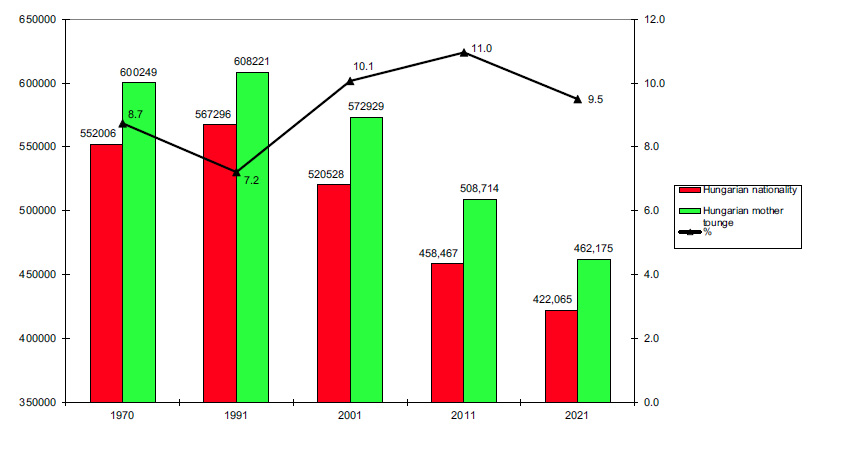
3. Types of affiliation based on nationality and mother tongue
The dilemma of mother tongue versus nationality can be approached in a more nuanced way by looking at the combinations of the two variables. In the first approach, we treat both variables as dichotomous ( Hungarian and non-Hungarian); thus we examine four combinations (or types) of the dichotomy of mother tongue and nationality variables.
Table 1. Types of the distribution by nationality and mother tongue

Of the four types, the least problematic is to consider those who declared themselves Hungarian according to their nationality and mother tongue (HN = Hungarian Nationality; HM = Hungarian Mother Tongue) as belonging to the Hungarian national community. Similarly, at least on an analytical level, we do not consider those who did not assume either Hungarian nationality or Hungarian mother tongue according to either of these two indicators as Hungarian (NHN = Non-Hungarian Nationality; NHM = Non-Hungarian Mother Tongue). However, the number of those who are Hungarian only according to one of the identification indicators is not negligible. For the Hungarians in Slovakia, the number of non-Hungarian nationality and of Hungarian tongue (NHN and HM) is a fraction of about one-third to one-fifth of the number of those who declared themselves as belonging to Hungarian nationality and non-Hungarian mother tongue speakers (HN and NHM). Our data on the combination of the two variables are only available for the last three censuses.
Diagram 3: Types of belonging to Hungarians according to nationality and mother tongue, 2001–2021
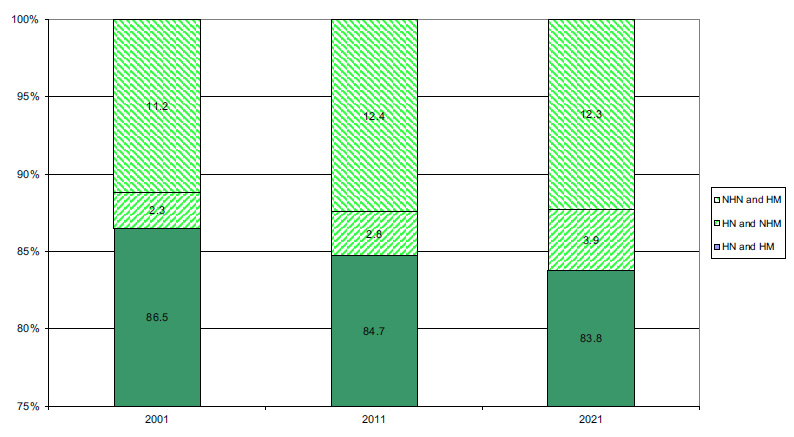
If we then try to draw a more nuanced picture of the ethnic composition of Hungarians in Slovakia, we would have to say that a kind of core group of Hungarians in Slovakia are those who declared themselves Hungarian in terms of both indicators (507,220 people in 2001, 443,632 people in 2011, and 403,140 people in 2021). However, the Hungarian population in Slovakia also includes, to a greater or lesser extent, a significant number of other persons (79, 017 in 2001, 79,917 in 2011, and 77,960 in 2021) who declared themselves Hungarian according to only one of the indicators in the last three censuses. Thus, the census-data-based number of persons with a smaller to larger Hungarian community affiliation—a kind of „ethnic potential”—was 586,237 [this number seems to be inaccurate] in 2001, 52,349 in 2011, and 48,111 in 2021 (see Table F3).
The separation and delimitation of these two additional smaller groups would require further elaboration. It seems a simpler task to delimit group 3 according to Table 1, those with non-Hungarian (Slovak) nationality and Hungarian mother tounge. Based on an ethnicity study carried out in 2000, it is known that about one-fifth of those from mixed Hungarian–Slovak marriages were Hungarian by ethnicity and fourfifths were Slovak, while the ratio was around 1:2 by mother tongue. Similarly, 73% of those of Hungarian origin who had received education in a non-Hungarian language declared themselves to be of Hungarian nationality, but 83% claimed to be Hungarian mother tongue speakers. By other indicators of dual affiliation (language skills, cultural consumption, etc.), more people belonged to the Hungarian community than to the
Hungarian nationality. (Data from a survey carried out in 2000; see Gyurgyík 2004.) The other type of the study on mother tongue/nationality dichotomy, the group of Hungarian nationality and Slovak mother tongue speakers, is perhaps a more difficult group to define. It is probable that in terms of belonging to the Hungarian national community, they are located between the “core group” (Hungarian nationality and Hungarian mother tongue) and the external sphere (Slovak nationality and Hungarian mother tongue). Some of them are of mixed origin, who are of Hungarian nationality but not native Hungarian speakers, in other words those of homogeneous Hungarian origin who were socialized in a more Slovak language environment but have retained their national affiliation according to their origin. Further, the number of those belonging to this group was increased by those of Roma origin who (in addition to their Hungarian nationality) indicated Roma as their mother tongue.
If we examine the development of the three types of belonging to the Hungarians in the three censuses, it is observable that the proportion of those belonging to the core group who were Hungarian according to at least one indicator decreased by a not insignificant amount, from 86.5% to 83.8%. On the other hand, the proportion of the two groups of Hungarians according to only one indicator increased. The group of those of Hungarian nationality and Slovak mother tongue shows a more intensive growth (from 2.3% to 3.9%) than the group of those of Slovak nationality and Hungarian mother tongue (from 11.2% to 12.3%).
4. Nationality and mother tongue according to the 2021 census
In the 2021 census, 422,065 persons declared themselves as Hungarian, 462,175 persons declared themselves as native speakers of Hungarian, and 34,089 persons indicated Hungarian nationality as their second nationality. The number of native Hungarian speakers was 9.5% higher than the number of ethnic Hungarians. The possibility of assuming second nationality provided, in principle, an opportunity to increase the number of people belonging to each national community. The difference between the share of nationality and mother tongue data in 2021 is similar to that of the previous decades. This confirms the assumption that in 2021 the possibility of assuming the second nationality did not significantly affect the number of Hungarian nationalities.
Diagram 4: The Hungarian population by Hungarian nationality, mother tongue, and Hungarian second nationality in 2021
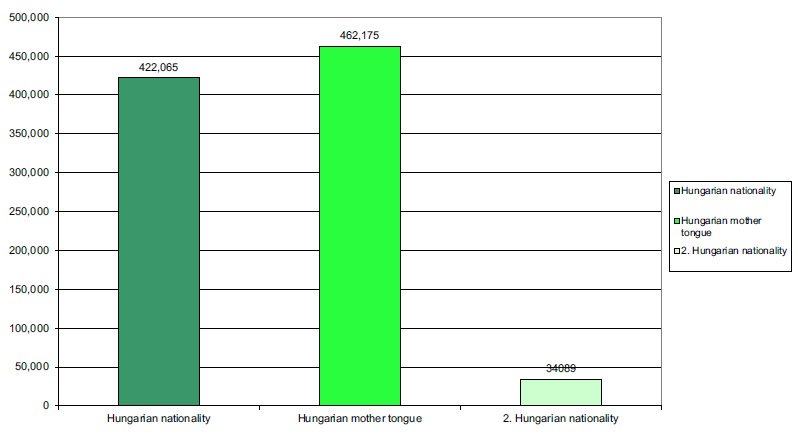
In order to examine the interrelations and interactions of the three variables indicating ethnic attachment, we need to consider the interrelations of ethnicity and mother tongue in addition to the interrelations shown in Table 1. As can be seen from Table 2, from the point of view of Hungarians, two combinations have a meaningful Hungarian connotation in relation to the second nationality: the combination of the Hungarian second nationality and Hungarian mother tongue (5), and of the Hungarian second nationality and non-Hungarian mother tongue (7). Those belonging to the combination of Hungarian nationality and Hungarian mother tongue (5) are already included in the combination of non-Hungarian nationality and Hungarian mother tongue (3) described in Table 1 (3). (Combinations 6 and 8 have no Hungarian relevance.)
Table 2. Types of the distribution by second nationality and mother tongue

The correlations of the three variables of ethnicity with respect to affiliation to Hungarian community are illustrated in Diagram 5.
Diagram 5: The distribution of Hungarians in Slovakia according to their types, 2021
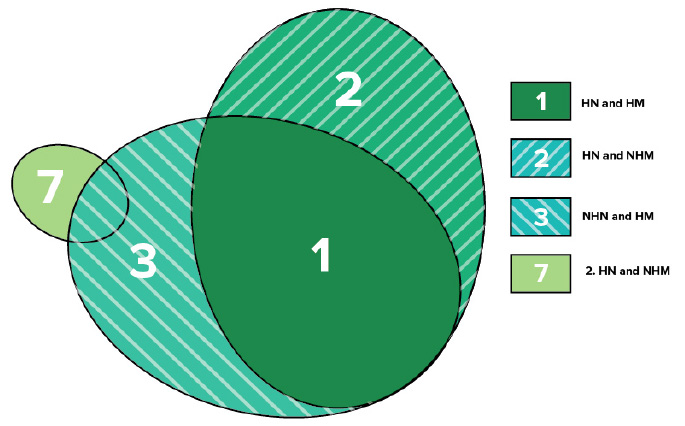
Diagram 5 shows that a part of those belonging to nationality 2 are already part of the categories of non-Hungarians and native Hungarian speakers. In 2021, 81.2% (403,140 people) of the Hungarian population belonged to the core group; 3.8% (18,925 people) were of Hungarian nationality and non-Hungarian mother tongue; 11.9% (59,035 people) were of non-Hungarian nationality and Hungarian mother tongue; and 3.1% were of Hungarian second nationality and non-Hungarian mother tongue (15,190 people). (See Diagram 6/Table F4.) In 2021, a total of 496,290 persons declared themselves as Hungarian in at least one of the three questions on ethnic affiliation.
Diagram 6: The distribution of Hungarians in Slovakia according to the number of belonging to each type
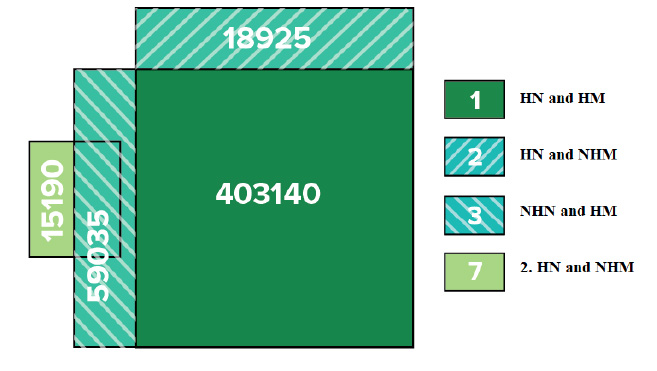
The hierarchical structure of each type is illustrated in Diagram 7. In all probability, those belonging to the core group have the most intense indicators of belonging to the Hungarians, while in the case of the second nationality, this attachment is much looser, presumably more symbolic in most cases.
Diagram 7: Types of belonging to Hungarians in Slovakia according to ethnic attachment, 2021
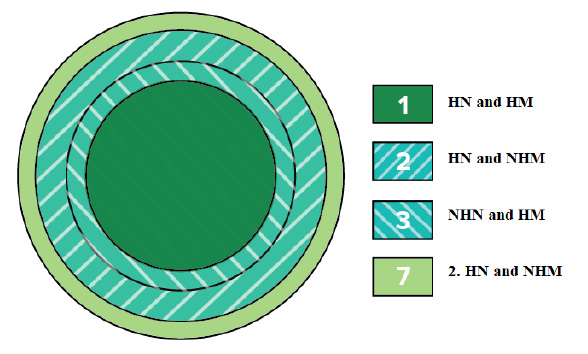
5. Who are you, unknown?
So far, the number of people belonging to the Hungarian population has been examined on the basis of the data registered in the census. Since a not insignificant part of the population did not answer the question on nationality or mother tongue (5.4% and 5.7%, respectively), we will try to estimate the number of non-respondents who can be considered as belonging to the Hungarian minority on the basis of statistical methods. In other words, people registered in the census are basis for the official nationality data. At the same time, data on the ethnicity of a significant proportion of those who did not fill in the census questionnaire are not recorded. In the following, statistical procedures are used to estimate the proportion of those who were not recorded in this way in the census.
The question arises as to how much higher the number of Hungarians would be if all residents had filled in the questionnaire and answered the questions about ethnicity. It is known from the studies of previous census data that the proportion of unknowns in the settlements is correlated with the size of the settlements: the larger the population of the settlement is, the more non-respondents there are (Gyurgyík 2014). This is also confirmed by the data for 2011 and 2021 (Table F5).
As the degree of urbanization of the Hungarian population differs from that of the national, we can assume that the share of Hungarians in the unknowns may be lower than the national share. (See Table F6.) On the other hand, we hypothesize that the nationality composition of settlements may also influence the proportion of nonrespondents. Therefore, we created two subgroups: the Hungarian settlements (HS) and the non-Hungarian settlements (NHS).
Diagram 8: The proportion of unknowns on Hungarian and non-Hungarian settlements

The data show that in HS with a population of fewer than 5,000 the proportion of unknowns is higher than the national rates; in small towns of HS (5,000–19,999) the proportion of unknowns is the same as the national; and in the largest settlements, where the proportion of Hungarians is very low but the national population is significant, the proportion of unknowns is very high. Based on these, it is assumed that the share of unknowns in the population of HS may be around the national rate.
In a further calculation, the unknowns were distributed among the nationalities in proportion to the ethnic composition of the population of the localities. As a result, the share of Hungarians of unknowns in the identified settlements could be around 22,556 (i.e., the expected number of Hungarians is 5.3% higher than the registered number).
In a similar way, the same calculation was made for mother tongue affiliation. In other words, the share of Hungarian-speaking people in the unknowns is estimated to be around 26,039 people. The expected number of native Hungarian speakers is 5.6% higher than their registered number. In this way, the expected number of Hungarians can be around 444,621, and the number of Hungarian native speakers around 488,214. (Table F7)
In the following, we estimate the proportion of unknowns in relation to Hungarian second nationality. In the case of second nationality, the proportion of unknowns at the national level is 11.6%.
The proportion of unknowns for second nationality is 11.6% at the national level. In their case we have to take an additional step absent from the previous analyses. As already mentioned above (Figures 3 and 6), fewer than half (44.6%, 15,190 people) of those who identify themselves as Hungarian as a second nationality (34,089 people), increase the number of those with Hungarian affiliation, since the majority of them (18,899 persons) who declared themselves as native Hungarian speakers are already included in the NHN and HM categories. Of these, the “surplus of Hungarians” can be estimated at 4,200, based on the procedure described above. Of these, 1,872 people (44.6% of the 4,200 people) are considered to be in the second HN and NHN categories. The “yield” of the Hungarians from the unknown second HNs is based on probability data to a greater extent than the previous calculations, but given the relatively small value, it increases the inaccuracy of the estimate to an almost negligible extent. Thus, the estimated number of Hungarian second nationality and non-Hungarian mother tongue is 17,062 people (i.e., 15,190 + 1,872).
Finally, we determine the expected number of people assuming themselves as Hungarian according to at least one indicator, based on the available registered data, and taking into account the proportions and correlations between the registered data. Taking these into account, the number of Hungarian persons with at least one indicator of Hungarian affiliation can be estimated at 520,291, which includes the share of Hungarians in the unknowns. (Table F7.)
Summary and outlook
In our study, we examined the composition of the Hungarian population in Slovakia based on nationality and mother tongue data. Based on an overview of their interrelationship, we have identified the types of Hungarians who belong to the Hungarian minority and the number of Hungarians who identify themselves as Hungarians on the basis of at least one indicator. By including data from a significant number of those who did not answer the questions on nationality, we also attempted to determine their expected number.
In the coming period, one of the possible tasks of studies of the Hungarian population in Slovakia could be to examine the demographic and social characteristics of the ethnic affiliations of the different types in the population.
Literature and online sources
Gyurgyík, László 2004. Asszimilációs folyamatok a szlovákiai magyarság körében. Pozsony, Kalligram.
Gyurgyík, László 2006. Népszámlálás 2001 A szlovákiai magyarság demográfiai, valamint település- és társadalomszerkezetének változásai az 1990-es években. Pozsony, Kalligram.
Gyurgyík, László 2012. Egy csökkenés anatómiája – A szlovákiai magyarság demográfiai folyamatai az 1990-es évektől napjainkig. Kommentár 2012/3, 25-35.
Gyurgyík, László 2014. A magyar nemzetiségűek településszerkezeti változásai az ezredfordulót követő évtizedben az ismeretlen nemzetiségűek adatainak a hátterében. Fórum Kisebbségtudományi Szemle, 2014/4, 57-72.
Sčítanie obyvateľov, domov a bytov 2001. Bývajúce obyvateľstvo podľa národnosti, podľa materinského jazyka a pohlavia za SR, kraje a okresy. SÚ SR 2002, p. 8. Further: Útmutató a személyi kérdőív kitöltéséhez.
Sčítanie obyvateľov, domov a bytov 2001. Definitívne výsledky za SR, NUTS2, kraje, okresy a obce. Bratislava, Štatistický úrad Slovenskej republiky.
Skutnabb-Kangas, Tove 1997. Nyelv, oktatás és kisebbségek. Kisebbségi adattár VIII. Budapest, Teleki László Alapítvány.
Metodika sčítania obyvateľov z hľadiska ich príslušnosti k národnosti alebo etniku so zreteľom
na materinský jazyk. SÚ SR, p. 27. Bratislava 2018. [https://www.scitanie.sk/o-scitani/zakladne-informacie-o-scitani-2021#i6]
[https://www.scitanie.sk/obyvatelia/zakladne-vysledky/pocet-obyvatelov/SR/SK0/SR]
[https://www.scitanie.sk/storage/app/media/dokumenty/vzor-formularahu.pdf]
[http://portal.statistics.sk]
Table F1: The number and proportion of Hungarian and Slovak population in Slovakia, censuses 1921–2021
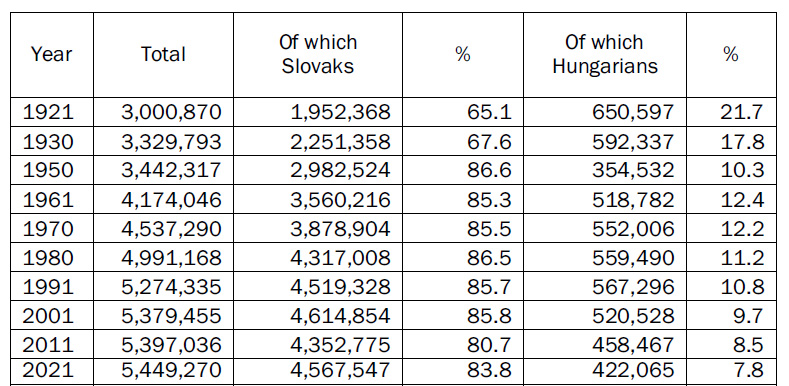
Table F2: The number and proportion of Hungarian and Slovak population according to mother tongue in Slovakia in 1970, 1991, 2001, 2011, and 2021

Table F3: Distribution according to nationality and mother tongue in 2001, 2011, and 2021

Table F4: The distribution of population with Hungarian attachment in Slovakia according to their types, 2021
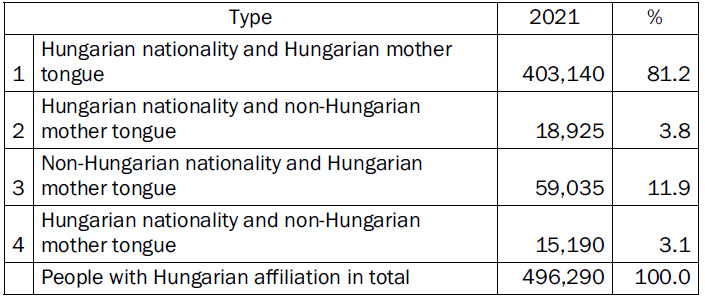
Table F5: The proportion of unknowns according to the size groups of settlements in 2011 and 2021 (%)
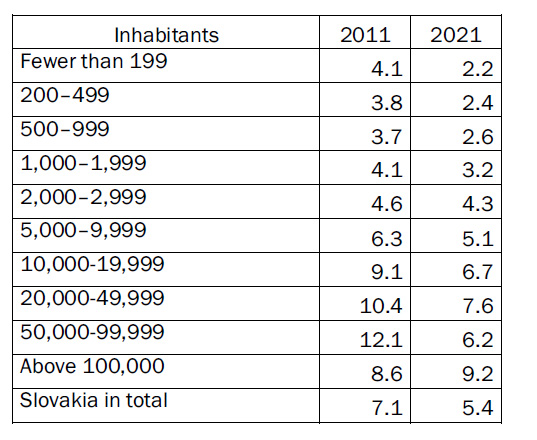
Table F6: The proportion of Hungarians according to the size groups of settlements in Slovakia, 2021 (%)
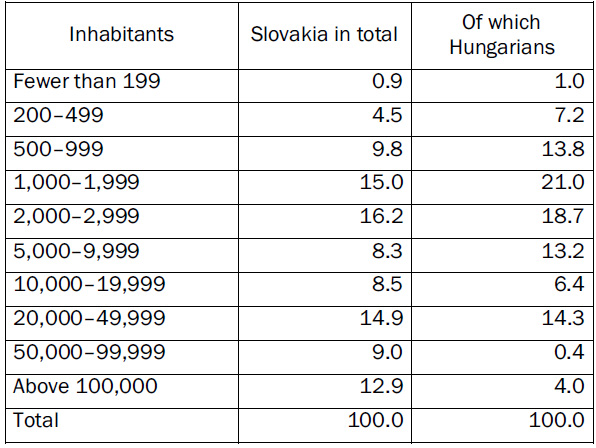
Table F7: The distribution of expected number of population with Hungarian attachment in Slovakia according to their types, 2021
The Usage of the Common Sense in the Public Philosophy of European Modernity
Introduction
When the structure of the scholarly public sphere with the social embeddedness of philosophy and the philosophers experiences a transformation, the self-interpretation of the philosopher can be renewed with benefits for philosophical thinking in general. In these situations it is necessary to rethink both the relationship of philosophy and praxis, and philosophy as a kind of praxis. The re-interpretation of the essence of philosophical thinking and its relation to the praxis leads to re-thinking the relationship of thinking and acting in general, which is the core of the problem of human nature. The task of the re-interpretation of the role of philosophy is fulfilled by philosophers, based on the reflection of its own past. A special relationship between philosophy and history of philosophy appears here. It is what was emphasized by Hans-Georg Gadamer—who will be an important reference in the last part of my paper—in the following sentences:
It is part of the elementary experience of philosophy that when we try to understand the classics of philosophical thought, they of themselves make a claim to truth
* This article was written in the framework of the project entitled The tradition of “sensus communis” in Hungarian thought: Philosophy and the public realm; public philosophy, national philosophy, national characterology (NKFIH-number: K 135 638).
that the consciousness of later times can neither reject nor transcend. The naive selfesteem of the present moment may rebel against the idea that philosophical consciousness admits the possibility that one’s own philosophical insight may be inferior to that of Plato or Aristotle, Leibniz, Kant, or Hegel. One might think it a weakness that contemporary philosophy tries to interpret and assimilate its classical heritage with this acknowledgment of its own weakness. But it is undoubtedly a far greater weakness for philosophical thinking not to face such self-examination but to play at being Faust. It is clear that in understanding the texts of these great thinkers, a truth is known that could not be attained in any other way, even if this contradicts the yardstick of research and progress by which science measures itself. (Gadamer 2006: xxi, in the author’s Introduction)
In the following I analyze a historical case of the interpretation of the essence of the philosophical thinking, namely the modern tradition of the common sense, offering several new aspects. After its Aristotelian and Stoic roots, the concept of the common sense as a significant philosophical term emerged again in British thought, especially in the œuvre of Shaftesbury, and later in the Scottish school of the common sense in the period of the Scottish Enlightenment. This new common sense philosophy of early modernity was a special answer to the challenges of the modernity, as it has manifested itself in the transformation of the public sphere in general and especially the public sphere of philosophy, with serious consequences toward the ideas on human nature and the social role of philosophy. In the following, at first I overview the revival of the term sensus communis (the common sense) in the context of the turn of philosophical communication, then I show how this term was exterminated in the 19th century German and Hungarian philosophies. In the last part of my writing I outline how and why this term was reconstructed in the historical inquires in German philosophy by Hans-Georg Gadamer and in contemporary Hungarian research on the history of philosophy.[1]
Revival of sensus communis as an answer to the turn of the structure of philosophical communication
The structure of the scholarly public sphere of Central-European philosophical life fundamentally changed at the turn of the 18th and 19th centuries, following similar but earlier changes of British and French philosophies. This new structure of the scholarly public sphere was characterized by two features. The first one is the appearance of a new, relatively independent institutional network, based on the increased significance of the extended correspondence of scholars, independent publishing houses, scholarly periodicals, saloons, and academies. The second one is the increased significance of the usage of native vernaculars instead of Latin in philosophy. However, the change of languages had fundamental consequences in the self-understanding of the next generation, and in the history of philosophy, its importance was not acknowledged in the contemporary discourse at any time. However, the change of the dominant languages of the philosophical publications happened in different epochs in different national cultures, but always relatively quickly (e.g., within a generation in the Hungarian case). Participants of this change could interpret their positions within the framework of the functionally bilingual communication of early modernity, and they applied its term for the actual circumstances. The usage of native languages and Latin was linked with different audiences, divided between academic and laic, and home and foreign public spheres. This communicational turn inspired the philosophers to reformulate their opinions about the audience of philosophy and the social role of philosophy with ge neral epistemological and anthropological consequences. Several theories and concepts of the philosophy of modernity can be discussed as theoretical reflections or answers to this change of communication. The most well known are the different forms of the modern common sense philosophies: Kant’s distinction between philosophia in sensu scholastico and philosophia in sensu cosmopolitico, combined with private and public usage of the reason, and Herder’s concept of publicum. The following offers outlines of the first one: the common sense philosophies in the British, German, and Hungarian cultures.[2]
The analysis of the turn of scholarly communication emerged as a new interpretation of the role and value of the sensus communis, at first in British philosophy. The original meaning of this concept is an intrinsic faculty of every human individual that appears in their understanding, moral judgements, and sentiments, and in their taste in art. The community of this faculty appeared just as a uniform feature of individual minds in the initial form of this term. It is clear from the beginning that the classical term is used in Britain with an extended meaning, not purely in an epistemological context but also in moral and social contexts, as well. The British common sense includes the sociability of humans and the speciality that the individually inborn, equal common sense can only be developed in social interactions and common thinking. In Shaftesbury’s thought, human minds can realize the truth in the status of humor. It is an individual feature that only works in social interactions, which inevitably feature an emotional context, a clear opposite of the individual and emotionally neutral apateia of ancient Stoicism. The epistemological role of the two terms is similar: a status of minds in which they can realize the truth. However, the antique one is highly individualistic and purely rational, and the modern one is embedded in social interaction and connected with emotions. In his reflection on the history of philosophy, he refers to the neologism of Marcus Aurelius, koinonoēmosynē. However, although he is familiar with the details of the meanings of all of the Greek and Latin terms of Stoicism connected to the sensus communis, he chose this non-trivial expression, because of its moral content and its embeddedness into social connection. In his philological notes he emphasizes the connection of the emotional and epistemological elements of these terms in the history of philosophy, as well, in the following form:
It may be objected possibly by some particularly versed in the philosophy abovementioned, that the koinos nous, to which the koinonoēmosynē seems to have relation, is of a different meaning. But they will consider withal how small the distinction was in that philosophy, between the hypolēpsis, and the vulgar aisthēsis; how generally passion was by those philosophers brought under the head of opinion. (Shaftesbury 1737: 105; the orthography has been modernized and the Greek terms has been transliter ated into Latin letters.)
His additional references to classical poetry further emphasize these moral, emotional, and social contexts. Shaftesbury’s Scottish followers use more conventional classical references (e.g., Thomas Reid refers to Cicero’s De oratore III. 1),[3] but the emphasis on the common societal environment remains. Parallel to the moral philosophy of Adam Smith, our moral sentiments, which can be regarded as a special form of the common sense, are intrinsic, individual features on the one hand, but achieving a level of humanity in which we can realize and recognize the common roots of our moral judgements depends on the global commercial, economical, and, at the same time, moral and political interactions of humankind (see Smith 1976). Similar chains of ideas have followed the frequent usage of the terms of politeness, refinement, and taste, sometimes at the core of epistemology, but more often in the political, aesthetical, and moral discourses, amongst the authors of the Scottish Enlightenment. It is not by an accidental event of the history of philosophy that this theoretical reflection emerged strongly in Scotland; it can be interpreted as an answer to a change in the structure of the communication, under conditions of the rise of modernity and their consequences for the intellectual sphere, especially for philosophical life. The semi-peripheral position of Scotland has offered a good point of view for detecting structural changes; several processes were realized easier from an Edinburgh perspective than they were from a London perspective.
This Scottish semi-peripheral regard and the theories rooted in it offered elements of the interpretation of a similar communicational change of the philosophical public sphere on the European continent. At first the case of German philosophy in the middle of the 18th century must be mentioned. German Popularphilosophie focuses on the requirements of the audience of the new public philosophy, outside the walls of the universities and other academic institutions. Populus as an audience is not identical to plebs, but is a conscious community of responsible citizens, whose main characteristic is their urbanitas. The emphasis on the interaction of individuals in making—especially aesthetical—judgements and the development of this new collectiveness is the main achievement of this school (Ernesti 1762: 153).
The difference between the cultural functions of the common sense in public intellectual life and of sensus communis in professional philosophy appears more clearly in the Hungarian philosophical tradition. The first Hungarian common sense philosopher, József Rozgonyi, formulated his philosophy in the framework of his critique of Kant; the Hungarian Controversy on Kant (1792–1822) coincided with his active career. The structure of his Kant critique was determined by the accidental fact that he wrote his first work against the German Kantian philosophers before he could read Kant’s Critique of Judgement, and the aesthetical questions remained in the shadow of epistemology and moral philosophy during the whole of the Kantian Controversy.[4] The language of Rozgonyi’s works leads us to the core of the functional multilingualism of his epoch; in Hungarian he criticized the German works of Kant and his early followers based on his favorite Scottish authors, formulated in his main books in Latin, and in several short essays, during the last period of his career. The Kantian terminology in Latin, created by him from a critical position, represents a serious philological problem in the history of Hungarian philosophy. (It is earlier than and not identical to the Latin terminology of the Kantianism developed by German Kantian thinkers in the late 1790s.)
Rozgonyi clarifies the fundaments of his thought in his first philosophical work, using a definition from a writing of James Beattie as a motto, quoted in English in his Latin book:
All sound reasoning must ultimately rest on the principles of common sense, that is on principle intuitively certain or intuitively probable; and consequently that common sense is the ultimate judge of truth, to which reason must continually act in subordination. (Rozgonyi 2017: 25)[5]
Later, he contextualizes the modern common sense tradition in the Kantian controversies of his epoch in the following way:
The Kantians seemingly neglect the proposition of the Scottish philosophers, Oswald, Reid and Beattie on the common sense, and recognise the well concluding reason as an exclusive judge. < Kantiani enim omnem Scotiae philosophorum Oswaldi, Reidii, Beatties de sensu communi sententiam flocci facere tribunalque controversiae huius definiendae unicum rationis legitime concludentis agnoscere videntur. > (Rozgonyi 2017: 38)
Later, he shows the difference between the Scottish and continental European concepts of the common sense in the context of the classical references to this term, describing the embeddedness of the thinking in the actions of human:
If the Kantians meant common sense the same what the abovementioned
Scottish philosophers do, e.g. Aristotle’s koinai doxai, Cicero’s naturae iudicia, i.e. the immediately evident propositions, which are the fundaments of every demonstration, […] by other words, principles, what can be neglected by words, but must be followed by the whole of life and by the constant rationality of the acting, and involuntary recognised; in this case I do not know who could neglect the common sense. […] The Kantians mean common sense the perception of the crowd, which perhaps can be unreasonable. But the abovementioned excellent Scottish philosophers have never recognised the common sense in this meaning. In their discourse, the perception belongs both to the philosophers and to the crowd. See Beattie’s essay on truth, part I, chapter 1. < Si quod Kantiani per sensum communem id, quod Scoti illi philosophi intelligant, v. g. Aristotelis koinai doxai, Ciceronis naturae iudicia seu propositiones immediate evidentes, quae fundamentum praebent omni demonstrationi, […] principia, quae si quis ore neget, toto vitae tenore et agendi rationi constanti vel invitus affirmare cogitur, nescio, qui possint cum reiicere? […] Kantiani per sensum communem sensum vulgi quandoque absurdum intelligunt. Sed tali significatu eximii illi Scoti sensum communem nunquam acceperunt. Sensus ille, de quo hi disputant, acque philosophorum ac vulgi est. Vide Beattie’s essay on truth, p. I. ch. 1. > (Rozgonyi 2017: 39. The motto of Rozgonyi’s work is the concluding sentence of Beattie’s Essay on truth, referred here by him. Aristotle’s Greek term has been transliterated into Latin letters.)
In the 19th century theoretical reflections on the cultural nation-building programs of East-Central Europe, the abovementioned concepts of Scottish Enlightenment and German Popularphilosophie were useful tools and played an important role. For example, “the development of the politeness and refinement of the nation” became a political slogan, and to create a modern civic consciousness based on the common sense and supported theoretically by the public philosophy was a dominant idea, at least in Hungary. The next generation of the Hungarian common sense philosophers after Rozgonyi, representatives of the so-called Hungarian harmonistic philosophy, János Hetényi and Gusztáv Szontagh, had a different type of reflection on the historicity of their philosophy (for a more detailed analysis see Mester 2018c).[6] They paid less attention to the origin and historical narrative of the common sense philosophy and to their own position in this narrative; they preferred to use their common sense philosophy in their works on the history of philosophy and the philosophy of history. Gusztáv Szontagh offers an international context of Hungarian philosophy, embedded in the social context in the historical chapters of his first main work (Szontagh 1839), and he offers a narrative of the development of civilization based on the refinement of the common sense, in the historical appendix of his main work of political philosophy (Szontagh 1843). Hetényi’s narrative of Hungarian philosophy is a history of the social development of the common sense in Hungary; it is civic philosophy in his terminology (Hetényi 1839). His history of Hungarian urban culture is the counterpart of his history of philosophy; its role is to show the social background of philosophy in history (Hetényi 1841).
The defeat of the common sense in the German and Hungarian philosophies
The next generations of German philosophy definitely differentiated themselves from the common sense tradition. We find examples of an opposition to the common sense of the crowd (gesunde Bauerverschtand) and the individual genius in the pre-Kantian period, as well as in Hamann’s Clouds (Hamann 1761/1950). A similar distinction would later be definite and systematic in the philosophy of Georg Wilhelm Friedrich Hegel (for a more detailed analysis of the Hegelian attack against the common sense see Mester 2018d and Mester 2020). Hegel in his first serious philosophical writing identified the theoretical thinking with speculation, as a counterpart of the common sense, in the chapter titled “Relation of Speculation to Common Sense”:
For this reason, speculation understands sound intellect (gesunde Menschen verstand) well enough, but the sound intellect (gesunde Menschenverstand) cannot understand what speculation is doing. […] Common sense (gesunde Menschen verstand) cannot understand speculation; and what is more, it must come to hate speculation when it has experience of it; and, unless it is in the state of perfect indifference that security confers, it is bound to detest and persecute it. (Hegel 1802/1977: 99-100)
Not only the hierarchy of the speculation and the common sense, but also the motive of the conservatism of the common sense was contained in Hegel’s writing. Later, in the preface of his early masterpiece, he discusses the concept of insight as a result of theoretical thinking and the concept of edification connected with the emotional approach as opposites in the description of the actual state of the “self-conscious Spirit”:
[A]t the stage which self-conscious Spirit has presently reached […] now demands from philosophy, not so much knowledge of what it is, as the recovery through its agency of that lost sense of solid and substantial being. Philosophy is to meet this need, not by opening up the fast-locked nature of substance, and raising this to self-consciousness, not by bringing consciousness out of its chaos back to an order based on thought, nor to the simplicity of the Notion, but rather by running together what thought has put asunder, by suppressing the differentiations of the Notion and restoring the feeling of essential being: in short, by providing edification rather than insight. The ‘beautiful’, the ‘holy’, the ‘eternal’, ‘religion’, and ‘love’ are the bait required to arouse the desire to bite; not the Notion, but ecstasy, not the cold march of necessity in the thing itself, but the ferment of enthusiasm, these are supposed to be what sustains and continually extends the wealth of substance. (Hegel 1807/1977: 4-5)
The endeavor for the edification is incarnated by his opinion partly in the theory of Romanticism of his age, partly in the German Popularphilosophie, and partly in the enthusiasm of the religious pietistic movement. Hegel discussed the role and the character of the common sense in detail, especially in the subchapter titled “Reason as Lawgiver,” where he describes that the common sense leads us to a contradiction of terms during the formulation of moral law. The relationship of the common sense and theoretical thinking is the same in this special case as was described earlier in general. Hegel later, in the introduction of his lectures on the history of philosophy, in the subchapter titled “Philosophy Proper Distinguished from Popular Philosophy,” extended the concept of Popularphilosophie from a concrete German philosophical group to a universal phenomenon of history from Cicero through Pascal to the religious mystical thinkers. The only common element of these highly different authors is a kind of the common sense, connected with the moral sense, by Hegel’s opinion:
But the drawback that attaches to this Philosophy is that the ultimate appeal even in modern times is made to the fact that men are constituted such as they are by nature, and with this Cicero is very free. Here the moral instinct comes into question, only under the name of feeling […]. Feeling is first of all laid hold of, then comes reasoning from what is given, but in these we can appeal to what is immediate only. Independent thought is certainly here advanced; the content too, is taken from, the self; but we must just as necessarily exclude this mode of thinking from Philosophy.
(Hegel 1892: 93)
The first generation of Hegel’s Hungarian disciples in the 1810s and 1820s, and the Hegelian participants of the so-called Hegelian Trial (1838–1842), did not have such a big influence on Hungarian philosophical life that they could break the common sense tradition. It happened as late as the “resumption of the Hegelian Trial (1856– 1858).” Hegel’s most important Hungarian follower, János Erdélyi, applied Hegel’s argumentation in this controversy, which played a crucial role in the further history of Hungarian philosophy. There is a special significance of the supposed rurality of the common sense in the argumentation of Erdélyi. At first, he summarizes that all obstacles of professional philosophy based on the common sense: “all these superstitions are cultivated and taught by the name of the common sense” (Erdélyi 1981: 55). After the numerous pejorative references to the common sense, he had to formulate his own common sense concept. In this formulation at first he identifies the common sense with the conservatism of the everyday thinking, both in public life and philosophy:
The common sense wants always the perfected, cannot be renovated. The spirit, contrary, always follows its way, makes progress the world. […] Because the common sense wants always the perfected, consequently, it insists on the perfect truths, which were established a philosophical or political school long time ago for the eternity.
(Erdélyi 1981: 57)
It is interesting that Erdélyi’s examples of the innovation against the conservatism of the common sense come from the fields of the sciences and economy, and linguistic reform as well. (The lack of the social and political reforms is probably the consequence of the calculation with the possibilities of the publication, under conditions of the censorship in the age of neo-absolutism in the Hapsburg Empire.) The counter-concepts of the conservative common sense and the progressive spirit, formulated above, have been fulfilled by concrete content in here. Erdélyi formulated a non-communicative concept of the common sense:
The common sense can easily compatible with superstition, ignorance, stagnancy, all the moral and material wrong […] Contrary, on every great thing, which were for the progress of the humankind, there are deep, serious, secure and sublime marks of the thought. (Erdélyi 1981: 43)
There is no social communication, just standard biases against progressive initiatives. Their main types are ignorance and malignancy toward modern technology, such as the railway network, and toward the institutions of the established Enlightenment, mainly the system of public education. In his last example in his work referred to here, a rural housewife was against the literacy of her daughter because she could use it for writing a letter to her lover; this idea against women’s education is based on a common sense judgement, in Erdélyi’s interpretation. Erdélyi eliminated the urbanity of this program and disregarded his opponents’ ideas of the urbanity of the common sense for creating from it a non-communicative concept. The essence of his critique is the opposition of the conservative, rural common sense and the spirit of the progressive urbane civilization.
Erdélyi’s attack did not inspire a long discussion or debate because of biographical reasons. One of his main possible opponents, János Hetényi, died in 1853, before the publication of Erdélyi’s Present of the Inland Philosophy in 1856. Another serious opponent, Gusztáv Szontagh, formulated a characteristic counter-argument about the embeddedness of human thinking in the praxis, based on his common sense philosophy, with an emphasis on the close connection of philosophical thinking and human thinking in general:
[A] philosopher does not think purely for the sake of thinking; on the contrary: a human is thinking and investigates the truth for the right acting. (Szontagh 1857: 217)
It is a clear declaration of a theory of human thinking and acting, which is radically different from Erdélyi’s Hegelian ideas. It could have been the basis for a fruitful discussion between Hegelians and common sense philosophers, but Szontagh died in 1858, before the publication of Erdélyi’s reaction. Erdélyi withdrew the manuscript of his new discussion paper after reading Szontagh’s obituary, and the discussion ceased before it really started.
The target of the above-discussed common sense tradition was the re-positioning of philosophy within a new public sphere. In the Hungarian case, the program was to put philosophy cultivated in Hungarian into the new system of the so-called national sciences, and a theoretical interpretation and conscious design of this process. In other words, national philosophy, as a special version of the modern public philosophies in 19th century East-Central Europe, adapted to the system of the new modern national culture, and it wanted to simultaneously fulfil the role of both the philosophical interpreter of this new type of political community called nation and the designer of this community. By this system of ideas, from the cultural, political, economic, scientific, and artistic development of a country, a theoretical reflection appeared in the open sphere and based on the common sense, it could create a national community and a national culture, connected with the development of the actual level of the concrete appearances of the common sense as well. Erdélyi’s target was the concept of national philosophy, but he hit the philosophical concept of nation as a modern political community, and for ages made difficult the theoretical analysis of the political community, despite the fact that it was a long and well-established tradition. Hegel and his Hungarian follower were referred to as the representatives of a professional and scientific approach to philosophy in juxtaposition to the ideal inherent in the public philosophy. Within the fight for the professional and against the public philosophy, the concept of common sense was lost. It is not yet clear what the social function and anthropology of professional philosophy are, nor what defines itself against the common sense. We should consider that Erdélyi himself attacked the consequences of a public philosophy based on the social status of a public philosopher, more embedded in the communicational network of the modern press than in the academic system.
Revival of the common sense tradition in the German and Hungarian philosophies
After the extermination of the term sensus communis in the 19th century German and Hungarian philosophical traditions, a change in the self-understanding of philosophy was needed for its revival. A significant part of this process is Hans-Georg Gadamer’s œuvre. In the first chapter of his Truth and Method, second amongst his “guiding concepts of humanism,” after culture (Bildung), is sensus communis. Gadamer’s aim was not purely the methodological renewal of the human sciences, but a new beginning, a new self-understanding of German philosophy, with a reconstruction of its pre-Kantian status. By Gadamer’s description, the political aspect evaporated from the German version of the common European humanist tradition, but it remained in British and French thought. This imperfection of German thought appears in the beginning of his foreword to the second edition, in general form:
In Germany (which has always been pre-revolutionary) the tradition of aesthetic humanism remained vitally influential in the development of the modern conception of science. In other countries more political consciousness may have entered into what is called the »humanities«, »lettres«: in short, everything formerly known as the humaniora. (Gadamer 2006: xxvi)
Later he formulates the same opinion more concretely, focused on the German traditional interpretation of the common sense:
Whereas even today in England and the Romance countries the concept of the sensus communis is not just a critical slogan but a general civic quality, in Germany the followers of Shaftesbury and Hutcheson did not, even in the eighteenth century, take over the political and social element contained in sensus communis. The metaphysics of the schools and the popular philosophy of the eighteenth century – however much they studied and imitated the leading countries of the Enlightenment, England and France – could not assimilate an idea for which the social and political conditions were utterly lacking. The concept of sensus communis was taken over, but in being emptied of all political content it lost its genuine critical significance. (Gadamer 2006: 24)
Gadamer states that the common sense became at first an empty concept and then it evaporated in Germany and was restricted to the judgements of aesthetics and taste; in Kantian and post-Kantian thought it lost all its significance. (We have seen above in the case of the Kant-critique of Rozgonyi that the modification of the meaning of the common sense in Kantian philosophy, in comparison with the Scottish school, was realized by the common sense philosophers of Kant’s epoch, as well.) The sole exception is the pietistic tradition, where its critical potential has survived. Gadamer uses here the results of his own research on the history of philosophy; he wrote an introductory essay to the modern edition of a work of Friedrich Christoph Oetinger, who is his most often quoted pietistic author.[7] In the mirror of the recent research and the experiences of the role of the common sense tradition in the early period of East Central European national building, Gadamer seems to underestimate the political content of the common sense philosophy in Europe. It is surprising that he do not discuss Hegel’s crucial opinions about the common sense. It is more peculiar if we consider that in the previous chapter he analyzes Hegel’s concept of Bildung, with the end of the achievement of the Absolute. As it was shown earlier, Hegel’s attack against the common sense was based on the image of the common sense as a barrier to thinking in the achievement of the absolute, and one of the main opponents in this question was the pietistic movement. We must see that Gadamer’s masterpiece is not a handbook of the history of German philosophy, but a philosophical work of the self-reinterpretation of philosophy, based on the re-understanding of the history of philosophy. From our point of view, the most important element of his endeavor is that he tries to correct the historical de-politicization of German philosophy and redirect philosophy into the context of the social discourse, based on the re-thinking of the history of philosophy.
By the first glance, the revival of the Hungarian common sense tradition was merely the result of the internal interests of Hungarian philosophical historiography. In the recent research on the history of Hungarian philosophy, an intention was the simple correction of the conventional progressivist narrative of our handbooks of the history of philosophy. We were just curious about the figures that remained in the shadow of the progressivist vanguard groups; they were mainly the leaders of the anti-Kantian side of the Hungarian Controversy on Kant (1792–1822) and the anti-Hegelian key figures of the Hegelian Trial (1838–1842), and of its resumption after the revolution (1856– 1858). It was detected that they form different generations of the same common sense tradition, which was exterminated in Hungary in the middle of the 19th century. Their estimation, besides the texts and data discovered and interpreted by the historiographers of philosophy, depends on our opinions about the social role of philosophy and its place in public discourse. We met familiar topics at every corner, such as the problem of the functional bilingualism of philosophers who write their works in two languages for different (international and national) target audiences; different places and roles of the same philosopher in national culture and in the international discourse; and the opposition of professional philosophy and the role of philosophy in the development of the common sense in the form of public philosophy. At the end of the recent period of our investigations, we felt that de te fabula narratur. However we are professional historiographers of philosophy. We cannot offer such a sterile, antiquarian approach to the past of philosophy, which was free from the re-thinking of our selfunderstanding, as philosophers, citizens, and humans.
Literature
Beattie, James 1778. An Essay on the Nature and Immutability of the Truth; in Opposition to Sophistry and Scepticism. 6th corrected edition. London, Dilly.
Erdélyi, János 1981. A hazai bölcsészet jelene [Present of the Inland Philosophy]. In: Erdélyi, János: Filozófiai és esztétikai írások. Notes by Ilona T. Erdélyi & László Horkay. Budapest, Akadémiai Kiadó, 25–102, 912–924.
Ernesti, Johann August 1762. Opuscula oratoria, orationes, prolusiones et elogia. S. and J. Luchtmans, Lugduni Batavorum.
Gadamer, Hans-Georg 2006. Truth and Method, 2nd, rev. ed. Translated by Joel Weinsheimer and Donald G. Marshall. New York–London, Continuum.
Hamann, Johann Georg 1761/1950. Wolken. In: Nadler, Josef (ed.): Sämtliche Werke.
Vienna, Herder Verlag, Vol. 2, 83–109.
Hegel, Georg Wilhelm Friedrich 1802/1977. The Difference between Fichte’s and Schelling’s System of Philosophy. Translated by Henry Silton. Albany, Harris & Walter Cerf, State University of New York Press.
Hegel, Georg Wilhelm Friedrich 1807/1977. Phenomenology of Spirit. Translated by Arnold V. Miller. Oxford–New York–Toronto–Melbourne, Oxford University Press.
Hegel, Georg Wilhelm Friedrich 1892. Lectures on the History of Philosophy, Translated by Elisabeth S. Haldane. Vol. 1. London, Kegan Paul–Trench–Tübner & Co.
Hetényi, János 1837. A’ magyar philosophia történetírásának alaprajza [A Sketch of the Historiography of the Hungarian Philosophy]. Tudománytár 2/1, 76–165.
Hetényi, János 1841. Honi városaink befolyásáról nemzetünk’ kifejlődésére és csinosbulására [On the Influence of Our Inland Cities to the Development of Politeness of Our Nation]. Buda, Magyar Királyi Egyetem.
Mester, Béla 2018a. Cities as Centres of Creativity in the East-Central European Nation Building. Creativity Studies 11/1, 129–141. DOI: https://doi.org/10.3846/cs.2018.5513.
Mester, Béla 2018b. The Role of Aesthetics in the Works of a Professor at a Calvinist College. A Case Study on József Rozgonyi (1756–1823). In: Balogh, Piroska & Fórizs, Gergely (eds.): Anthropologische Ästhetik in Mitteleuropa (1750–1850) / Anthropological Aesthetics in Central Europe (1750–1850). Hannover, Wehrhahn Verlag, 197–210.
Mester, Béla 2018c. Emergence of Public Philosophy in the East-Central European Urban(e) Cultures. A Hungarian Case. Filosofija Sociologija 29/1, 52–60.
Mester, Béla 2018d. Ruralization of the (Urbane) Concept of Sensus Communis in a 19th-century Hungarian Philosophical Controversy. Acta Universitatis Sapientiae: European and Regional Studies, 14, 52–60. DOI: 10.2478/auseur-2018-0009.
Mester, Béla 2020. A Gap between Public and Professional Philosophy. The Case of Sensus Communis (Common Sense) and its Enemies. In: Bakó, Rozália Klára – Horváth, Gizella (eds.): Mind the Gap! Proceedings of the Sixth Argumentor Conference.
Debrecen, Debrecen University Press, Partium Press, Oradeapp, 11–38.
Oetinger, Friedrich Christoph 1753/1964. Inquisitio in sensum communem et rationem. Faksimile-Neudruck der Ausgabe Tübingen 1753 mit einer Einleitung von Hans-Georg Gadamer. Stuttgart-Bad Cannstatt, Frommann-Holzboog.
Reid, Thomas 1786. Essays on the intellectual powers of man. Dublin, L. White, Vol. 1–2.
Rosenfeld, Sophia 2011. Common Sense: A Political History. Cambridge/MA–London, Harvard University Press.
Rozgonyi, Josephi 2017. Dubia de initiis transcendentalis idealismi Kantiani / József Rozgonyi, Kétségek a kanti transzcendentális idealizmus alapvetéseivel kapcsolatban, Transl. Ágoston Guba. Notes written by Ágoston Guba & Béla Mester. Translation supervised by Szabolcs Kondákor. Contributor of the edition of the Latin text Gábor Gángó. Budapest, MTA Bölcsészettudományi Kutatóközpont, Filozófiai Intézet–Gondolat Kiadó.
Shaftesbury, Antony Ashley Cooper of 1737. Sensus Communis; An Essay on the Freedom of Wit and Humour. In: Antony Ashley Cooper of Shaftesbury, Characteristics of Men, Manners, Opinions, Times, Vol. 1, London, J. Purser, Vol. 1, 59–150.
Smith, Adam 1976. The theory of moral sentiments. Oxford, Clarendon Press.
Szontagh, Gusztáv 1839. Propylaeumok a magyar filozófiához [Propylaea for a Hungarian Philosophy]. Buda, Magyar Királyi Egyetem.
Szontagh, Gusztáv 1843. Propylaeumok a társasági philosophiához, tekintettel hazánk viszo nyaira [Propylaea for a Social Philosophy, with Regard to the Conditions of Our Country]. Buda, Emich.
Szontagh, Gusztáv 1857. Magyar Philosophia: Viszonzás Erdélyi János Munkájára: »A hazai böl csészet jelene« [Hungarian Philosophy: Answer to János Erdélyi’s Work Entitled »Present of the Inland Philosophy«]. Új Magyar Muzeum 7/1, 4–5, 215–240.
Robert College During the Years of Conflict 1908-1918
Introduction
“At the center of the world, all the lends around thee, orient and occident, with their best, have crowned thee.”
The song begins with the lines, “at the center of the world,” which many Robert College students sing at their graduation ceremonies and the alumni of the college sing at their meetings. This chant was initially derived from the American College for Girls (Kaya 2022: 9). However, a much more complicated heritage should come to people’s minds regarding Robert College. This heritage includes the College for Girls and American Hospital, Nursing School, and Bosphorus University (in Turkish: Boğaziçi Üniversitesi).
However, in addition to the educational heritage and objectives of the college, during the first two decades of the 20th century, its role dramatically changed. Starting during the Balkan Wars, the role of the Robert College became more than an institution of education. Moreover, when the Great War came home, both the college itself and the people studying and working in the college started to play a critical role in shaping Turkish–American relations and the destiny of the war for both states.
Regarding Robert College, there are several different studies covering multiple issues.[1] One of the most important among those studies is the memoirs of the college’s former presidents, especially the first three presidents: Cyrus Hamlin, George Washburn, and Caleb Gates.[2] Apart from these primary sources, there are also many se condary sources in Turkish and English about the college and its history.[3] However, regarding the wartime years, despite some valuable sources, such as the memoir of President Gates and several chapters from a limited number of books, almost all focus on the daily lives of the college’s students, instructors, or the presidents.
Therefore, this paper mainly tries to provide a different perspective on the role of Robert College in wartime. The main argument is that from the First Balkan War to the end of the Great War, Robert College acted as a diplomatic tool between the US and the Ottoman officials to maintain Turkish–American bilateral relations. In other words, the college and its heritage were among the most significant reasons for both sides not to go to war.
A Short History of the College and Its Importance in Turkish–American Relations
Robert College was founded in İstanbul in 1863. In 1932 its administration merged with that of its sister college, the Home School for Girls at Constantinople (later called the American College for Girls and Constantinople Women’s College), which was founded in 1871 under the joint presidency of Paul Monroe (Sabev 2014:19). It was founded at a time when the empire was taking part in the Concert of Europe after the Crimean War (1854–1856) and the Conference of Paris in 1856 (Davison 2021: 294). The Robert College became the oldest American institution of education in a foreign country. It was founded as a Christian and American institution and since then has given many students a Christian education (Sabev 2014: 19-20). Moreover, one of the distinct features of the students is that they come from different identities, races, religions, and backgrounds.
The Ottoman relations with the United States date back to 1803, with the establishment of the first US consulate in Smyrna (in Turkish İzmir). However, the first officially mutual attempt to build a diplomatic tie between these states was with the appointment of David Porter to the empire in 1831. Starting in 1882, both expanded their relations until reaching the embassy level in 1906 (Kaya 2022: 15). Moreover, the establishment of Robert College should be counted as one of these attempts. In other words, it was a way of building relations with the Ottoman Empire.
The college’s founders, Christopher Rheinlander Robert, a wealthy New York merchant and philanthropist, and Cyrus Hamlin, a Protestant ex-missionary, considered themselves cultural ambassadors to the Ottoman Empire. They acted with this attitude (Gür 2011: 49). By referring to “cultural ambassadors,” they believed that their visibility and contact with the local population were more significant than the American consulate’s (Gür 2011: 49). Thus, for the United States and the founders of the college, it was not like any regular college; instead, it meant more. It indeed reflected the cultural representation of the United States in the Ottoman Empire. To put it another way, the college was critical of the United States’ missionary activities in the Ottoman capital. However, it should be noted that although Robert College was founded by a former missionary of the American Board of Commissioners for Foreign Missions (ABCFM), and based on the interactions built by the ABCFM in the whole empire, it was by no means attached to the Commission (Sezer 1999).
Nevertheless, this cultural embassy of the United States acted following its founding principles and aims during both the Balkan Wars, and more importantly, during the Great War. While it functioned as a bridge between the empire and Balkan states during the Balkan Wars, it contributed to preserving peace between Americans and the Ottomans during the Great War.
The Young Turks and the Balkan Wars
The period of Caleb Gates’ presidency was one of the most turbulent times in the history of Robert College. The college was not only a multi-religious institution but also a multi-national one. From Armenians to Bulgarians, the ethnicity of the college’s members was indeed diverse. Therefore, the period of 1908–1918 was challenging for the college to survive. However, before the Balkan Wars and the First World War, the influence of the Young Turks movement on the college and its existence were as significant as the wars.[4]
The year 1908 was decisive to see the Young Turks come into prominence from the Committee of Union and Progress (CUP; in Turkish: İttihat ve Terakki Cemiyeti). They were delegates of contemporary ideas and concepts, so they were generally referred to as reformers led by Talat Pasha, Enver Pasha, and Cemal Pasha (Gates 1940). In his memoir, Gates pointed out that when Enver Pasha was the minister of the interior and grand vizier, Gates had a chance to talk with him about some problems regarding the college (Gates 1940). Moreover, according to Gates, Enver always treated him with “exceptional kindness,” although he once said to the American ambassador, “Dr. Gates is always preaching!” (Gates 1940). From what the president mentioned, the relationship between Enver and Gates was not puzzling; instead, Enver repeatedly said to Gates that whenever the college had a need, he would be there for them (Gates 1940). Despite this relatively friendly relationship between the president and Enver Pasha, the Balkan Wars was the starting point of turbulent times for the Gates administration. The First Balkan War broke out in 1912. It coincided with the 50th anniversary of Robert College’s founding. There had been a plan to celebrate this jubilee by assembling alumni and friends from different countries on Founder’s Day, March 23. However, the war conditions caused the college presidency to mark the occasion more modestly by simply presenting exercises on the campus (Gates 1940).
It was almost inevitable that life in the college would be negatively influenced. In 1912, only 65 of 413 students were Turkish, while 179 were Greek and 55 were Bulgarian.[5] Therefore, because Turks were the minority, and more importantly, the Greeks, Armenians, and Bulgarians composed the majority, President Gates worried about possible conflicts between students from these nationalities (Sabev 2014). Gates stated: “Their respective nations were at war. Students and teachers were being called for mi litary service, and many were anxious to know the fate of their families. The boys read the papers eagerly and circulated all sorts of rumors” (Gates 1940). Despite all these possible negative situations in İstanbul regarding the Balkan Wars, the college did its best to sustain a peaceful atmosphere among students. However, the most crucial reason was that students were also primarily residents and compatible despite the multinationality of the college population. Even during the war, a student from one Balkan country said to his friend from an enemy country: “If I were to meet you in the mountains of Macedonia, it would be my duty to shoot you, but here we will live like brothers” (Sabev 2014). This is one of the examples to show how the students and the administration of the college did their best to preserve peace in the college.
The Great War and the College
Even the First World War was a more challenging experience for the college’s student body and administration units. After the Balkan Wars, the Ottoman Empire went to war as an ally of the German Empire. This time, the college faced a series of more complicated problems than it had during the Balkan Wars, when the main issues of the college were food supply, heating, charges of espionage, and the possibility of a seizure of the buildings by the Ottoman officials or military. President of the School of Engineering Lynn Scipio indicated in his memoirs that the school was searched from time to time by Turkish and German authorities to understand whether or not the college had radio equipment (Kaya 2022). In addition, according to Gates, Turkish officials requested several times the technological equipment of the college used in the war (Kaya 2022). However, these problems were not the only issues for Robert College.
As an American missionary institution, Robert College played a crucial role for the United States in sustaining its diplomatic and cultural missions. Before the US joined the war, the main question was whether Robert College would continue its education. With all of President Gates’ efforts and thanks to his friendly relations and discussions with the Young Turks, Robert College continued its education despite all negative influences of the war. However, with the increase in the possibility that the US might enter the war against the Ottoman Empire, education process became more complicated. The German ambassador in Washington announced that if the United States and the Ottoman Empire fought with each other, every American institution in the empire would be closed (Gates 1940). However, after Gates received a guarantee from the Young Turks and Henry Morgenthau, who served as US ambassador to the Ottoman Empire from 1913 to 1916, he told the students that the college would not close (Steiner 2015). He wrote that the “College is to open, as usual, on September 15. The conditions are about as dark as they could be… Our hearts have been wrung almost to insensible by the tales of sufferings that we are not permitted to relieve…” (Gates 1940).
At this point, Gates mentions in his memoirs the importance of his friendly relationships with Turkish officials and Henry Morgenthau. He indicates that they were most fortunate in their ambassador and his efforts to protect the nation’s interests and the college itself (Gates 1940). The president and the ambassador were close friends, and they met several times a week during Morgenthau’s appointment to the empire. This closeness was significant to protect the college because the ambassador was also a good friend of the US President Woodrow Wilson; the ambassador resigned from his duty to support Woodrow Wilson’s presidential campaign. At the same time, Morgenthau had close connections with three leading Young Turks of the CUP: Talat Pasha, Enver Pasha, and Cemal Pasha (Steiner 2015).
Therefore, his attitude and influence contributed to preserving the neutral mood between the United States and the Ottoman Empire during his mission. Thus, he played a significant role in protecting the interests of Robert College. After he told President Gates that he had to resign from his mission because of the political campaign of President Wilson in the US, Gates pointed out the potential danger for the college in his leaving his post at such a critical time (Gates 1940).
Wartime Diplomacy and the Importance of Robert College
After Morgenthau’s assignment, the tensions between the United States and the Ottoman Empire were expected to escalate by both authorities and the students at Robert College. He built a “working trust” with the large international community in İstanbul and important Turkish people (Steiner 2015). The next US ambassador to the empire was Abram Isaac Elkus. However, more important than his assignment is that another development appeared that would influence the relations between the US and the Ottoman Empire and the destiny of the college: the entrance of the United States into the Great War. These two countries did not have a war history (Gür 2011: 77). This image was at the core of the Ottoman approach to the United States and the existence of the college. They were so distant from each other, so both countries did not feel any threat. Moreover, for the empire, the United States followed neutral politics compared to other belligerent nations. Because no aggressive attitude was taken against the Ottoman Empire, diplomatic and cultural relations remained peaceful until the US declared war against Germany (Gür 2011).
In his speech, Woodrow Wilson did not mention the name of the Ottomans. Instead, he directly declared war on Germany. One of the most important reasons for this was the long-established diplomatic and educational interests of the United States in the empire. Most were missionary activities, and Robert College was one of them. Henry Morgenthau once noted that these institutions symbolized “the American spirit at its best” and gave it influence in the region (Laderman 2019). Wilson’s advisor, Cleveland Hoadley Dodge, visited the White House on the days before Wilson declared war on Germany, warning him not to declare war on the Ottoman Empire (Laderman 2019). He was not only the president’s advisor but also a close friend of Caleb Gates, and Gates and Dodge met several times during the sensitive times between the United States and the Ottoman Empire.
Furthermore, according to James L. Barton, one of the missionaries to the Ottoman Empire, Woodrow Wilson had sympathy and interest in the American institutions in the empire and their missionary activities. He considered them the most vital interests of America in the Near East (Laderman 2019). American decision-makers knew that a direct war against the empire would lead to the disappearance of these long-standing and organized institutions, or at least it could damage the scope of their activities. Therefore, the American image, popularity, and influence created by such missionary schooling could suffer (Kaya 2019).
President Gates mentioned those times in his memoir by writing: “I had often asked myself how it came to pass that in such extraordinary circumstances, when the US was at war with Turkey’s ally and when, under pressure from Germany, Turkey had broken off diplomatic relations with our country, the American colleges in Constantinople, Smyrna, and Beirut were anomalously allowed to continue” (Gates 1940).
From what the president wrote, despite the US’s neutrality towards the Ottoman Empire, the empire had broken its official diplomatic relations with America. The Ottoman government permitted American citizens who wanted to leave the country only until July 15, 1917, to do so. This was a difficult time for the college, its students, and its professors. However, despite the broken diplomatic ties, Robert College remained the only institution that permitted students to continue their education. While all French and British institutions were closed, President Gates had a conversation with Talat Pasha, and Talat told Gates that if they had any difficulty, they could come to Talat Pasha for help (Gates 1940). Therefore, despite all of the college’s challenges and the rising tensions between the United States and the Ottoman Empire during wartime, the college could survive with possibly minimum damage.
Conclusions
For the empire and Robert College, 1908–1918 was a difficult period. Despite the college being multi-national and having most of its students’ nationalities at war with each other during the Balkan Wars, it is easy to say that President Gates and his students managed this period as well as they could have. When the Balkan Wars ended, another catastrophic challenge appeared, the Great War. The United States had long-standing missionary activities and institutions in the empire, and they have valued these institutions more than official diplomatic representations. Moreover, the college should be counted as the most important educational institution throughout the empire. America declared war on Germany on April 6, 1917. Though America declared war on Germany, she did not declare war on the Ottomans because the US feared for her schools and missionary interests in the empire (Ahmad 2011).
Thus, this paper mainly examined the role of Robert College in shaping US– Ottoman relations, especially during the First World War. The essential argument was that because President of Robert College Caleb Gates could achieve friendly relations with Ottoman officials and the United States was aware of the importance of missionary activities, a direct war between these two countries could be prevented. In other words, during wartime, Robert College was one of the most crucial diplomatic tools to sustain American–Ottoman relations. Consequently, with the help of the connections among important figures, such as Morgenthau, Gates, Wilson, and Dodge, with Turkish officials, such as Enver Pasha and Talat Pasha, the United States and the Ottoman Empire did not go war to with each other directly.
Literature
Ahmad, Feroz 2011. Young Turk Relations with the United States, 1908–1918. In: Criss, Nur Bilge – Elsenbel, Selçuk – Greenwood, Tony – Mazzari, Louis (eds.): American– Turkish, Encounters Politics, and Culture, 1830–1989, 83-100.
Davison, Roderic 2021. Tanzimat Döneminde Osmanlı Diplomasisinin Modernleşmesi. In: İnalcık, Halil and Mehmet Seyitdanlığlu, Mehmet (eds.): Tanzimat: Değişim Sürecinde Osmanlı İmparatorluğu. İstanbul, Türkiye İş Bankası Kültür Yayınları.
Gates, Caleb Frank 1940. Not to Me Only. Princeton University Press.
Gür, Aslı 2011. Robert College: Laboratory for Religion, Shrine for Science Transculturation of Evangelical College Model in Constantinople. In: Criss, Nur Bilge – Elsenbel, Selçuk – Greenwood, Tony – Mazzari, Louis (eds.): American–Turkish, Encounters Politics, and Culture, 1830–1989, 48-61.
Hamlin, Cyrus 1877. Among the Turks. New York, Robert Carter and Brothers.
Hamlin, Cyrus 1893. My Life and Times. Boston-Chicago, The Pilgrim Press.
Kaya, Önder 2022. Dünyanın Tam Orta Yerinde Robert Kolej: İmparatorluktan Cumhuriyete Bir Okulun Tarihi. Kronik Kitap.
Kaya, Tuğçe 2019. ABD Birinci Dünya Savaşı Sırasında Neden Osmanlı Devleti’ne Doğrudan Savaş İlan Etmedi? Amerikan Gizli Belgeleri Üzerine Bir İnceleme. Journal of Modern Turkish History Studies, XIX/39 (Güz/Autumn), 533-562.
Makdisi, Ussama 2002. Ottoman Orientalism, in American Historical Review, Volume 107, Issue 3, June 2002, 768–796.
Laderman, Charlie 2019. The Wilsonian Solution. Oxford Scholarship Online.
Sabev, Orlin 2014. Spiritus Roberti: Shaping New Minds and Robert College in Late Ottoman Society (1863–1923). Boğaziçi Üniversitesi Yayınevi.
Sezer, Ayten 1999. Atatürk Döneminde Yabancı Okullar (1923–1938). Ankara, Türk Tarih Kurumu Yayınevi.
Steiner, Pamela 2015. Henry Morgenthau’s Voice in History. The Journal of Psychohistory, 42(3), 200.
Ulusoy, Şaban 2005. Robert Koleji ve Yabancı Okullara Yönelik Atatürk Döneminde Yapılan Düzenlemeler. Van, Yüzüncü Yıl Üniversitesi Yayınevi.
Washburn, George 1909. Fifty Years in Constantinople, and Recollections of Robert College. Sastri Press.
Citizens or non-citizens – discrimination against the Russian minority in the Baltics
Introduction
In his 5,000-word essay titled „On the Historical Unity of Russians and Ukrainians,” Vladimir Putin described the collapse of the Soviet Union (USSR) in 1991 as the geopolitical catastrophe of the 20th century (Stent 2022), as millions of people found themselves abroad overnight (Putin 2021). After its disintegration during this period, the USSR lost more than 25 million of its citizens, of which up to 12 million found themselves in the new Ukrainian state. Such a huge loss was suffered by Russia earlier in the 20th century after Nazi Germany invaded the Soviet Union in 1941 and unleashed a bloody war, fighting not only the regular army, but also murdering the civilian population with the help of domestic minions, resulting in the loss of at least 26 million Soviet citizens, a campaign that we can without a doubt call a crime of genocide.[1]
According to Putin, a similar disaster befell Russia in 1991, when it lost 40% of its territory, its citizens suddenly became foreigners in their original home countries, and its former neighbors suddenly became their enemies. Some of these citizens found themselves in the Baltic States and later in North American Atlantic Treaty Organization (NATO) and European Union (EU) countries, and some today make up the population of Ukraine, especially in its eastern parts adjacent to Russia. The protection of human and minority rights belongs to the basic values and requirements for joining the EU within the so-called Copenhagen political criteria. In the case of the Baltic States, which became EU members in 2004, it turns out that this fundamental condition and value is being neglected because it is the Russians. It is precisely in connection with them that the concept of non-citizen appears, which refers to residents of the Baltic states with former Soviet citizenship, claiming Russian nationality, who overnight became foreigners in their own country, only because their ancestors immigrated there after 1940 and were not ethnic Estonians or Latvians.[2]
Using analysis and comparison, we describe the status and observance of human, civil, and minority rights of this minority in the given states, based on the premise that the given states deliberately do not observe these rights and the Council of Europe, as well as the EU, do not strongly address this problem, to the point of overlooking it. In the long term, such a position is untenable; it causes and often brings insurmountable problems to the individual in their personal, professional, economic, and political lives. It can become a detonator in mutual neighborly relations, since one of the basic security interests of any state is also the protection and support of minorities reporting to it.
The position of the Russian minority in the Baltics
In Europe, but also elsewhere in the world, one cannot find a state that is ethnically homogeneous. The Baltic States, Ukraine, Russia, and Eastern Europe are no exception. From its beginnings, Russia, and subsequently the USSR, was a multinational agglomeration dominated by the Russian element. After its disintegration, the originally dominant nation suddenly became a minority (in the sense of loss of power and influence). At the time of the census (i.e. as of December 31, 2021[3]), 1,331,824 inhabitants lived permanently in Estonia, of which ethnic Estonians made up 69.4%, Russians 25.1%, Ukrainians 1.7%, Belarusians 0.9%, Finns 0.6%, and others 1.7%.[4] Spatially, the
Russian minority is distributed in the territories in the east, in the capital Tallinn, and in large cities where industry is concentrated. In Latvia, the last population census was held in 2011, according to which it has 2,067,887 inhabitants (2018 estimates indicate a decrease to 1,925,800). About 62.1% are ethnic Latvians, 26.9% Russians, 3.3% Belarusians, 2.2% Ukrainians and Poles, 1.2% Lithuanians, and 2.1% others.[5] About 70% of the population lives in cities and 30% in the countryside. Latvia is struggling with significant population decline, caused by low birth rates and high emigration. In some cities, such as the capital Riga, Daugavpils, and Rēzekne, Latvians are not even the majority.[6] Lithuania has approximately 2,795,680 inhabitants.[7] More than 83% are ethnic Lithuanian, while Poles make up 6.7% (approx. 200,000) and Russians 6.3% (approx. 175,000). Poles live mainly in the Vilnius area. Russians are most concentrated in the regions of Vilnius and Klaipėda. The Belarusian population lives in the border areas, constituting about 1.2% of the whole population.[8]
It is widely reported that Estonia and Latvia have the largest Russian minorities in Europe. Even Latvia boasts the largest number of members of national minorities in the EU. All three countries have the most complicated relationship with their Russian minorities, with the biggest issue being the citizenship status of ethnic Russians, as they have been stripped of citizenship as „descendants of the occupiers,”[9] and the use of Russian as an official and mother tongue. During the duration of the USSR, Russification took place in all three countries. Russian was the official language, it became the language of communication in all the union states of the USSR, and it was taught in schools. In Estonia, for example, the result was that only a negligible part of Estonians did not learn Russian, while every third Russian immigrant learned Estonian.
The restoration of Estonia’s independence led to an escalation of inter-ethnic conflict, as the new government was the first to adopt an anti-Russian course. First, the Citizenship Act was passed, which stipulated that only residents of Estonian nationality who were citizens or descendants of interwar Estonia could be citizens of Estonia. Subsequently, a new language law was passed in 1993, which stipulated that all positions in the public and private sectors must be filled only by people who can communicate in Estonian. State citizenship could only be obtained through naturalization, the prerequisite of which was passing the Estonian language exams, which were both difficult and—for the unemployed—very expensive.
It was only aspirations for EU membership and the need to meet all the Copenhagen criteria that led the Estonian government to soften its approach to national minorities. Publicly, the assimilationist-dominant approach of the majority ethnic group towards minorities was condemned and replaced by a narrative of equal integration, especially of the Russian minority, into Estonian statehood. Shortly after Estonia’s accession to the EU, the third report of the European Commission against Racism and Intolerance of the Council of Europe (ECRI)[10] dated February 21, 2006, stated that there was a certain shift in minority policy in Estonia and the number of people who obtained Estonian citizenship increased,[11] but that there was still a high proportion of Russians, or „persons with indeterminate citizenship,” who were unable to obtain citizenship due to the ongoing difficulty of the tests.[12] The report also criticized Estonia for not implementing a unified policy to help bring the Esto nian-speaking community closer to Russian-speaking community.[13][14] Similar findings and recommendations, strongly calling for the amendment of the Equal Treatment Act and other related laws in order to ensure the general availability and effectiveness of anti-discrimination rules, appear in the latest (i.e., the sixth) ECRI report on Estonia, published on June 9, 2022, which also states that the Russian-speaking population is still characterized by high social exclusion.[15]
Latvia, which has the highest proportion of Russians[16] among the Baltic countries, took a similar approach towards the Russian minority when it introduced a language test to obtain citizenship, which many local Russians could not pass. Of the approximately 700,000 Russians, more than half still do not have Latvian citizenship. They cannot vote, they suffer as foreigners with a residence permit, and the state puts pressure on them to naturalize or leave the country. They have the status of so-called noncitizens[17] and are descendants of Russians who immigrated to Latvia after the Second World War. Their children, born in Latvia after 1991, do not acquire citizenship automatically, but can acquire it according to the so-called simplified registration of citizenship upon the birth of a non-citizen child. According to it, the application for Latvian citizenship of such a child can be submitted by only one of their parents instead of both, which subsequently led to a decrease in newly born non-citizens to 52 cases in 2016 and 23 in 2017. A legislative initiative was launched by the president of Latvia in 2017 that would have automatically granted Latvian citizenship at the birth of children of non-ci tizens, but it failed due to lack of sufficient political support.
The question of automatically granting citizenship to non-citizens has a principled value for the Russian minority, but even so, Latvia managed to reduce the number of non-citizens from 326,735 persons in 2011, which represented 14.6% of the population, to 222,847 in 2017, which is 11.4% population of the country.[18][19] This is partly due to demographic factors and mortality, as approximately 40% of these persons are 60 and over, and partly due to the emigration of these people, which has led to a decrease in the number of naturalized, which has stabilized at approximately 1,000 persons per year. Latvian authorities report that 98% of non-citizen applicants pass the naturalization exams, but not always on the first try.[20] As for the Russian language, there was a proposal to give Russian the status of an official language. However, it was rejected in a referendum in 2012.[21] Subsequently, the Russian language began to be restricted in education, and from 2020, according to the plans of the Latvian government, all se condary schools are to be taught exclusively in Latvian.[22]
Shortly after Latvia’s accession to the EU, ECRI issued its third assessment report on the state of the fight against racism and intolerance in the country, where it states that although some progress has been made in the fight against racism through cosmetic changes in criminal or labor law, a number of recommendations related to the status minorities and racially motivated attacks on them was not implemented at all or only partially implemented. The commission noted the increasing number of attacks on minorities, stating that it could not consider the response from the authorities, including the criminal justice system, to be adequate. It also stated that the racist discourse (hate speech) of politicians and the media towards immigrants, refugees, religious minorities, such as Muslims, Jews, Roma, and especially the Russian-speaking minority, remains a problem. The commission also noted that the naturalization process had not progressed and is slow, and that a number of problems persist that prevent the full integration of the Russian-speaking population into Latvian society, including language-based discrimination in access to employment and barriers to participation in the public and political life of Latvia. In this context, the commission urged in the report that the Latvian authorities allow non-citizens to vote in local elections and take all necessary measures to ensure the participation of ethnic minorities in the political process, in politically elected bodies, and in the public service. The commission placed particular emphasis on the situation of the Russian-speaking population, with whose representatives the authorities were supposed to work on creating conditions for constructive cooperation.[23]
For now, the latest (i.e., the fifth) ECRI report from 2018 reiterates its recommendation that Latvia ratify Protocol no. 12 of the European Convention on Human Rights; recommends that Latvian authorities ensure automatic recognition of Latvian citizenship for children born to non-citizens and that Latvian authorities harmonize their civil and administrative law with General Political Recommendation no. 7 in terms of the adoption of comprehensive anti-discrimination legislation; and introduces an explicit obligation for public authorities to promote equality and prevent discrimination. For non-citizens, the report recommends securing a sufficient number of places in free Latvian language courses in preparation for their naturalization exams.[24]
The Russian minority in Lithuania has the least complicated relations. Unlike Estonia and Latvia, whose decision created a new kind of people–the so-called non-citizens– Lithuania decided on a different path and adopted the so-called zero solution (i.e., universal citizenship for all its inhabitants who lived on its territory at the time of gaining independence). However, Lithuanian became the official language and the Latin alphabet was introduced in the written text, but the Russian minority also demands Russian and the written text in Cyrillic. Lithuanians consider the Russian minority a burden and do not accept its existence. The situation is similar for the Polish minority in Lithuania, as the authorities administratively limit Polish education and the use of Polish. Poles cannot even use their Polish surnames, and all names and inscriptions are exclusively in Lithuanian. There are also problems with restitution of Poles’ property. This led Polish President Lech Wałęsa in 2011 to refuse to receive Lithuania’s highest state award, saying he was only willing to receive it after the status of the Polish minority in Lithuania improved.[25]
ECRI’s latest, fifth report on Lithuania, adopted on 18 March 2016 and published on 7 June 2016, recommends that the Lithuanian authorities take „urgent” measures to ensure that the reduction and concentration of Lithuanian language teaching in classes of national minorities, especially Polish and Russian, is taken into account in the unified language test. The report further recommends to bring Lithuanian civil and administrative law into line with its General Policy Recommendation no. 7 so as to include references to equal treatment in relation to nationality, skin colour, gender identity, the observance of non-discrimination and that these laws content the duty to amend or abolish discriminatory provisions and the duty of public authorities to promote equality and prevent discrimination. It also recommends the Lithuanian authorities to ensure that suppliers or partners – with whom they work – observe the principles of non-discrimination as well as the obligation to amend or abolish discriminatory provisions in existing contracts or agreements.
In addition, ECRI recommends introducing legislation to suppress public funding of organizations, including political parties, that promote racism and to establish options for their dissolution, and it reiterates its recommendation to Lithuania to sign and ratify Protocol no. 12 to the European Convention on Human Rights. In the footnotes, the report states that there is currently no law on national minorities in Lithuania, as the previous law was only valid until 2010 and the Seimas has not yet adopted a new law.[26]
A huge problem, which is reflected in all ECRI reports of the Council of Europe from the last period, is the so-called hate speech against minorities, racist discourse of politicians and the media, and support for the glorification of the fascist past of these states,[27] which is perceived extremely sensitively by the Russian minority, as well as by Russia itself, as a provocation. A similar problem is the demolition of Soviet monuments dedicated to the heroes of the Red Army who fell in the fight against fascism during the Second World War.[28]
Since all three countries aspired to membership in the EU and the basic values of this grouping according to the founding treaties include the protection of human dignity, basic human and civil rights, minority rights, and the rule of law, the approach and treatment of these countries with their own minorities had to be evaluated by the European Commission, which monitored the fulfilment of the Copenhagen access criteria. From this period, for example, the decision of the European Council from March 1998 can be mentioned, in which among the political criteria conditioning the admission of Estonia to the EU, the requirement „to take measures to facilitate the natura lization process and better integration of non-citizens, including stateless children” can be read (Krejčí 2005). This requirement was included among the so-called short-term criteria with a deadline for fulfilment in the same year. In December 1999, among the political criteria in the resolution of the European Council, the demand for „the adoption of specific measures aimed at the integration of non-citizens, including language teaching and the provision of the necessary financial support” appears again with a deadline of 2000. To date, these requirements have not been met by Estonia and Latvia. Noncitizens of these countries are therefore not even citizens of the EU, since the so-called European citizenship is tied to the citizenship of a specific member state. The situation was not resolved even by the individual amendments to the founding treaties of the EU from 2009 (Lisbon Treaty), since they are based on the assumption that an EU citizen has a legal residence in a member state, which Estonia, but especially Latvia, tried to prevent.[29] This led to the fact that several hundreds of thousands of people—non-citizens without basic civil and political rights—still live on the territory of the EU.
The latest reports on the progress and protection of human rights in the EU member states in the case of Estonia state the gap between the Estonian and Russianspeaking communities that persists in education, the labor market, the environment, and media consumption.[30] In the case of Latvia, the biggest concern of the European Commission in 2010 was the group of people who arrived or were born in Latvia „during the Soviet occupation,” as well as the fact that naturalization tests did not actually faci litate the integration of these people into society.[31] In 2021, it only states that there are still non-citizens in Latvia.[32]
Similar conclusions were reached by OSCE High Commissioner for National Minorities Lamberto Zannier, who, in connection with Estonia, stated the persistent concerns of the Russian-speaking community about the future of education in the Russian language and called on the relevant authorities to take into account regional specificities with regard to the ethnic composition of society and create opportunities that the representatives of minorities can participate in decision-making process on future policies in the given area. In the case of Latvia, he pointed out again that 10.7% of persons in the country still have a non-citizen status and are thus without civil and political rights. He also criticized the reform of the school system, which deviated from the previously well-functioning model of bilingual education, recommended by the OSCE high commissioner, which of course raised concerns among national minorities— especially the Russian one. He recommended continuing the implementation of the reform so that it is inclusive and takes into account the concerns of national minorities who will be affected, and so that it does not raise concerns that it is disproportionately punishing them or disproportionately influencing them. Regarding language policy, he emphasized a pragmatic approach, following a balance between the promotion of the state language and the protection of minority languages through positive means and incentives, rather than repressive measures, as these can weaken any efforts to perceive the state language as an instrument of integration.[33]
In short, it can be said that several hundreds of thousands of stateless people live in the Baltics even after 2020, officially registered as non-citizens, pejoratively referred to as the descendants of the occupiers. On a daily basis, they encounter obstacles not only when using the mother tongue of the national minority, but also when trying to obtain citizenship by a person living in the given country since birth. Moreover, these obstructions are mainly reserved for members of the Russian minority. Latvia and Lithuania have not yet ratified Protocol No. 12 to the European Convention on Human Rights of the Council of Europe, claiming that it concerns them only minimally, despite the fact that they are regularly called for this ratification by European international human rights organizations. Lithuania does not even have a law on the protection of national minorities.[34]
Despite this, the EU has never activated Article 7 of the Treaty on European Union against the Baltic states for threatening the EU’s values, listed in Article 2 of the same Treaty, which the Union protects and on which it is based: „The Union is based on the values of respect for human dignity, freedom, democracy, equality, the rule of law and respect for human rights, including the rights of persons belonging to minorities. These values are common to member states in a society in which pluralism, non-discrimination, tolerance, justice, solidarity and equality between women and men prevail.”[35]
Cases of discrimination in the Baltics
The usual rhetoric of the EU is based on the traditional values mentioned above and is based on democracy, but according to Fábry or Yiftachel and Ghanem (Fábry 2015; Yiftachel and Ghanem 2004), the Baltic states have decided to follow a different path. After gaining independence in 1991, instead of the declared principles of democracy, they introduced the principles of the so-called ethnocracy,[36] which is most vividly illustrated by the creation of a group of non-citizens from its own residents of Russian nationality. Estonia and Latvia, in particular, began to practice a policy of revanchism and created a permanently disaffected population from the local Russians, which they fear today. They talk about this population as a threat and use it to justify their membership to NATO (Tetrault-Farber 2015).
Ubiquitous nationalist and anti-Russian rhetoric, so-called hate speech, resonates today more than ever. It is heard both by members of the majority nation and by politicians. Of the aggressive excesses of politicians, we can recall the statements of the Minister of Defence of Estonia U. Reinsal, who in January 2014 called the possibility that Estonia would be represented in the European Parliament by deputies of Russian nationality a threat and declared that the European Parliament must not turn into a forum where Estonian language policy will be attacked.35
Latvian politicians are not far behind either. As one of the initiators of the Latvian school law, I. Druviete said that Russian children should speak Latvian during games; or Member of the Parliamaent, K. Karniš called for the direct assimilation of Russian children in Latvia. The Latvian Minister of Education, K. Šadurskis even compared the Latvian school law to the situation in Alsace after the World War II, where German schools switched to the French language in 1945. Regarding the Ukrainian school law, Šadurskis said: „I have read the Ukrainian law and it seems very moderate to me…”36 The mentioned statements can be described as even milder. Aggressive hate speech contains a dehumanizing vocabulary, assigning many derogatory adjectives and names to Russians. These days, threatening signs appear on many houses of Russian-speaking residents of Latvia: „Krieviem jāmirst” (Russians must die).37 Russian-language media is also restricted, and media broadcasts directly from Russia are also banned.
The tension between the ethnic groups is exacerbated by the repeated marches of Waffen SS veterans in Latvia or the glorification of the 20th SS Grenadier Division in Estonia, about which the EU and the Western media, including the Slovak media, minorities or neighboring states. Other ethnic groups are systematically discriminated against and may face repression or violations of their human rights by state power. Ethnocracy can also be a political regime established on the basis of qualified civil rights, with ethnicity (defined in terms of race, origin, religion, or language) as a distinguishing principle. In general, the raison d’être of an ethnocratic government is to secure the most important instruments of state power in the hands of a particular ethnic group. For details see Howard 2012. remain tactfully silent. Until 2015, these „celebrations” were officially attended by the highest representatives of the state, members of standard political parties, who are also present in the European Parliament. Despite this, European politicians did not refuse to meet with these politicians, did not exclude them from their ranks, and did not activate the aforementioned Article 7 due to the threat to the fundamental rights of the EU. European Union Member States even hypocritically abstain every year from voting on the UN resolution condemning the glorification of Nazism, directed against the celebration of the Waffen SS in the Baltics, even though Latvia and Estonia are not directly mentioned in it.[37] On the other hand, the celebrations of the holidays of national minorities, especially the Day of the Victory of the Red Army over Fascism on May 9, are overlooked and obstructed by state officials.
However, the Baltic ethnocracy is the most noticeable in the area of the alreadymentioned state citizenship, from which the vast majority of persons of Russian natio nality were excluded by legislation in Estonia and Latvia after 1991. In all three Baltic States, citizenship law is based on the principle of jus sanguinis (i.e., the right of blood). It is the principle that citizenship is determined or acquired on the basis of the natio nality or ethnicity of one or both parents. Children can be citizens of a state at birth if one or both of their parents are citizens of that state by blood. It can also refer to national identities of ethnic, cultural, or other origins. From this point of view, this step can be evaluated as a clear attempt to exclude the Russian minority from political life, by preventing its access to elected positions or a referendum. This made it impossible for the Russian minority to co-decide on the future of the country. It was in Estonia and Latvia that there was a real possibility that local Russians would influence the vote on fundamental issues such as joining NATO or the EU or drastic economic reforms, precisely because of the size of this group (around 30% of the population). Therefore, it was necessary to create from this group the so-called Apolitas (i.e., people without state citizenship) and remove them from the political competition as possible opponents of the current representatives of state power (Fábry 2015).
In order to legitimize their actions against the Russian minority, the representatives of Estonia and Latvia created the fiction of the non-existence of the Soviet legal order[38] and granted citizenship only to those who were citizens in 1940 and their descendants.40 Discriminatory legislation affected the majority of Russians who came to the Baltics after[39]1940 and their descendants. Apolitas or non-citizens can obtain citizenship by naturalization after meeting complex criteria, the biggest problem of which has proven to be the language test at the level of complete primary education (Fábry 2015).
Social and economic discrimination go hand in hand with political discrimination. After 1991, many Russians lost their jobs in education, state administration, and local government. Russian non-citizens could not perform several professions from judges and notaries to firefighters. They could not participate in privatization and were also disadvantaged when employed in state enterprises. During the implementation of painful economic reforms, it was precisely the non-citizens who felt their harsh effects the most, but since they did not have the right to vote, they could not influence these reforms and decide on them in the parliamentary elections. Therefore, many non-citizens either „voluntarily” emigrated to Russia or other countries, several „assimilated,” and the older generation died out in the meantime. However, despite pressure for denationalization, the majority of Russians did not change their nationality, even after passing a language test and obtaining citizenship.
Another attack on the Russian minority in Latvia, which can serve as an example of discrimination and enforcement of ethnocracy, is the adoption of an amendment to the Law on Education in 2018, which was also approved by the Latvian Constitutional Court at the end of 2019.[40] The purpose of this amendment is to further restrict the use of the Russian language in Latvian schools, which in practice means the complete liquidation of secondary schools with the Russian language of instruction.[41] This situation concerns more than one-third of the country’s population, who consider Russian their mother tongue. Efforts to suppress the Russian language are not new in Latvia. The first restrictions appeared already in the 1990s, and in 2004, a 60:40 subject teaching ratio for the Latvian language was introduced in Russian secondary schools. However, this new legislation stipulated that at the first stage (grades 1–7) the share of teaching in the Latvian language should be at least 50%, at the second stage of basic education (grades 7–9) at least 80%, and at the third stage (10th grade and above; i.e., for se condary schools), it established the entire education in the Latvian language. There is only one school subject, i.e. subject Russian language and literature as a foreign language where the Lithuanian school law allows the so-called ethnic-cultural teaching, which means teaching entirely in Russian language. For the Russian-speaking minority, this means the complete liquidation of a number of bilingual secondary schools that taught 40% of subjects in the language of the national minority. It affects 145 bilingual schools with the Russian language, one school with Belarusian, and one with Ukrainian language. These schools have survived to this day, although they have been exposed to various forms of disadvantages, especially financial ones. In addition, this law also prohibits Russian in private schools. It is applied at lower levels from 2019 and at se condary schools from 2020 (Fábry 2020).
The reason why we can talk about this amendment as being openly discriminatory is that it is aimed solely at the discrimination of the Russian language. This law does not apply to official languages of the EU. Theoretically, this means that it is possible to open a secondary school in Latvia that will educate bilingually in Slovak, but not in Russian. That is, Latvian children have the right to bilingual education, but depending on whether or not the given language is declared by Brussels to be an official language of the EU. Therefore, neither German nor English bilingual secondary schools had to apply this law and its rules, and they continue teaching without changes.
A wave of resistance arose in Latvia against this law in the form of protest rallies, boycotts, and resistance actions. The government uses various intimidation methods against such protests, from accusations of Russian propaganda and discrediting, to limiting basic rights and freedoms in the form of restricting the right to assembly. In addition, it often arbitrarily changes the routes of pre-announced protests and the locations of rallies at the last minute. The most famous crackdown on human rights activists is the case of A. Gaponenko,[42] who was detained by law enforcement authorities just after the adoption of the new law in April 2018 and held in custody for 4 months. The formal reason for the detention was a text on the Internet. The criminal complaint against him was personally filed by the chairman of the Latvian Parliament Committee for Security and Defence A. Latkovskis. The president of the security police, N. Medzhviets, has repeatedly criticized Gaponenko as an „enemy” or an „agent of Russian influence.” He was taken into custody by the Vidzeme court in a suburb of Riga. After being detained, according to the claims of his supporters, he was beaten and kept in handcuffs for 11 hours.[43]
However, criticism also came from abroad. It was expressed not only by the OSCE High Commissioner for National Minorities Lamberto Zannier,[44] as already mentioned above, but also by the UN Committee for the Elimination of Racial Discrimination,[45] the UN Rapporteurs for National Minorities and Freedom of Expression, as well as the Council of Europe Commissioner for Human Rights.[46] The finding of the Latvian Constitutional Court, which supported the law on the grounds that national education constitutes „segregation,”[47] was also criticized, thereby violating the Convention against Discrimination in Education, the Convention on the Rights of the Child, and the International Covenant on Economic, Social and Cultural Rights.
Conclusions
The situations for Russians in the Baltics is not easy at all. After 1991, with the snap of a finger, as „descendants of the occupiers,” they were deprived of citizenship and thereby all rights arising from it, including the right to a home, despite the fact that they were born in the place of residence. They have no citizenship, not even Russian. They do not have the right to vote, work in the civil service, or serve in the army. They can neither privatize nor own land, or even travel. The attitude of the representatives of the Baltic countries towards such a population was that as a „product of the occupation” they must leave, or they must more or less merge and assimilate with the Estonians and Latvians. That is why the naturalization process was then set up to be difficult, humiliating, and bullying for many. Many of the residents affected in this way preferred emigration or decided to accept Russian citizenship and live in the Baltics as foreigners; some attempted naturalization.
With the accession of the Baltic countries to the EU, this problem was Europeanized, but without a significant shift. Non-citizens, or Apolitas, did not even become EU citizens, and thus they did not acquire the rights of an EU citizen. Therefore, they cannot submit petitions to the European Parliament, complain to the European Ombudsman, or elect members of the European Parliament. During the accession process, certain pressure was created on the side of the EU as part of the fulfilment of the Copenhagen political criteria, but also on the side of the OSCE, the Council of Europe, and Russia, which led to certain corrections in the naturalization process and even made Latvia guarantee the children of non-citizens who were born after its declaration of independence an automatic right to citizenship, but it did not lead to the elimination of the selective approach in granting citizenship, which only supported the deepening of the contradictions between the majority population and the Russian minority. Representatives of the Baltic countries justify this approach by claiming that the presence of Russians threatens the national existence of Latvians and Estonians and that Russians are Moscow’s fifth column. It raises the question of whether these nations were actually fighting for the vision of an ethnically and racially pure state. Moreover, are those ethnographers not right after all, those who claim that the Baltic nations, like Finland, are inherently isolationist, even xenophobic, and that they do not actually to lerate any foreign culture on their territory?
After the end of the accession process and the accession of the Baltic countries to the EU, the voices of critics weakened. Even if international human rights organizations write „stacks of paper” every year, describing some kind of established situation, stating the implementation or partial implementation of the last recommendations, and proposing new recommendations, the reality for the Russian-speaking minority remains the same. The EU is very lax in its commitment to the rights of Russians in the Baltics, as it itself selectively criticizes human rights violations in its rhetoric. The USA and the autocratic regimes of the Persian Gulf are spared, while Russia and China, on the other hand, are subjected to overwhelming criticism. By using such a double standard, the EU itself participates in the anti-Russian campaign and incites manifestations of Russophobia in its EU Member States, the peak of which we are witnessing these days. Moscow has been blaming Brussels for the Baltic problem with the discriminatory status of minorities for a long time, but there is no response. After all, this discrimination is also defended by Slovak soldiers, stationing in the Baltics as part of the NATO contingent as an allied commitment, and they regularly rehearse intervention scenarios to help the country in which Moscow was supposed to have provoked riots among the domestic population. Can anyone then be surprised if the continuation of such an approach would lead to intervention by the state that the national minorities consider to be their motherland?
Online references and Literature
CASE OF SISOJEVA AND OTHERS v. LATVIA (Application no. 60654/00) STRASBOURG 15 January 2007. [Online]. [cit. 2022-6-28] Retrieved from:
(https://hudoc.echr.coe.int/eng#{%22fulltext%22:[%22case%2060654/00%22],%22documentcollectionid2%22:[%22GRANDCHAMBER%22,%22CHAMBER%22],%22itemid% 22:[%22001-79022%22])
CASE OF SISOJEVA AND OTHERS v. LATVIA (Application no. 60654/00). JUDGMENT. STRASBOURG 16 June 2005. [Online]. [cit. 2022-6-28] Retrieved from: (https://www.refworld.org/pdfid/52ea6819a.pdf)
CENSUS 2011. Population by ethnicity and municipality. [Online]. [cit. 2022-6-28] Retrieved from: (http://www.osp.stat.gov.lt/documents/10180/217110/Population_by_ethnicity_municipality.xls)
CITIZENSHIP LAW. Riga, 11 August 1994. [Online] [cit. 2022-6-29]. Retrieved from: (https://likumi.lv/ta/en/id/57512-citizenship-law)
CITIZENSHIP ACT. Passed 19.01.1995. Riigikogu. [Online] [cit. 2022-6-29]. Retrieved from: (https://www.riigiteataja.ee/en/eli/512022015001/consolide)
CSB.GOV.LV. 2011. Statistikas Temas. [Online]. [cit. 2022-6-12]. Retrieved from: (https://web.
archive.org/web/20120129110714/http://www.csb.gov.lv/statistikas-temas/ 2011gada-tautas-skaitisana-galvenie-raditaji-33608.html)
ECRI. 2006. Third report on Estonia. Adopted on 24 June 2005. Strasbourg 21 February 2006 [Online] [cit. 2022-6-29]. Retrieved from: (https://rm.coe.int/third-report-on-estonia/16808b56eb)
ECRI. 2008. Third report on Latvia. Adopted on 29 June 2007. Strasbourg 12 February 2008. [Online] [cit. 2022-6-29]. Retrieved from: (https://rm.coe.int/third-report-onlatvia/16808b58b3)
ECRI. 2016. ECRI report on Lithuania (fifth monitoring cycle). Adopted on 18 March 2016. Published on 7 June 2016. [Online] [cit. 2022-6-29]. Retrieved from: (https://rm.coe. int/fifth-report-on-lithuania/16808b587b)
ECRI. 2017. ECRI report on Ukraine (fifth monitoring cycle). Adopted on 20 June 2017. Published on 19 September 2017. [Online] [cit. 2022-6-29]. Retrieved from: (https://rm.coe.
int/fifth-report-on-ukraine/16808b5ca8)
ECRI. 2019. ECRI report on Latvia (fifth monitoring cycle). Adopted on 4 December 2018. Published on 5 March 2019 [Online] [cit. 2022-6-29]. Retrieved from: (https://rm.
coe.int/fifth-report-on-latvia/1680934a9f)
ECRI. 2022. ECRI report on Estonia (sixth monitoring cycle). Adopted on 29 March 2022. Published on 9 June 2022. [Online] [cit. 2022-6-29]. Retrieved from: (https://rm. coe.int/6th-ecri-report-on-estonia/1680a6d5e6)
EUROPA.EU. 2022. Key facts and figures. [Online]. [cit. 2022-6-12]. Retrieved from: (https:// european-union.europa.eu/principles-countries-history/key-facts-and-figures/lifeeu_sk)
EUROPEAN COMMISION. 2019. Human rights in Estonia 2020 – national minorities and integration policy. [Online] [cit. 2022-6-29]. Retrieved from: (https://ec.europa.eu/migrantintegration/library-document/human-rights-estonia-2020-national-minorities-andintegration-policy_en)
EUROPEAN COMMISSION. 2010. Country Report Latvia: Integration and Naturalisation tests, the new way to European citizenship. [Online] [cit. 2022-6-29]. Retrieved from: (https://ec.europa.eu/migrant-integration/library-document/country-report-latviaintegration-and-naturalisation-tests-new-way-european_en)
EUROPEAN COMMISSION. 2021. Latvia – Country report non-discrimination 2021. [Online] [cit. 2022-6-29]. Retrieved from: (https://www.equalitylaw.eu/downloads/5511-latviacountry-report-non-discrimination-2021-1-57-mb)
Fábry, B. 2015. Diskriminácia v Pobaltí a úloha NATO. In Nové Slovo. 18. máj 2015. [Online] [cit. 2022-6-29]. Retrieved from: (https://www.noveslovo.sk/c/Diskriminacia_v_Pobalti_ a_uloha_NATO)
Fábry, B. 2020. Diskriminácia a zatváranie ruských škôl v Lotyšsku. In Nové Slovo. 5. september 2020. [Online] [cit. 2022-6-29]. Retrieved from: (https://www.noveslovo.sk/c/ Diskriminacia_a_zatvaranie_ruskych_skol_v_Lotyssku)
Fiala-Butora, János 2020. The Controversy Over Ukraine’s New Law on Education: Conflict Prevention and Minority Rights Protection as Divergent Objectives? In European Yearbook of Minority Issues, vol. 17.
Howard, L.M. 2012. The Ethnocracy Trap. Journal of Democracy 23(4), p. 155-169. ISSN 10863214. doi:10.1353/jod.2012.0068. [Online] [cit. 2022-6-29]. Retrieved from: (https://muse.jhu.edu/article/487792)
Judgement on Behalf of the Republic of Latvia in Riga on 23 April 2019-06-18 in Case No.201812-01. [Online] [cit. 2022-6-29]. Retrieved from: (https://www.satv.tiesa. gov.lv/web/viewer.html?file=%2Fwp-content%2Fuploads%2F2018%2F07%2F2018-
12-01-12.-Saeimas-dep_latvie%C5%A1u-valoda-valsts-skol%C4%81s_ENG.pdf)
Krejčí, O. 2005. Pod evropským svícnem tma. Ekonom.cz. [Online] [cit. 2022-6-29]. Retrieved from: (https://ekonom.cz/c1-16633250-pod-evropskym-svicnem-tma)
Language policies should accommodate diversity, protect minority rights and defuse tensions. Strasbourg, 29/10/2019 [Online]. [cit. 2022-6-12]. Retrieved from: (https://www. coe.int/ru/web/commissioner/blog/-/asset_publisher/xZ32OPEoxOkq/content/language-policies-should-accomodate-diversity-protect-minority-rights-and-defusetensions)
Latvia pushes majority language in schools, leaving parents miffed. Deutsche Welle. 8. 9. 2018. [Online] [cit. 2022-6-20]. Retrieved from: (https://www.dw.com/en/latvia-pushesmajority-language-in-schools-leaving-parents-miffed/a-45385830)
Law on Citizenship, 2 December 2010. No XI-1196 (As amended on 23 June 2016 No XII-2473). Vilnius. [Online] [cit. 2022-6-29]. Retrieved from: (https://e-seimas.lrs.lt/portal/ legalAct/lt/TAD/7d4f43a1d63b11e69c5d8175b5879c31)
Lotyši odmítli ruštinu jako druhý oficiální jazyk. Aktuálně.cz, ČTK 18. 2. 2012 23:15. [Online] [cit. 2022-6-20]. Retrieved from: (https://zpravy.aktualne.cz/zahranici/lotysi-odmitlirustinu-jako-druhy-oficialni-jazyk/r~i:article:733757/)
Lotyšsko se obává ruskojazyčných obyvatel jako rizikového faktoru. Česká televize. 5. 4. 2015. [Online] [cit. 2022-6-20]. Retrieved from: (https://ct24.ceskatelevize.cz/svet/ 1517834-lotyssko-se-obava-ruskojazycnych-obyvatel-jako-rizikoveho-faktoru)
Moscow threatens sanctions against Latvia over removal of Russian from secondary schools. The Daily Telegraph. 3. 4. 2018. [Online] [cit.2022-6-20]. Retrieved from: (https://www. telegraph.co.uk/news/2018/04/03/moscow-threatens-sanctions-against-latviaremoval-russian-secondary/)
OSCE. 2019. Address by Lamberto Zannier OSCE High Commissioner on National Minorities to the 1229th Plenary meeting of the OSCE Permanent Council. Vienna, Austria. 23. May 2019 [Online]. [cit. 2022-6-12]. Retrieved from: (https://www.osce.org/ files/f/documents/9/b/420572.pdf)
Overview of migration statistics 2016-2020. s. 22-23. [Online] [cit. 2022-6-29]. Retrieved from: (https://issuu.com/settleinestonia/docs/randestatistika-eng-issue/24?ff)
Pavlenko, Aneta 2011. Language rights versus speakers’ rights: on the applicability of Western language rights approaches in Eastern European contexts. In Language Policy 10: 37–58.
Porušování lidských práv je třeba odsoudit kdekoli ve světě. Také v Litvě”. Vaše věc. 25. 5. 2012. [Online] Retrieved from: (http://vasevec.parlamentnilisty.cz/vip-blogy/porusovanilidskych-prav-je-treba-odsoudit-kdekoli-ve-svete-take-v-litve)
Putin, V. 2021. O historickej jednote Rusov a Ukrajincov. Slovensko-ruská spoločnosť. [Online]. 15.7.2021 22:08:54 [cit. 2022-6-28]. Retrieved from: (http://www.srspol.sk/clanekvladimir-putin-o-historickej-jednote-rusov-a-ukrajincov-22663.html)
RAHVALOENDUS.EE. 2022 [Online]. [cit. 2022-6-12]. Retrieved from: (https://rahvaloendus.ee/ et/uudised/rahvaloendus-eesti-rahvaarv-ja-eestlaste-arv-kasvanud)
Stent, A. 2022. The Putin Doctrine. A Move on Ukraine Has Always Been Part of the Plan. In Foreign Affairs [Online]. January 27, 2022. [cit. 2022-6-28]. Retrieved from: (https://www.foreignaffairs.com/articles/ukraine/2022-01-27/putin-doctrine)
Tetrault-Farber, G. 2015. Latvia’s Russia Fears Rooted in History. The Moscow Times. June 14, 2015 [Online] [cit. 2022-6-29]. Retrieved from: (https://www.themoscowtimes.com/ 2015/06/14/latvias-russia-fears-rooted-in-history-a47372)
UN CERD. Concluding observations on the combined sixth to twelfth periodic reports of Latvia. Adopted by the Committee at its ninety-sixth session (6-30 August 2018). 30 August 2018. [Online]. [cit. 2022-6-12]. Retrieved from: (https://tbinternet.ohchr.org/
Treaties/CERD/Shared%20Documents/LVA/CERD_C_LVA_CO_6-12_32235_E.pdf)
Wright, Sue 2012. Language policy, the nation and nationalism. In Bernard Spolsky (ed.): The Cambridge Handbook of Language Policy. New York, Cambridge University Press, 59–78.
Yiftachel, O. – Ghanem, A. 2004. Understanding ‘ethnocratic’ regimes: the politics of seizing contested territories. In Political Geography. Volume 23, Issue 6, August 2004, pp. 647-676. [Online] [cit. 2022-6-29]. Retrieved from: (https://doi.org/10.1016/j.polgeo.2004.04.003)
References in Cyrillic:
Александру Гапоненко грозит восемь лет лишения свободы. 23 апреля 2018, 9:09. [Online] [cit. 2022-6-29]. Retrieved from: https://izborsk-club.ru/15099
В Латвии утвердили поправки в закон об образовании без русского языка. Глава Латвии утвердил поправки в закон об образовании. 02.04.2018 21:15 [Online] [cit. 20227-4]. Retrieved from: https://rg.ru/2018/04/02/v-latvii-utverdili-popravki-v-zakon-obobrazovanii-bez-russkogo-iazyka.html
Военного министра Эстонии обвинили в разжигании ненависти к русским. Rosbalt.ru. 19 января 2014. [Online] [cit. 2022-6-29]. Retrieved from: (https://www.rosbalt.ru/ world/2014/01/19/1222792.html)
Евродепутат Кариньш призвал ассимилировать русских детей в Латвии. 20 сентября 2018 [Online] [cit. 2022-6-29]. Подробнее: (https://eadaily.com/ru/news/2018/ 09/20/ evrodeputat-karinsh-prizval-assimilirovat-russkih-detey-v-latvii)
Министр образования Латвии: Школьная реформа не оставит почвы для „русского мира”. 2
октября 2018. [Online] [cit. 2022-6-29]. Retrieved from: (https://www.eurointegration.com.ua/rus/interview/2018/10/2/7087457/)
New Wine in old bottle? Classical notions of political philosophy in a changed political reality
Introduction
Undeniably, we are witnesses and sufferers of a paradigm-shift; this process has been on-going for decades of course, but it has become explicit due to the climate crisis, Covid pandemic, and Russian invasion of Ukraine. These events are parts of a great historical transformation—a civilizational crisis, in other words a modernity crisis, that questions the inherited patterns in which modernity articulates itself for a given historical period. This is not a new phenomenon in modern history. A very similar crisis emerged after the First World War (1914–1918); the Great War proved to be a watershed. It dissolved the economic, social, political, and cultural patterns of 19th century capitalist civilization in a storm of blood and steel, borrowing the term of Ernst Jünger, and contemporaries lost their 19th century pseudo-religious faith in an unrestricted human progress that civilizes all spheres. An age of a modernity crisis is an epoch of calamities. It is not a calm, heart-warming historical period. We did not choose it, but rather we have been thrown into it by God or Fate, and we are condemned to live in it.
* This article was written in the framework of the project entitled The tradition of “sensus communis” in Hungarian thought: Philosophy and the public realm; public philosophy, national philosophy, national characterology – NKFIH-number: K 135 638.
The crisis of our great-grandfathers in the inter-war decades began at the completion of a world war and concluded with the end of another one. Our modernity crisis began sometime in the 1980s with globalization. The collapse of East-European bureaucratic socialism and its associated command-economy and one-party political system was a watershed between the ages of stability and instability. It was succeeded by a transitional period with a new geopolitical situation of one superpower, a world-wide emerging wave of political democracies, and faith in a bright future realized by the beneficent agency of global digitalized capitalism conquering every part of the world connected by the internet.
The problem facing us is far from being a new one. Practically, it has been accompanying us since the second half of the 19th century. Hannah Arendt, one of the most renowned political thinkers of the 20th century, put it into the center of her theory. Philosophy, according to her, finds itself in an uneasy situation from time to time. The problem is that our notions, by their very nature, are prone to becoming petrified. However, the experience is changing and the framework of the notion is static and endurable. So, at the moment a political theory’s inception, notion and experience converge. The notion is an authentic expression form of the actual, living experience that adequately interprets the reality we are living in. However, inevitably, there comes the moment when philosophical concepts lose their contact with reality; experience no longer feeds them and instead of explaining reality they enforce themselves upon it. This is the moment of the exhaustion of a philosophical tradition. What has to be done by philosophers in such uneasy intellectual situations? Their first reaction, because of the burden of tradition and the inertia of things, is to continue business as usual (i.e., insist on old inadequate notions in the interpretation of our new experiences). However, the breaking point of the philosophical tradition is reached when the discrepancy between notion and experience becomes conspicuous and unbearable. Arendt asserts that great philosophers, such as Marx, Nietzsche, and Kierkegaard, stood before the breaking point. They tried to theorize a new experience having come from a changed reality with the help of our inherited intellectual heritage.[1] However, we, living after the breaking point, are being forced to look for a new intellectual tool-box. This is a very urgent requirement in the field of political philosophy.2
The problem
The notions of our political thought have been inherited partly from antiquity and partly from early modernity. The political thinkers of early modernity were living after the breaking point of the medieval tradition, so they had to invent a new political vocabulary and construct the tools for a new intellectual tool-box. Certainly, as usual, it was a gra dual process. In the beginning they used the old notions but gradually filled them with new meaning. One of the best illustrations for this intellectual strategy was the way they used the idea of revolution. Originally, as Arendt points out, this simultaneously both designated the circular movement of the celestial bodies and, in political philosophy, referred to the circulation of political arrangements, which, in antiquity, inclined to corrupt from the good forms to the bad ones. Revolution, in premodern political thought, refers to the completion of the cyclical motion; it meant the restoration of the initial state, when the original good constitution prevailed again. The revolutions of modernity, contrary to the premodern situations, from the 18th century to end of the 20th century, assumed the meaning of a linear movement from a former bad state of things to a later and better arrangement. This notion involved the idea of amelioration instead of restoration.3
Like the idea of revolution, most concepts of modern political thought were invented in early modernity and associated with spatial metaphors, reflecting the fact that the territorial nation-state was the exemplary political unit of modernity to the end of the 20th century. The notion of sovereignty, albeit being rooted in medieval political thought and practice, played a central role in the political theory of Thomas Hobbes. In his conception, sovereignty transcends the community of individuals bound to each other by a hypothetic social contract and becomes an overarching Leviathan imposing itself on society. Rousseau modified Hobbes’ theory; his republicanism is based on direct democracy, but volonté generale homogenizing individual wills constitutes a transcendent sovereignty as well. One of the main axioms of modern political thought is that the only relevant frame of political community is the nation-state, the exclusive possessor of sovereignty. In other words, political space in classical modernity was guarded by the boundaries of the nation-state based on sovereignty. This was a lasting constellation that just altered in late or postmodernity, at the end of the 20th century. Jürgen Habermas writes about the coming of the constellation of post-nationalism, and Manuel Castells in his magnum opus titled The Information Age describes this new situation as the following: “(…) the growing challenge to states’ sovereignty around the world seems to originate from the inability of the modern nation-state to navigate uncharted, stormy waters between the power of global networks and the challenge of singular identities” (Castells 1997: 243–244). Castells writes on the emergence of a new kind of political arrangement that he calls “network society.”[2] The territorial state, Michael Hardt and Antonio Negri assert in their book titled Empire (2000), has already partly been replaced by a network-like postmodern empire, which with its flexible structures, can be an efficient political unit, a new response to the challenges of globalization.
We have to pose the question: what does the notion of the political mean in these circumstances, in the age of high, late, or postmodernity? Is the distinction between private realm and public realm yet tenable? Is the deconstruction or reconstruction of political space occurring? However, the subsystems of modernity based on binary codes are not able to function properly any more. The new situation is un-interpretable with the classical notions of modernity: inner–outer and private–public. The differentiation of private space and public space has been the foundation of political philosophies since the beginning of modernity. According to this way of thought, the space of politics is a public space in which individuals strive for gaining the respect of others; opposite to this, private space is the field of particular human needs and human rights that must be separated from public space. The classical political ideas of modernity (i.e., republicanism, conservatism, liberalism, and socialism) are in common making differences between the spaces of civil and private existence.
Ulrich Beck, in his theory, asserts that there are two modernities—first and second modernity—each with different characteristics. First modernity was the age of industrial society dominated by some kind of naiveté about the possible outcomes of industrialization. The citizens of industrial democracy believed that technological decisions would not influence the foundations of social coexistence and would not change the rules of politics. It was a common belief that the harmful side-effects of technological progress could be eliminated by technological means (Beck 1997: 41). In the age of first modernity, instrumental rationalization and functional differentiation were the movers of social transformation. Instrumental rationality seemed to be a linear and one-dimensional process. The process of linear modernization had broken up the foundations of industrial society and introduced the age of reflexive modernization. While in the era of simple modernization the main social goal was to realize something with the assistance of technology, in the age of reflexive modernization the main goal is to avoid risks or side-effects that inevitably emerge during social activities based on industrial technology. So, progress is no longer a central notion.[3] It has been replaced by the effort of avoiding side-effects that cannot be localized or externalized and inevitably become globalized. Reflexive modernization is deeply sensitive to the problems of nature pollution, and one of its main consequences is the emergence of ecological rationality (Beck 1997: 16-17).
According to Beck, industrial democracy is being replaced by reflexive democracy. He also declares that the dividing line between private and public space is being elimi nated. The political institutions of classical modernity have become empty shells. The political machine of multi-party democracy is still functioning, but it has emptied. There is no real difference any more between right wing and left wing parties. The conflicts of great social groups have individualized; not social groups but individuals are struggling for natural resources with each other. That does not mean the end of politics at all, but only the demise of the old-fashioned politics of industrial modernity. Politics must be reinvented, according to Beck. Classical institutional politics must be replaced by subpolitics, which means the politicization of what Habermas refers to as “lifeworld.” Specifically in of our time, two modes of politics are running together, but this is a transitory phenomenon (Beck 1997: 138).
In our postmodern era, classical notions of political thought—legitimacy, sovereignty, and democracy—must be reinterpreted, which is the starting point of Hardt and Negri in their book, the above-mentioned Empire, which declares the dissolution of public political space. The social and political history of modernity are depicted with the notions of „disciplinary society” and “society of control” borrowed from Foucault. In the process of postmodernization, power becomes all-pervasive and total, but not in terms of the outmoded and antiquarian 20th century totalitarianism. For this power paradigm shift, Hardt and Negri introduce the notion of biopower (Hardt–Negri 2000: 23-24). In the era of globalization, nation-state is replaced by empire, which is a new subject of sovereignty and a new object of legitimation. It is not easy to define empire; in contrast to res publica, it is not a territorial entity based on the difference of inner and outer space, and it has no visible boundaries and a well-defined center. It is a complexity of different networks, and its operational logic is the opposite of that of the nation-state. The space of imperial sovereignty is not closed, but open (Hardt–Negri 2000: 183204). However, this network-like structure does not conclude in the disappearance of power and master narratives. They are existing realities, but they have modified to a large extend.
Whatever we say about the changing nature of politics, we must face the problem of the extension of political community, warns French political philosopher Pierre Manent (Manent 2001). Modern democracy is founded on two pillars: self-determination and sovereignty. Nowadays these two principles, which are connected to the notions of human rights and identity politics, are being interpreted from an individualist point of view. This development is a logical continuation of the Kantian tradition of Enlightenment, which declares that a human individual is the lawgiver of his/her own self. This conception is able to prevent the perversion of democracy into totalitarianism, but it has a grave fault. Namely, it is unable to give criteria for the desirable extension of political community. In other words it does not define the nature of the political body. Which can we reconcile with democracy: township, city-state, empire? The concept of nationality, according to Pierre Manent, has a great advantage; it solves the problem of extension and gives the criteria for the belonging to nation. However, there is a strong stipulation that nation must be defined on a republican basis, as a political community, to exclude the concept of ethnicity, which is inseparable from the homogenizing and totalitarian tendencies inherent in it.
Conclusions
The European Union, as a political entity, embodies a new challenge to the theoretical inventiveness of political philosophy. What is the nature of the EU as a political entity? Is it a federation or confederation of nation states? Is it a post-modern project, as it is suggested by some thinkers?[4] Is it a new version of political arrangement, a networkstate, thus far unknown to political history and political theory, in which sovereignty is dispersing among sub-national, national, and supra-national levels, as Manuel Castells asserts it? Or, as it was remarked by Jacques Delors, is it an un-definable project? To give a response to the challenges of this new situation is one of the main tasks of contemporary political philosophy.
Literature
Arendt, Hannah 1968. Between Past and Future. New York, The Viking Press.
Arendt, Hannah 2006. On Revolution. London, Penguin Books.
Beck, Ulrich 1997. The Reinvention of Politics. Rethinking Modernity in the Global Social Order. Cambridge-Oxford, Polity Press.
Benjamin, Walter 1969. Theses on the Philosophy of History. In: Arendt, Hannah (edited and with an Introduction by): Illuminations. New York, Shocken Books, 257–258.
Castells, Manuel 1996. The Information Age I. Oxford, Blackwell Publishers.
Castells, Manuel 1997. The Information Age II. Oxford, Blackwell Publishers.
Hardt, Michael – Negri, Antonio 2000. Empire. Cambridge, Massachusetts–London, England, Harvard University Press.
Manent, Pierre 2001. Cours familier de philosophie politique. Paris, Fayard.
Rifkin, Jeremy 2004. The European Dream. How Europe’s Vision of the Future Is Quietly Eclipsing the American Dream. Cambridge, The Polity Press.
Kontra, Miklós – Borbély, Anna (eds.): Tanulmányok a budapesti beszédről a Budapesti Szociolingvisztikai Interjú alapján [Papers on Budapest Speech based on “The Budapest Sociolinguistic Interview”] Reviewed by Veronika Jakab Dančo
Kontra, Miklós – Borbély, Anna (eds.): Tanul mányok a budapesti beszédről a Budapesti Szociolingvisztikai Interjú alapján [Papers on Budapest Speech based on “The Budapest Sociolinguistic Interview”]. Budapest, Gon dolat Kiadó, 2021, 356 p.
This collection of papers, co-edited by Miklós Kontra and Anna Borbély, is concerned with The Budapest Sociolinguistic Interview (henceforth abbreviated as BSI; Hungarian: Budapesti Szociolingvisztikai Interjú, abbrev. BUSZI). It focusses, therefore, on the major sociolinguistic research project carried out between 1985 and 2010 by co-workers of the Hungarian Research Centre for Linguistics at the Hungarian Academy of Sciences, aiming at an exhaustive description of Budapest’s Hungarian linguistic usage, based on a broad database.
The volume contains recent (or quite recent) essays as well as earlier publications, introduced by two recent papers by Miklós Kontra. The first of his papers, entitled The History of The Budapest Sociolinguistic Interview (A Budapesti Szociolingvisztikai Interjú története), the author provides a fullscale overview of the story of BSI, starting 1985, when József Herman, the then Director of the Research Centre for Linguistics at the Academy, commissioned Kontra with starting and supervising the Hungarian sociolinguistic and dialectological research to be pursued by the Institute. Kontra, who reacted quickly, conducted preliminary research, with other fellow linguists who participated, during the autumn of the same year. Their work resulted in the completion of the first version of their research method/corpus (BSI-1, Hungarian BUSZI-1). Two years later, in 1987, based on the experience they had gained from BSI-1, they tape-recorded sociolinguistic interviews with 50 interviewees (the corpus known as BSI-2, Hungarian BUSZI-2); during the years 1988 and 1989, the corpus became even more expansive with two hundred new informants interviewed (called BSI-3-4, Hungarian BUSZI-3-4). Kontra provides a detailed description of the team’s research methodology: during the phase of preliminary work, as he informs us, the starting point was a traditional Labovian interview (Labov 1984), and each interview contained guided conversations and tests. He goes on to explain that they had used a quota sampling technique during BSI-2 (i.e. teachers, students, shop assistants, industrial employees, and skilled labour pupils, with 10 informants per each group), but BSI-3 and BSI4 were carried out in a different way: the 200 informants were now chosen in order to give a representative sample of the Budapest populace, considering age, sex, and erudition. Lastly, the author emphasizes the fact that, having recorded and coded the interviews, they had successfully created an excellent computer-based corpus of spoken language, based on BSI-2 and without a match in Hungary, by the end of the year 2009. At the same time, Kontra says, the directorship of the Research Centre expressed their wish for the interviews to be made available online. Kontra himself admits to have opposed such a move, mainly because it would have been against research ethics. He details his view in his second paper in the volume, entitled Issues of Research Ethics, saying he had contacted the Privacy Commissioner concerning the subject, who in turn informed him that the publication of the recordings, or the transcripts thereof, was illegal unless the informants had previously agreed to it; or, the recordings and the transcripts thereof might also be made public if sufficiently modified (distorted, as far as audio-visual recordings were concerned, or made anonymous, in relation to the transcripts). Based on that legal requirement, the linguists involved in the research programme did receive a written permission from ten of the informants; yet, the Institute distorted each of the fifty recordings, insisting on publicizing them in that form. In the end, the recordings failed to be publicized.
The two papers discussed above are followed by a thematic section of the volume, Introductory Essays (Bevezető tanulmányok), itself introduced by Miklós Kontra’s study Research on Living Budapest Speech (Budapesti élőnyelvi kutatások), where the author emphasizes, among other things, that research on living speech is quite different from earlier linguistic research both in its methodology and its subject. Connected to this, and indeed reflecting upon the Budapest sociolinguistic surveys, he discusses several issues, such as what characterizes any study that is to be sociologically interpretable; what the issues of data storage and data processing are; furthermore, he provides a detailed definition of what terms such as first language, observer’s paradox, elicitation, stigma(tization) and hypercorrection.
The second paper, by Andrea Ágnes Reményi, is entitled On the Coding System of The Budapest Sociolinguistic Interview. The author first describes which linguistic variables were in the focus of attention of the re searchers while designing the structure of the sociolinguistic interviews; thereafter, she goes on to produce a detailed presentation of how the computerized processing of the test results and the guided conversations had been carried out; finally, she shows what kind of phenomena one can examine, using various types of software to decode BSI-2 coded texts.
The third paper, by Tamás Váradi, The Budapest Sociolinguistic Interview, starts by the author’s overview of the preliminary work underlying BSI, devoting special attention to the problems, and some solutions, of how intonation – including pauses – could be marked and recorded. He then goes on to list an inventory of phonological, morphological, syntactic, and lexical issues (as well as the modules, or components, of the guided conversations) which have emerged during the interviews. Váradi also discusses the technical problems of digitalizing analogue magnetic tape recordings as well as converting recorded interviews to a html or multimedia format.
In his essay, entitled Average Sentence Length in BSI-2?, the fourth in the above-mentioned section, Miklós Kontra replies to a claim made in Váradi, Oravecz, and Peredy (2012), according to which “The syntactic segmentation, or the division of the BSI corpus (text) into sentences, was determined by the native intuitions of the people noting down the texts, as well as along the principles laid down in T. Németh (1991). Kontra points out, furthermore, that the linguists in charge of writing down the interviews and double-checking the transcripts did not follow any explicit regulation as far as the marking of syntactic boundaries was concerned, due to practical considerations.
The fifth, and last, essay is a recent joint paper by Anna Borbély and Csilla Bartha, BSI2: Interviewing, Recording, and Coding, in which the authors point out that the BSI-2 corpus can be used for multiple purposes.
Notably, not only is it a useful tool to analyze linguistic phenomena or variables, for which purpose it has been designed for by the linguists who had the goal of their research in mind. Instead, it has been a fruitful source of linguistic data for adherents of the social-constructivist theoretical model of sociolinguistics; as such, it makes possible to analyze the discourse-organizing and style-creating activities of field workers, too.
The second main thematic part of the volume, Analyses, contains seven sections, viz. Phonetics/Phonology, Morphology, Syntax, Lexis, Style, Discourse and Varia.
The first paper (entitled Hangtan in the Hungarian original, but corresponding to the English expression “Phonetics and Phonology” – Translator’s note), by Helga Hattyár, Miklós Kontra and Fruzsina Sára Vargha, addresses the question whether there exists a mid-high (half-close) front unrounded short vowel, viz. IPA [e], in the dialect of Budapest (Van-e
Budapesten zárt ë?)[1]. The authors approach the problem considering the perceptional and productional data collected during the relevant test questions and guided conversations of BSI-2, while also analyzing the effects of independent variables. Another paper within the same section, entitled The variability of /l/ across five professions: Research in the spoken language corpus of Budapest Socio linguistic Interview, by Anna Borbély and András Vargha, examines the variability of /l/ depending on profession (occupation), based on the guided conversations in BSI-2. The authors base their analysis on the percentage of formal L-Dropping, which results – among other things – in a falsification of a common stereotype, according to which L-Dropping is less frequent in the conversations with whitecollar professionals than in the speech of bluecollar ones.
The section called Morphology starts with a paper by Kinga Mátyus, Julianna Bokor, and Szabolcs Takács, bearing the title “I cannot possibly go to the theatre in those jeans”. A study of the variability of the [Inessive – Translator’s note] suffix (bVn) in the test tasks in BSI. The authors examine the effects of social background as well as the type of task on the usage of the standard form of the suffix (bVn) vs. its non-standard form (bV). Their statistical analyses lead them to conclude that the standard variant is used by BSI-2 informants with a degree in higher education to a significantly higher proportion than by less educated people; furthermore, BSI-2 informants have produced a significantly lower number of the standard form in the tasks focussing on slow and fast reading than in other task types. The other essay in the Morphology section, by Anna Borbély, A statistical and socio-cognitive analysis of two morphological variables in the spoken language corpus of Budapest Sociolinguistic Interview,
analyzing the occurrences of the dialectal variables –nék and jöttök in these standard forms as opposed to the non-standard variants –nák and jösztök in the spoken language, based on BSI-2. The essay shows that the use and acceptance of the relevant variables depends greatly – both across social groups and contextual styles – on how widespread they are geographically speaking as well as to what extent they are stigmatized by prescriptivists.
The following section of the volume, Syntax, opens with a study by Ilona Kassai, one of the field workers in the research project, entitled The interrogative clitic –e in Budapest usage: A pattern without value judgment. On the basis of BSI-2 data, she concludes that the non-standard use of the interrogative clitic is mostly characteristic of urban working-class speakers, while it is least characteristic of teachers and college/university students. The only English-language paper of the volume, Loss of Agreement between Hungarian Relative Pronouns and their
Antecedents, by Dániel Szeredi, is found in this section, too. Szeredi studies the use of the re lative pronouns amely, amelyik, aki, ami in the BSI-2 corpus, contrasting the results of the research with the dogmas of prescriptive lite rature. His analysis shows that the use of amely is increasingly restricted, but it still occurs occasionally – as an archaism – in the speech of upper-(middle)-class speakers.
The section entitled The Lexicon contains but one essay, written by Miklós Kontra, viz. Word-making (The role of motivation in naming an unknown object), discussing the process of how the word kapocskiszedő ‘staple remover’ was created. First, Kontra lists the expressions used by BSI-2 informants to name the object in question; then he points out that the terminological variation was finally eliminated by the need of manufacturers and distributors, who required a a single standardized technical term.
“close e” has been a traditional symbol for Cardinal Vowel №2 in Hungarian dialectal studies, opposed to “open e” (= Cardinal Vowel №3).
(Translator’s note.)
The section called Style includes an essay by Csilla Bartha and Ágnes Hámori, entitled Style in sociolinguitics and style in interaction. Linguistic variability and social meanings in the social constructivist stylistic studies of sociolinguistics. The authors provide an interactional stylistic analysis of fourteen BSI-2 interviews, based primarily on the social constructivist sociolinguistic method. They conclude that style (as well as how and why it changes) is not determined solely by predetermined social factors or specific topics of discourse by themselves; instead, what plays a crucial role is the active strategy on the part of speakers, which keeps forming their self-presentation and discourse identity as well as their relation to their speech partner.
The next section, entitled Discourse, contains but one paper, also written by Csilla Bartha and Ágnes Hámori, called The dynamics of speech modes in interaction. The potentials of speech adaptation theory in studying social language use, in which the authors – based on social-constructivist sociolinguistics as well as speech adaptation theory – study the changes in the speech mode of a field worker, who co-worked in several interviews (partly in line with the BSI-2 guided conversation modules), with reference to the connection between the informant and the informant’s language use.
The last section of the second part, entitled Varia, contains two papers by Miklós Kontra. The first of them, bearing the title Notes on linguistic indeterminacy in BSI-2, examines the differences between the BSI-2 informants’ views on what is “linguistically correct” as opposed to their judgments concerning their own speech; this boils down to the Labovian notion of “manifest linguistic indeterminacy index” (cf. Labov 2006: 319). The se cond paper, entitled Samples gained from the two-dimensional data tests in BSI-2, in which Kontra examines to what extent the four independent variables (age, gender, job, as well as whether the informant is a native/immigrant inhabitant of Budapest) influences the BSI-2 informants concerning their responses to the oral sentence completion test data.
The brief overview above will go to show that the collection Papers on Budapest Speech based on “The Budapest Socio linguistic Interview” does indeed fill a gap in Hungarian linguistic studies: not only does it collect and systemize various pieces of information based on the first survey on living Hungarian, but the information publicized in it makes it perceivable for the reader to see the essential differences between the views and research methods of sociolinguists versus linguists working in “ivory towers”.
Literature:
Labov, William 1984. Field methods of the Project on Linguistic Change and Variation. In: Baugh, John–Sherzer, Joel (eds.): Language in Use: Readings in Sociolinguistics. Englewood Cliffs N.J., Prentice-Hall, 28–53.
Labov, William 2006. The Social Stratification of English in New York City. Second edition. New York, Cambridge University Press.
Németh, T. Enikő 1991. A megnyilatkozástípus elméleti kérdései és a szóbeli diskurzusok megnyilatkozás-példá nyokra tagolása [Theoretical issues of utterance types and the segmentation of oral discourse into utterances]. Academic Dissertation, Szeged.
Váradi, Tamás – Csaba Oravecz – Márta Peredy 2012. A Budapesti Szociolingvisztikai Interjú lexikai és szintaktikai jellemzői. [The lexicon and the syntax of the Bu dapest Sociolinguistic Interview]. In: Váradi, Tamás – Prószéky, Gábor (eds.) Általános Nyelvészeti Tanulmányok XXIV. Nyelvtechnológiai kutatások. Bu dapest, Akadémiai Kiadó, 199–222.
Simon, Attila: Az átmenet bizonytalansága. Az 1918/1919-es i mpériumváltás Pozsonytól Kassáig [The Uncertainty of Transition: he “Change of Sovereignties” in 1918 and 1919, from Pozsony [Bratislava] to Kassa [Košice]] Reviewed by Gergely Bödők
Simon Attila: Az átmenet bizonytalansága. Az 1918/1919-es impériumváltás Pozsonytól Kassáig [The Uncertainty of Transition: The “Change of Sovereignties” in 1918 and 1919, from Pozsony (Bratislava) to Kassa (Košice)]. Somorja–Budapest, Fórum Kisebbségkutató Intézet–Bölcsészettudományi Kutatóközpont, 2021, 248 p.
Attila Simon has been, for quite a while, one of the best known and most productive members of the Hungarian community of historians in Slovakia.[1] The research topics of Simon, Head of Forum Minority Research Centre, concentrate on the overall history of the community, including the most important turning points during the 20th century as well as transitional periods such as the history of the “regime change” [the change from Communist dictatorship to democracy – Editor’s note] or ethnic Hungarians in Czechoslovakia3, the First Vienna Award and its consequences4, the seven years of the “Hungarian era”5, or, as now, a multi-faced presentation of the “change of sovereignties” in 1918 to 1919.
Anyone familiar with the Internet will often find that historically sensitive anniversaries frequently give rise to intense emotions, leading to tsunamis of posts which, in turn, result in increasing anger rather than contributing to clarification and mutual understanding. Yet, we might expect for the current (later) generations to be “conveniently protected” against outbursts of temper by the (fake) wisdom of posterity. On all accounts, Simon is – fortunately enough – “outdated”, not only by trying to avoid such traps of a one-sided attitude, but also by indulging in deconstructing
the expected clichés of interpretation. A fitting example of the former is that he refuses to present either Károlyi or Horthy on the basis of widespread ideological approaches. As he says, “[o]ur history is full of talented and untalented politicians; or, should I say, competent and incompetent leaders of the country. I consider both Károlyi and Horthy as incompetent, but I do believe that both of them were trying to act with having the interests of the country and the nation in mind. Well, they often did fail.” (p. 15.) Simon, moreover, thinks that “the interpretation of the past is doomed to be unsuccessful if one fails to consider the views and opinions of the people who lived back then” (p. 10.). This view of contemporaries will often, and by necessity, contradict our presuppositions, as illustrated by the story of an elderly citizen of Rimaszombat (Rimavská Sobota), talking to a representative member of the Red Army, after it had recaptured the city, said, “if you advertize to all that it’s going to get better”, they had better recapture the area from which he usually obtained his cottage cheese in summer. It might appear as a surprise, in the shadow of national tragedy, how
Minority Research Institute often individual people are driven by understandable human considerations.
In his latest book, Simon assumes a “lower perspective” of this kind, in order to show the feelings and the perceptions of “a Hungarian of the Felvidék during the spring or summer of 1919”, when the “Trianon trauma” was starting to be perceivable, but all seemed changeable and temporary. The book discusses this “uncertainty of transition”, “from the perspective of the predominantly ethnic Hun garian population of the area between Pozsony (Bratislava) and Királyhelmec (Krá ľovský Chlmec), called Southern Slovakia today” (p. 11.). Writing his book, Simon consulted an impressive range of archival sources in Prague, Kassa (Košice), Pozsony (Brati sla va), Budapest, Besztercebánya (Banská Bystrica), Léva (Levice), Rozsnyó (Rožňava) and Komárom (Komárno); and, although the COVID pandemic caused him to cancel his planned repeated visit to Prague and the Bodrog-Tisza Interfluve, he says had at least the time to analyze the archival material he had collected earlier. Besides analyzing the most important items in the literature and various databases, he succeeded in browsing around forty issues of daily newspapers.
The population got completely exhausted by the end of the last year of the war, i.e. 1918; they suffered from a range of problems, including the lack of everyday commodities, rationing, the lack of firewood, an alarmingly increasing inflation rate, and – on top of it all – the influenza pandemic known as Spanish flu, often mentioned in the past few years. These topics, supplemented by the presentation of local events during the Aster Revolution and the riots demonstrating the deterioration of public safety, form the core of the second chapter of the book, entitled The last autumn in Hungary. Simon adopts a “local” approach: the issues of “greater politics”, which are in the focus of attention in this chapter, are presented from a local viewpoint, something we can rarely read about, including riots and lootings (in which the local national guard, intended to protect law and order, was often involved), or the interruptions in coal supply, – problems which diminished the energy and the powers of the recently formed local national councils.
The following chapter, called The Czechs are here, gives an account of the stages of occupation, and the actions, by the Czech army entering the Felvidék. What is of especial interest is the variety of ways that the locals reacted to the Czech occupiers: sometimes they greeted them enthusiastically (as in Turócszentmár ton/Martin), but sometimes with distance-keeping coldness (as in Ruttka/ Vrútky or Zsolna/ Žilina). As Simon states, this rejection did not quite derive from an unwillingness regarding change of sovereignty, but, instead, was based on the “experiences of meeting the invading troops” (p. 47.). The unruly behaviour of the Czechoslovak troops in Zsolna/Žilina, for example, totally failed to impress the population, to say the least: as expressed by a physician (who was otherwise pro-Czechoslovak), “They were but scum, completely undisciplined, giving such an unfavourable impression throughout the whole area that the entire population feels antiCzech”. In other places, though, the situation was quite to the contrary: an example is provided by Dunaszerdah ely/Dunajská Streda, where the unbridled lootings by the local mob on the 4th and 5th of January resulted in the citizens asking Czechoslovak troops for help, in order to restore security.
These local examples, in contrast with our expectations and prejudices, are definitely the most thought-provoking new bits of information in this volume. The author enumerates several nice examples to illustrate the ambiguous nature of the problem, notably, whether the transition from one “empire” to the other was peaceful. In many places, people were prepared (and devoted) to defend their homeland, including the use of armed force, which was enhanced and supported by the Hung arian government, generally stating that it was committed to defending the country’s territorial integrity, although these statements now appear to have been quite vague promises rather than specific plans of resistance. In some other places, the local citizens decided not to resist the “arrival” of invading troops using armed force. In Simons’s opinion, Károlyi’s government must have been responsible for the lack of armed home defence, including the small number of recruits, but the fact that Hungarian diplomacy “was in a vacuum”, i.e. Hungary had no internationally recognized legitimate government. Even so, he blames the “conditions of contemporary Hungarian society”, cf. p. 49. A good example is provided by the 1918 “sad Christmas at Pozsony”. At first, the press informed the public about the Pozsony Military Council’s decision on December 22nd to defend the city with armed force; next day, though, the claim was refuted. Furthermore, the backing out of the city’s citizens from actual fighting was indicated by the fact that the Pozsony (Pressburg) German Popular Council sent a letter to Hungary’s government on December 19th, emphasizing the pointlessness of resistance, as well as the material-economic damage to the city and the unnecessary bloodshed. Simon thus assumes a definitive stance against the fashionable view regarding a single person as responsible for the failure in proper military organization, substantiating his claims with appropriate examples which go to show that it was not Mihály Károlyi, prime minister and subsequently president of the republic, or Béla Linder, minister of defence, who could be exclusively blamed for the lack of organized military resistance.
The process of occupation was not taking place in the same manner and at the same time in different places, and the author summarizes the specific geographical, spatial and spi ritual aspects thereof. While the takeover of cities and towns by the Czechoslovaks was well visible and perceivable, the contact with the occupiers was but sporadic in rural areas; indeed, as Simon puts it, “for several weeks, it was but the occasional Czechoslovak patrol that reminded the population of the change of sovereignty” (p. 77.). After the long war, followed by a turmoil, the first weeks of occupation were considered by most people as a period of order and certainty – yet, the Czech presence seemed transitional and temporary.
It was February 1919 when the fragile peace came to an end: notably, that was when it was becoming clear that this territory might permanently be annexed by Czechoslovakia, followed by outbursts of violence everywhere. In Losonc/Lučenec, demonstrators wearing (Hun garian) cockades clashed with (occupying) troops, while – on February the 12th – seven citizens of Pozsony/Bratislava were shot dead by a fusillade of Czechoslovak troops. (The latter event has been a controversial subject: the tragic incident has been regarded by recent Slovak historiography as a reaction of Czechoslovak soldiers to a provocation by Hungarian civilians attacking them.) The waves of strikes kept going on, nonetheless, in Losonc/Lučenec on the following day, and subsequently, in early March, in Komárom/ Komárno and Kassa/Ko šice. According to Simon, the protests were primarily motivated by a strong demand to handle the ever-worsening social problems, rather than – as almost exclusively emphasized in the Slovak interpretation – trying to cause an outbreak of an armed uprising (although he does recognize the political goals of such protests). The resistance against the establishment of Czech oslovak rule was strengthened by drafting men into Czechoslovak military service (and immediately at that), well before the Parisian Peace Conference effectively defined the national boundary between Hungary and Czechoslovakia), resulting in intense protests as well as the fleeing to Hungary of the people involved. The recruitment, not based on realistic considerations, can also be blamed for the tragic events at Zselíz/Želiezovce on the evening of March the 20th, when youths protesting against recruitment were shot at by a strengthened patrolling division, resulting in five deaths. Besides these regrettable events, Simon provides an account of everyday manifestations of violence, including internment, primarily affecting ethnic Hungarian areas, the battles fought against the Hungarian Soviet Republic (the war between Czechoslovakia and Hungary)[2], including the breakthrough of Komárom/Komárno on May 1st, the details of which have not clarified to date; this meant a Czechoslovak attempt at occupying the part of Komárom/Komárno on the left bank of the Danube, whereby the Czechoslovak troops suffered a loss of about 20 men, but retaliated by killing an estimated three to four hundred people during the bloodshed committed against Hungarians trapped on Elizabeth Isle and the city’s fortress.
The author devotes a chapter of its own to the “anatomy” of the shift from one state to another, entitled The office and its language. In it, he discusses how the Czechoslovak state attempted to integrate the occupied territories into its own organization, including the administrative takeover via symbolic gestures (such as the replacement of Hungarian national banners by Czechoslovak ones), up to governing by decrees and the construction of a new admi nistration, a major challenge indeed for the new power or state. In Chapter 7 of the book, titled The tools of occupying a symbolic space, Simon provides an overview of symbolic measures to his audience that were evaluated higher during the period. For instance, a small crowd gathered on May 24th in Kassa/ Košice, having seen a red-white-green flag, which – after the dissolution of the crowds – turned out to be the Italian national flag. The events and trends during the transformation, i.e. the “de-Hungar i anization” and the simultaneous “Slovaki zation” of public spaces, the massive opposition from Hungarian clerks to Slovak-language public signs, the ban on celebrating the national holiday of March 15th, and the humiliation of Hungarian public statues and monuments by damaging or completely destroying them, clearly go to show how important symbolic gestures of celebration and remembrance indeed were upon the “turn of the tides”, and how massive and extensive the efforts of the new state were to enforce its own set of symbols, including the replacement of public signs and the forced introduction of their own public holidays, completely alien for the Hungarian (or German, for that matter) populace.
The book’s timeline is defined by the local events of the autumn of 1918, in a country exhausted by war and on the verge of falling apart, on the one hand; the end point is the early winter of 1919. Simon’s latest volume elaborates on a long year of radical changes, during which the ethnic Hungarian population of the Felvidék region found itself in a minority situation, as opposed to its former majority position, gradually giving up its emotional resistance to the new Czechoslovak state, assuming a stance of “pragmatic acceptance” (p. 214.). In Simon’s opinion, a major contributing factor in this respect must have been a longing for stability after a long period of uncertainty.
“Boys, trust me, it is your story, too”: this dedication of the author’s, at the end of the preface, is aimed at his friends living in Bátka, his own native village – they had been trying to convince him to write a book about them, too. Well, the book is now available, and we do hope that it will be read by many of them as well as by others.
Holec, Roman: Trianon – triumf a katastrofa [Trianon – Triumph and Tragedy] Reviewed by Attila Simon
Holec, Roman. 2020. Trianon – triumf a katastrofa [Trianon: Triumph and Tragedy]. Bra tislava, Marenčin PT, 256 p.
Roman Holec has been one of the influential Slovak historians during recent decades. His earlier research concentrated on issues of economic history, as well as assimilation, of the age of the dual monarchy of Austria-Hungary, but he was not uninterested in topics of post-1918 history. Furthermore, he has been one of the few historians who have realized that professionals must not allow “public history” to take over, – instead, they must meet the readers’ expectations by producing texts suitable to a broad audience without a compromise in professional requirements. It is in this spirit of opening towards the readership that Roman Holec has recently published some books on Andrej Hlinka or Pozsony/Bratislava Habsburgs, with a favourable reaction from both professionals and the wider audience.
Nevertheless, the Treaty of Trianon has not been a subject of special importance for Holec, but this is hardly surprising: after all, Slovak historiography in general has not been playing much attention to the Trianon issue, something that strikes the outsider as a surprise, unless we consider the range of publications emphasizing Slovak historical myths, such as a thousand years of oppression, sparkling the anti-Hungarian attitude of Slovak society, a favourite topic of which is justifying the Trianon Treaty, but which are in want of even the minimal professional standards.
The fact that Trianon has been a “nonissue” for Slovak historians derives, to some extent, from Slovakia’s winning position. Notably, from the conviction that the Treaty of Trianon, signed June 4th, 1920, was not merely justified, but so much unquestionable, too, that it cannot even be subject to professional debate. Based on this axiomatic stance, the huge Hungarian literature on Trianon has not been met with genuine professional counterarguments from Slovak side; instead, the only reaction has been to state that Trianon was a just (and justified) peace treaty, and anyone who questions this fact is a revisionist. Thanks to all of these factors, the Slovak historical literature on Trianon (I mean “officially sanctioned” historiography), after the fall of communism, has been essentially (maybe exclusively) based on Marián Hronský’s (1998) Boj o Slovensko a Trianon 1918-1920 (‘A fight for Slovakia and the Treaty of Trianon, 1918-1920’ – Trans lator’s note), which provides a range of data concerning the military and diplomatic aspects of the subject, but it is quite biased too. The main problem about Hronský’s book, however, is its afterlife, having been treated ever since as a canonical work of Slovak historiography; indeed, Hronský’s mistakes and biases have remained unrevealed even by colleagues, Holec included, who seem to be aware of how biased the book is.
The first (2020) edition of Trianon: Triumph and Tragedy contains 350 pages, which may look discouraging to the average reader; yet, the length is counter-balanced by its readability as well as the author’s use of endnotes rather than footnotes. Those who have been following Holec’s scholarly activity will find the content familiar, with the individual chapters often reflecting upon his earlier topics, such as the fate of aristocracy, the issue of the Danubian shipping lane, the image of Trianon in
Hungarian historiography, or people like Andrej Hlinka and Ľudovít Bazovský. This makes the structural composition of the book somewhat mosaic-like, characterized by a kind of duality, too. Specifically, some chapters are deeper and more analytic, providing new insights to professionals, while other chapters give a summary of individual topics aimed at the general public, without adding new results of research to the professional discourse.
Holec’s book is mostly important due to the author’s refreshingly new and co-operative/constructive approach to the Trianon issue, which is in many a way “unorthodox”. For instance, he explicitly claims – against the accepted Slovak interpretation – that Trianon was not an inevitable consequence of the socalled “oppression of Slovaks by Hungarians for a millennium” or the punishment of that oppression. Indeed, he keeps emphasizing that the extent to which Hungary was punished by the Trianon Treaty was unjust. At the same time, he also expresses his considering the historical Kingdom of Hungary’s treatment of its ethnic minorities, Slovaks included, as equally unjust. Therefore, it seems justified that Hungary was given the bill to pay by the post-war peace conference for all it had committed before 1914 or, for that matter, during World War I. Put differently, it is Hungarian nationalism that is to blame for Trianon.
The first two chapters are essentially intended to justifying this claim, providing, as it were, an inventory of the acts of Hungarian nationalism and imperial aspirations. These two chapters present the work and thought of authors such as Béla Grünwald, Jenő Rákosi, or – indeed – Alajos Paikert, but (of course) the assimilation of Slovaks in the Austro-Hungarian Monarchy is given especial attention, too. Concerning the latter case, the author partially accepts, but – on the whole – rejects the arguments put forward by Hun garian historians who have emphasized “voluntary” as opposed to “enforced” Hungariani zation.
The next chapter, Defeat and the Birth of a New Europe, is devoted to the period when the First World War ended and the Czecho slovak Republic was born. Besides a tangible presentation of current affairs, a significant part of the chapter is devoted to the issue of how the boundary between Hungary and Czechoslovakia was drawn. Holec gives an overview of how the demarcation lines were being formed in a way that is rather unusual in the Slovak historiographic literature, stating that the demarcation line known as the Bartha–Hodža line was drawn along ethnic boundaries, but the state borders finalized in June, 1919, were not; instead, they were drawn south of the Bartha–Hodža line, based on poli tical considerations rather than ethnographic ones. Although this statement by Holec can hardly be considered as a merit by itself, it certainly shows the courageousness of the author, considering the fact that such views have long been regarded by Slovak historiography and public opinion as a downright questioning of Trianon itself.
As far as the events of the autumn of 1918 in Upper Hungary are concerned, there are but a small number of moments where we perceive the presentation of them somewhat biased. For example, we find it difficult to interpret what Holec means by the “terrorization” of the population of Slovakia by Hungarian troops. Sure enough, there must have occurred some instances of violent demonstrations of force, but the claim appears to be exaggerated still, raising questions such as why Hungary’s military might have terrorized the people of their own country, whom it actually terrorized – and what terror means. Yet, we get no answer. The author would have done a better job by providing specific examples – as quite a few times in his book – of what he was suggesting.
Holec gives a presentation of the Czecho slovak military occupation of the Felvidék7 and the relations between Czecho slovak authorities and the local populace during the first few weeks of occupation based on a variety of perspectives, shedding light on individual stories which, however, have universal validity, – and he does so with plasticity and empathy. He also discusses issues relating to (dis)continuity during the change of sovereignty. Moreover, although the traditional approach is that the creation of Czechoslovakia marked a sharp boundary between past and present, with the new state starting from scratch, Holec seems to see, quite appropriately, that such a view is untenable. The new Czechoslovak state was, in many ways, a continuation of the foregoing period, which was not only perceivable to those who worked in the state administration, but in many walks of everyday life, too; that is hardly surprising, given that the entire population of
Czechoslovakia had been socialized within the Austro-Hungarian Monarchy.
Holec devotes Chapter 4 to the events of 1919, specifically, the first half of that year, a period exceptionally rich in (often tragic) turns, which are often reflected upon quite diametrically by Hungarian versus Slovak historians. Yet, Holec gives an excellent solution to this difficult problem by not aiming at defending positions or giving judgments; instead, he aims – yet again – at a multi-lateral presentation of events, be it about the Pozsony/Bratislava fusillade resulting in several deaths, or the closing down of the Hungarian University of Elizabeth. He clearly understands that the strike wave across Slovakia in 1919 cannot be attributed solely to national or social motives, since these aspects supplemented and occasionally reinforced each other. He attempts at staying unbiased concerning the fusillade of February 12th, which he succeeds in, while he takes the responsibility of evaluating those events, too. While he does see (and accept) the responsibility of all participants of the demonstration, including local citizens as well as the legionaries coming to keep law and order but also knocking out the city’s Italian military commander, he still consi ders the tragic event, resulting in eight deaths, as a failure of the state administration.
Furthermore, Holec perceives, quite appropriately, that this kind of misuse of power against citizens was by no means a unique event, and that the responsibility of the contemporary Slovak political élite is beyond doubt. True, he criticizes Šrobár and his associates quite indirectly, quoting the Czechos lovak President T. G. Masaryk, who expressed his criticism regarding the growing feeling of antisemitism and the acts of violence against Hungarians in Slovakia. Our perception of lack might not be unfounded: Šrobár’s activity, his dictatorial manners and his measures against Hungarians were criticized by his own contemporaries, cf. the hundreds (if not thousands) of ethnic Hungarians deported to Illava/Ilava, and later on to Terezín.
Similarly, the author seems to fail to seize an opportunity to provide a detailed account of an armed conflict in Komárom/ Komárno on May 1st. Holec describes these events rather briefly, devoting but 3 to 4 lines to it, mentioning a letter by Lujza Esterházy, although the number of victims, amounting to between 300 and 400, might have deserved more attention. In a similar vein, the claim that the Italian officers’ disapproval was caused by the Czechoslovak authorities executing some civilians after driving back Hungarian attacks is somewhat misleading. Reading the report by Piccione, Italian commander-in-chief, there emerges a rather different picture. Piccione, while (of course) disapproving the execution of civilians, was mostly worried about how cruelly the Czechoslovak troops treated the unarmed Hungarian soldiers. As he said, “the satisfaction resulting from defeating the enemy often got bitter by the acts committed by certain soldiers during and after the battle, against the founding principles of civilization. Among the less respectable members of the army, the highly regarded feelings of patriotism and individual braveness appear to be mixed with low instincts of hatred, revenge, and destruction”.
The complexity of the issue of the change of sovereignty, including several weeks of the population’s attempts at adapting or confirming to, or rejecting, the new state, is shown via personal fates and stories. And that’s a “bull’s eye” indeed: via the stories of individuals, it becomes possible to give a shaded and detailed overview of sensitive issues such as “change of sovereignty”. It is only regrettable that Holec fails to utilize the same device, viz. the presentation of individual lives, regarding the processes of assimilation and nation change in the Austro-Hungarian Monarchy, although there are lots of fitting examples.
One of the most powerful chapters of the book is the one on Ľudovít Bazovský (Hun garian: Bazovszky Lajos), a Slovak politician of Losonc/Lučenec. The first ethnic Slovak count of the County of Nógrád/Novohrad, he was an extremely interesting and controversial person. The profile of him shown here, however, suggests a broader interpretation, exemplifying the characteristic behaviour of the contemporary Slovak political élite, including its occasional inner discrepancies and unreadiness.
The following chapter is devoted to the finalization of the Trianon borders, presenting the work carried out during the Paris peace conference, the diplomatic background of the Czechoslovak delegation, as well as the differing opinions among the members of that delegation, including the differences of emphasis between President Masaryk and Beneš,
Minister of the Interior, regarding the issue of state borders. In this respect, Holec shares the majority view in the literature, claiming that Masaryk (unlike Beneš) was not unwilling to make some concessions to Hungary; this might have been so, but one must also understand that the view contrasting a “benevolent Masaryk” with a “malevolent Beneš” is not quite evidence-based. What is closer to historical reality is the image of a pragmatic Beneš, paying attention to the general atmosphere at the Paris peace conference, with Masaryk being emotionally influenced by the predominant public feelings in Czechia. This is proved by the border conflict between Czechoslovakia and Poland, concerning Teschen (Czech Těšín, Polish Cieszyn – Translator’s note), during which Masaryk would opt for a military solution, that is, attacking Poland, while Beneš favoured diplomatic negotiations. The same claim is substantiated by the fact that Mas aryk, who would have been prepared to give up the Csallóköz region (an island between two branches of the Danube south of Po zsony/Bratislava – Translator’s note) in March, 1919, changed his mind upon the outbreak of war between Czechoslovakia and (the Soviet Republic of) Hungary, demanding the border to be fixed south of the Rivers Danube and Ipoly, and suggested a punitive occupation of Budapest itself.
While this chapter gives a relatively unbiased overview of the topic, some of the details are not uncontroversial, such as the issue of what is known as “the second demarcation line”, regarding which Holec seems unable to rise above the (Czecho-)Slovak historiographic myths. Specifically, following the tradition established by Milan Krajčovič, Marián Hronský and Jindřich Dejmek, he claims that, upon launching an attack on Hungary on April 27th, 1919, attempting to reach the so-called “second demarcation line” (i.e. Verőce – Mátr a – Mályi – Gesztely – Tállya – Sárospatak), Czechos lo vakia acted with the approval of the peace conference, writing, furthermore, that the “second demarcation line” had been laid down in the Vix (or, Vyx) Note (received on March 20th). But this view is mistaken, for several reasons. On the one hand, the Vix Note is not concerned with the demarcation line between Czechoslovakia and Hungary at all, a fact that Holec might have found out with ease. On the other hand, Slovak historiography has been unable to come up with a single authentic source to prove that the “se cond demarcation line” had indeed been approved by the peace conference. Moreover, it was Beneš himself who admitted, albeit indirectly, in a letter to Masaryk, that they had had no approval to push forward; as he wrote, “when we occupied Miskolc, we appeared to be violators of the peace agreement. I’m not entirely sure, but I guess we indeed were”. Well, it is hardly likely for Beneš to have written anything of the sort if he had been aware of the approval of the new demarcation line.
Holec pays considerable attention to the issue of the Danube as the new state border and – related to it – the status of Csallóköz, coming to the conclusion that the initial rejection of the Csallóköz populace of joining the Czechoslovak Republic (chiefly due to the creation of the Hungarian Soviet Republic) diminished, and they became more and more supportive of the idea that the region, inhabited almost exclusively by ethnic Hungarians, be part of Czechoslovakia. He seems to regard – as the most important piece of evidence – a memorandum by Samuel Zoch, Count of Pozsony and Vavro Šrobár, Minister Plenip otentiary, concerning the issue of the County of Pozsony, saying, quite literally, “the inhabitants of the island [i.e. Csallóköz – Translator’s note] keep on asking the signatory of the present text, as a representative of Pozsony County in the Government, to do all he can do within the Government to make the island part of the Czechoslovak state”. As for me, I have no doubt that there might have been Hungarians whose economic interests or political sympathies made them require precisely that. At the same time, we would be naïve to think, based solely on a Czechoslovak memorandum, that the majority of ethnic Hung arians in Csallóköz were in favour of such a decision, especially because that claim is falsified by other sources, including the attitudes of Hungarians living in Pozsony/ Bratislava, Dunaszerdahely/Dunajská Streda, or Komár om/Komárno (see, for example, the above-mentioned general strike, the fusillade of February 12th, or the events at Komárom/ Komárno on May 1st), but also by the plans of establishing a “Hungarian Republic of Csal lóköz”.
The author touches upon several further issues in the remaining chapters. These include the importance of the Danube as a navigable river and its role in determining the state border; the activity of the international commission to establish the new borders; the fate of aristocracy after Trianon (an excellent chapter indeed); the position of cities, such as Losonc/Lučenec, finding themselves on the periphery due to the new borders; or, even the speech made by Albert Apponyi before the peace conference’s audience. As in the whole book, he performs this in a sober and well-founded manner, relying on specific historical sources, just as he is concerned with Trianon’s aftermaths, including how the treaty affected Hungary’s subsequent history. In connection with this topic, and not for the first time in his book, he refers to István Bibó; specifically, Holec disagrees with Bibó, whom he otherwise appreciates, and who said that Hungary’s history between the two world wars could have taken a different course, had the peace treaty been more just and favourable for Hungary. Holec, however, considers this stance to be an example self-deception, claiming that Hungary’s political tradition had predestined the country to take an anti-democratic course, which, in Holec’s opinion, was characterized by a strong rightward trend, an authoritarian regime, the stigmatization of nonHungarians, as well as the “first anti-Semitic legal acts in Europe”. While agreeing with the image of Hungary as described by Holec on the whole (with the reservation that the infamous Numerus Clausus Act of 1920 was not followed by other anti-Semitic acts up to 1938, the use of the plural being, thus, misleading), I do not personally believe that some nations (such as Germans or Hungarians) have been a priori antidemocratic, versus others (such as Czechs), which have inherently been in possession of some democratic cultural attitude. Bibó’s argu mentation, moreover, appears plausible because the Versailles peace treaties, having divided European nations into mutually exclusive groups of “good” winners vs. “evil” losers, i.e. positively vs. negatively “discriminated” ones, had a significant impact on the history of these nations in the inter-war period.
What I consider to be a less successfully developed aspect in the book is the author’s quite negative evaluation of Hungarian historiography and the current treatment of the Trianon subject in Hungary. While it is obvious that there has indeed been a trend in Hungarian historiography, neglecting the basic scientific principles of the field, that has blamed Jews, freemasonry or the conspiracy by “background” powers, as scapegoats for Trianon – rather than making an attempt at self-reflection, a symbolic figure being Ernő Raffay. Yet, Raffay (or Gyula Popély) are not mainstream historians in Hungary: instead, they are on the periphery, even though they are read by many, and they are also promoted by the media and the government. Nonetheless, it is not them, but Ignác Romsics, Balázs Ablonczy, Miklós Zeidler (et altri), who represent the genuine academic tradition of historiography. In fact, just as one should not equate Slovak historiography with Martin Homza, department chair at Comenius University (Pozsony/Bratislava), and Holec’s supervisor, and with his views and the situation at his department.
In sum, Trianon: Triumph and Tragedy de serves to be considered positively, since Roman Holec creates his own image of Trianon on the basis of strictly professional criteria and a rich database. One may, of course, argue with him, and – indeed – one must: after all, that’s a historian’s job. One thing, however, is beyond doubt: the author approaches the topic with great empathy towards how we, Hungarians, perceive Trianon, stepping out of the traditional Slovak narrative space, providing the reader with a fresh perspective on the topic. We might as well say that Holec’s image of Trianon is one which, perhaps for the first time, brings it closer to all of us than ever before to find a consensus between Slovak and Hungarian scholars. In order to achieve this goal, it is necessary for Hungarian historians to read Holec’s book and interpret it in an appropriate way. I can but en courage them to do so, for it is worth the while.
Attila Simon
Liszka, József (ed.): Monumentumok. Szakrális (és „szakrális”) [Monuments. Sacred (and “sacred”) small relics in the Carpathian Basin] Reviewed by Zoltán Magyar
Liszka, József: Monumentumok. Szakrális (és „szakrális”) kisemlékek a Kárpát-medencében [Monuments. Sacred (and “sacred”) small relics in the Carpathian Basin]. Komárom– Somorja, Fórum Kisebbségkutató Intézet– Etnológiai Központ, 2021, 702 p.
Five years after József Liszka published the impressive collection entitled Boundary Regions (Határvidékek), in a certain sense interpretable as a self-festschrift, containing his most important folkloristic essays, he has now published another volume, as impressive as the previous one, and also comparable in size, layout, and typography. Upon our first impression, but also having taken a closer look, we can see a paradigmatic work that can be considered as another summary of a professional career. Being placed next to each other on the shelf, these two volumes look much like the three voluminous festschrifts (similar in layout) to celebrate the 60th birthday of Ferenc Pozsony, Vilmos Keszeg, and Vilmos Tánczos, the Transylvanian trio of ethnographers; and, three being a mystic number, too, it is very likely and indeed expected that a similar volume by Liszkay will be published in the year 2026.
The Transylvanian contemporaries have achieved their paradigm-creating results during the past three or four decades by working together as a team of ethnographic re searchers and organizers, with a broad social and institutional background, giving space to a multitude of ambitious young researchers, too. As opposed to this, József Liszka has long remained a sort of a single-person institution of Hungarian ethnographic studies in Slovak ia. This, of course, is an exaggeration, since we could equally refer to the work of re searchers such as Károly Csáky, István B. Kovács, Ilona L. Juhász or Norbert Varga; yet, the Ethnological Centre at Komárno/Komár om, founded and run by Liszka to date, is a basis and a measure that has been able to define the directions of research, organize field work, as well as to summarize and publish the results in a representative way. Were it not for that, one could but mention some lonely authors; yet, as demonstrated by the example of a contemporary genius, viz. László Szeg edi from Rimavská Sobota/Rima szomb at, even comprehensive research of the highest quality will probably remain unechoed and lying in the shadow without an institutional background.
Right from the outset, one of the Eth nological Centre’s main profiles and directions for research has been the field of religious ethnology. As the founding director has also been charged with playing the role of “the nation’s (general) labourer”, this field is but one of the visible parts of his perplexingly rich work. It was Liszka who wrote a definitive manual on the ethnography of ethnic Hungarians in Slovakia; it was him, too, who wrote a gap-filling textbook on folklore and folkloristic studies when a course of ethnography had begun at János Selye University (although unduly neglected by folklore researchers in Hungary); he has been editing, for 23 years, the yearbook of the institute, a yearbook of exceptionally high quality even with Central European standards; indeed, the list might be continued, but let us mention two volumes to serve as forerunners of the subject of this review: the (1995) “The cult of holy images”. Essays on popular religious practice, and the (2000) Erected in Christian devoutness. Essays on the sacred small monuments of the Kisalföld region.8
The new book, of 702 pages, Monu ments. Sacred (and “sacred”) small relics in the Carpathian Basin, as indicated by the author in the preface, collects the relevant papers published during three decades in a “condensed” form in a single monograph volume. This is, after all, acceptable: most of the greater publications and academic dissertations are generally produced in the same fashion. Apart from matters of content, the obvious crucial question is how successful the author’s attempt at organically “condensing” the papers has been. In other words, to what extent do the original texts, spanning several decades, written from a variety of theoretical perspectives and based on ever-changing background information, as well as the newly added parts and conclusions which serve as a sort of “mortar” to bond the blocks together, form an organic and unified text? In this respect, József Liszka has undeniably excelled: it is only after noticing some of his brief remarks and browsing the bibliography that the reader realizes how many of the topics had been elaborated on earlier (e.g. the stone crucifixes erected along highways, the cult of St. Wendelin in the Kisalföld region, the cult of St. John of Nepomuk in Hungary, the iconography of the Holy Trinity and Mary Help of Christians, the issues concerning the “sacred depot”, etc.). The book’s style, as usual, is admittedly subjective, even informal and belletristic, but nowhere does it any harm to the scientific content; it suits Liszka anyway, having become quite like a “copyrighted” feature of his (somewhat like in a number of provocative analyses by Vilmos Voigt, one of Liszka’s masters and a former teacher of his at Budapest).
In the preface, József Liszka clarifies that8 Kisalföld can be rendered as “Little Plain”, a geographical area divided between Hungary, Slovakia, and Austria, in contrast with the “Great Plain” on both sides of the River Tisza, occupying most of Eastern Hungary. Also, henceforth, Hungarian topographical names will be cited in Hungarian as well as Slovak/ German/Romanian/Serbian, etc., as appropriate. Since the paper is primarily concerned with ethnic Hungarians, topographical terms, once so cited, will be referred to by their Hungarian name only. (Translator’s notes.)
he aims at an overview of the entire Hungarianspeaking area regarding sacred small monuments, but he also emphasizes that his work is mainly based on, and illustrated by examples of, ethnic Hungarian popular culture in
Slovakia; this culture and the linguistic area, as he says, is a small universe by itself, being in contact with Western European patterns and also influenced by them in the West, but by Eastern (Greek) Christianity in the East (e.g. the upper region of the Bodrog-Tisza [Slovak Tisa] Interfluve as well as Ung [Slovak Uh]). Although this claim is generally tenable, the Eastern influ ence is not adequately demonstrated, and indeed, it may not be significant in relation to ethnic Hungarians in (Eastern) Slovakia (the pilgrimages to Máriapócs9 might be an exception). This may be the reason (apart from the apparently scarcer fieldwork carried out in Eastern Slovakia) why the overwhelming majority of data come from Western Slovakia. Or, rather, from other regions, too: the illustrative texts and images reach out far beyond the (SouthWestern) regions known as Csallóköz (Slovak Žitný ostrov), Mátyusföld (Slovak Matúšova zem), the Vág-Garam (Slovak Váh-Hron) Interfluve, and along the rivers Garam (Slovak Hron) and Ipoly (Slovak Ipeľ). Indeed, considering earlier studies and interethnic relations, it includes a number of data and parallels from Austria, Germany (Bavaria), Slovakia, Czechia and Slovenia. As for other parts of the Hung a rian linguistic space, the Transdanubian part of Kisalföld, the region called Palócföld10, as well as Vajdaság (Serbian Vojvodina)11 are represented by a wide range of illustrative samples, relying on the religious-ethnographic research of colleagues working in those regions, as well as the manuals by Sándor Bálint, a great classic figure in the field of Hungarian religious-ethnographic research, which are also concerned with Liszka’s topic. Still, the farther we go towards the East, including Slovakia’s Hun ga rian-speaking parts and also beyond the River Tisza, the scarcer and sporadic the examples given, and referred to, by the author tend to become. I will later discuss a specific formulation of this (feeling) of a gap; let us now see the unquestionable merits of the book.
When writing Monuments, József Liszka was making an attempt at producing a volume
that might also serve as a manual, i.e. highlighting the broadest possible range of aspects of the topic. That is why several distinct chapters contain information on “sacred small monuments”, a technical term attributable to him, but which has now become part and parcel of “received” wisdom in the field; also, on the sources of his topic, on the locations and methodology of the archiving process (including his own “Archive of Sacred Small Monuments”), on typology (still unclarified in several respects), and – last but not least – on the systemic presentation of the small monuments discussed, both according to form and content. It is appropriate at this point to repeatedly refer to the exceptionally copious illustrative material presented in the volume, also including many curiosities, which is attributable to the author’s broad knowledge of the technical literature (the bibliography of the volume is almost 150 pages long) as well as the professional archive at Komárom/Komárno, itself based on extensive field work. To be sure, the publication of the volume without these features might have been almost pointless: this particular area of religious ethnography (and art history) includes visual representation to a crucial extent, much like no discussion of folk poetry is possible without presenting the given text. The volume does, occasionally, feature textual folklore sources related to sacred small monuments as illustrations, but featuring somewhat more of them might have been useful, since a variety of “founding” traditions and stories of miracles often form an integral part of the tradition around such “monuments”.
A crucial part of the book is the chapter on the typology and the terminology of sacred small monuments, partly an overview of the history of the research, but more than that: its primary goal is to clarify things. Specifically, as
- Máriapócs is a major Greco-Catholic shrine, located in the North-East of Hungary. (Editor’s note.)
- Palócland, a region in Northern Hungary and Southern (Central) Slovakia. (Editor’s note.)
- Vajdaság is a region within the Republic of Ser bia, south of Hungary, with a significant percentage of ethnic Hungarians. (Editor’s note.)
long as the relevant literature is full of a range of different interpretations and readings, even professionals may go on misunderstanding each other. An example is provided by chapels erected in borderlands, which Liszka does not consider as sacred small monuments – not to mention the fact that this expression, and the concept denoted by it, varies regionally and even locally. Liszka provides the most complete and coherent classification of sacred small monuments we have seen to date, classifying them into nine major groups based on form and content. 1. Proto-monuments, i.e. natural formations considered sacred. 2. Sacred signs or constructs as elements added to existing natural formations. 3. Pictorial/figurative poles (columns/statues). 4. Calvarias (individual scenes or complete ones). 5. Crucifixes along country highways. 6. Wooden bell towers and belfries. 7. Open chapels. 8. Grave markers, headstones, death sites. 9. Miscellaneous forms, difficult to classify in any of the above groups. Although some will have a feeling of lack concerning this specific typology, or they may equally attribute too broad a sense to some categories (e.g. “chapels” vs. “grave markers”), I myself do welcome Liszka’s classificatory tables, considering them innovative and example-setting – with but a few critical remarks, especially regarding “figurative-pictorial poles”. Regrettably, the text following the tables is rather in want of more copious illustrative samples; for instance, the otherwise quite spectacular and regionally frequent belfries, as in Gömör/Ge mer, are given only half a page of discussion and but two graphic illustrations.
For the most part, nevertheless, the book is concerned with presenting the material relevant to the discussion, rather than issues of terminology. Over three hundred pages are devoted to the presentation (in thematic order) all the themes and scenes, as well as biblical and historical figures, represented by small monuments and having a public function or a multilayered sacred or pseudo-sacred meaning. Some of the sections in this grand chapter seem to almost anticipate a minor monograph (e.g. columns/statues devoted to the Holy Trinity, representations of the Holy Family, St. John of Nepomuk, St. Wendelin, or the Ice Saints); elsewhere, the analysis is not quite detailed: the author seems to have found it satisfactory to clarify the most basic facts, considering the scarcity of sites in Slovakia. A well-prepared religious-ethnographic researcher with an up-to-date knowledge of the field will notice new phenomena, too; an example is provided (connected to the “Holy Family” theme) by the iconographic representation of the “Hungarian Holy Family”, i.e. King St. Stephen, Queen Consort Gisela, and Prince St. Emeric, in a group of statues at Nagycétény/Veľký Cetín in Nyitra County (today in Nitriansky kraj/Nyitrai kerület, or Nitra Region, Slovakia). This is rather similar, we might note, to a number of medieval frescoes representing the biblical three magi (or three wise men/kings) in the form of Hungary’s royal saints, the latter representing three ages and three royal ideals on the mural paintings. Connected to representations of Jesus and the Holy Family, the author mentions Christ the Saviour, an adaptation of the Rio de Janeiro motif; indeed, the topic could possibly be given a full chapter of its own (in the book, it is part of the chapter on The most sacred heart of Jesus). The similarity between public statues depicting Jesus as the Good Shepherd on the one hand and the sacred small monuments featuring St. Wendelin on the other would be worth some discussion, as their formal similarity seems to be undeniable.
A significant number of public statues, besides the Holy Family or the Holy Trinity, represent some biblical or medieval saints. Reading Liszka’s book, one cannot fail to notice the long list, and the great variety, of these subjects. Their presentation is, quite appropriately, consistent and unitary: a brief description of their biography and legendarium is followed by an overview of their iconography and the history of their cult, and, lastly, a more or less lengthy discussion of their representational types, as well as in which geographical areas in the Carpathian Basin they are found. Besides the saints mentioned above, Saint Florian, the Plague Saints, and the Fourteen Holy Helpers are presented in a similar way, as well as “other” saints depicted in public spaces. The same is true for the “national saints” straddling the boundary between sacredness and profanity, discussed by the author as chiefly contemporary phenomena, but also recording Baroque and 19th-century forerunners. Indeed, such monuments do have an undeniable, and often almost explicit, nation-forming and identity-reinforcing role (cf. the Saints Cyril and Methodius); in fact, the primary motivation behind erecting these statues has been of this nature, apart from occasional instances of local historical rel evance.
The grandiosity of the chapter raises several additional questions for the reviewer. For example, why are the discussions of Saint Wendelin’s representations limited to the Western half of (the Hungarian-speaking parts) of Slovakia, with none of them mentioned east of Nógrád/Novohrad – one instance is recorded from the Bodrog-Tisza Interfluve, maybe as an exception that strengthens the rule? Yet, Wendelin has been the patron saint of shepherds and animal-keepers, and – socially as well as culturally – sheepherding has mainly characterized the upper regions, as far as Slovakia’s ethnic Hungarians are concerned, cf. the Palóc/Gömör/Torna traditions as well as the folk poetry and art of these regions; the Upper Bodrogköz area, while belonging to the Alföld (Great Plain) cultural region, may also be considered as part of this group. Liszka’s solution, as far as I am concerned, is not quite satisfactory: there is some Catholic population in the above-mentioned regions, albeit often mixed with other denominations. The author includes Saint Michael as one of the Plague Saints, who – being an Archangel – is defined as a mediator; perhaps more importantly, his biblical (sacred) role is not to protect people against disease, but to fight demonic forces (cf. the legend of Saint George, with whom he is rather comparable), let alone his sacred role in the cult of the dead, also accompanying the deceased persons’ soul in the otherworld.
Saint Christopher, one of the Fourteen Holy Helpers, has been devoted a thought-provoking chapter, too. Christopher (despite the small number of extant monuments) has been subject to a deep and widespread cult, including Hungarian-speaking lands, extending, indeed, beyond the Carpathian Range, as far East as Moldvabánya (Romanian Baia).12
Regarding Liszka’s book (and his overall typology), I have not found a single unambiguous statement about which category he thinks the exterior frescoes on church walls are supposed to belong; notably, if a statue in an exterior recess or an exterior Lourdes grotto adjoined to the outer walls of the church do qualify as such, then exterior frescoes of the above-mentioned type have a fair chance of belonging to the same category. These aspects are especially prominent regarding the monuments devoted to Saint Christopher, since their sheer size is directly proportional to their cultic relevance. For another example, cf. the 14th century exterior fresco on the southern wall of the church at Pelsőc (Slovak Plešivec), something that Liszka fails to mention in his discussion of national saints.
Admittedly, Liszka’s inclusion of Saint Martin as one of the national saints is more than welcome: he had been represented wearing traditional Hungarian costume, since as early as the Baroque Age, and hardly without a reason. Martin’s cult in the Pannonian region has persisted since early medieval times, and it is abundantly attested in the form of small sacred monuments in Western Transdanubia;
still, quite regrettably, Liszka’s book fails to discuss (or illustrate) these monuments in detail, although the broad-ranging and fruitful research during the past two decades, including a brief monograph by the author of this review (titled Pannonia’s Patron Saint. Saint Martin in Hungary’s cultural history), may include an amount of relevant data. The public iconography of the holy kings and royal princesses (i.e. Elizabeth, Margaret, Kinga and Hedvig [Polish Jadwiga]) might also be expanded to a greater degree than what is referred to in this book – indeed, as for sacred and “sacred” issues, might even deserve a volume of its own. For instance, I happen to be familiar with dozens of (chiefly contemporary) public monuments asso-
12 In Suceava (Hungarian Szucsáva) County in the Romanian part of Moldova (Hungarian Moldva), not to be confused with the Republic of Moldova, sometimes referred to as Moldavia, a former “socialist republic” within the USSR, now an independent country. (Translator’s note.)
ciated with the cult of St. Ladislaus, one of my narrower fields of research; moreover, they are iconographically complex enough and historically multi-layered, too; an example is provided by the recently uncovered exterior fresco scene at Székelyszentlélek (Romanian Bisericani). In the same way, I also miss, though not as emphatically, a discussion of St. Helena, whose cult, originating in the Middle Ages and surviving in the form of sacred small monuments, also requires further research.
The volume concludes with three auto nomous and amply documented essays on “sacred depots”, the painting of sacred small monuments, and the fate of statues representing a sacred theme. One of the strongly emphasized examples mentioned in the last of these essays is the statue of St. John of Nepomuk (or, several statues of him) at village Torna (Slovak Turňa nad Bodvou). The story of the statue(s) may remind one of a piece of textual folklore, collected at the nearby village of Jablonca (Slovak Silická Jablonica) in the 1990s, presumably inspired by the reinternment of Imre Nagy[1], “ Saint Stephen was buried like that, with his face down. The statue of St. Stephen, that is. Hungarians buried him that way during the Communist era”. (cf. Magyar, Zoltán. Popular legends from Torna County, p.127.).
The reason I have quoted this small bit is that it might serve as an addition to a future monograph, a monograph that is half complete, but not entirely so. Liszka’s grand work, with its extensive preliminary methodological studies, as well as its richness of detail, provides a stable foundation upon which a much larger work on sacredness can be erected, including additional structures and decorations. Furthermore, while the author does emphasize in his preface as well as in his concluding remarks that his book is not a comprehensive monograph, it is certainly he, himself, whom we can expect to produce on the topic; specifically, a manual-like monograph to give an overall picture of the sacred small monuments to be found in the Carpathian Basin and the Hungarian-speaking lands, based on an extensive database. This is especially true because this book of Liszka’s contains but sporadic examples of the monuments of the eastern part of the Hungarian linguistic space, although the region of Székelyföld (Romanian Ţinutul Secuiesc or Secuimea, German Szeklerland, English Szé kely Land or Szeklerland), including Gyimes (Ro manian Ghimeş), also Moldva (Romanian Moldova) exhibit an exceptionally rich and unique ethnographic heritage; the same holds for other regions, somewhat neglected in the book, including Barkóság[2], Cserehát, Hegyalja, Jászság, Nyírség, Szatmár (Romanian Satu Mare), the South of Partium[3], Bánság (also known as Bánát)[4], the area around Szeged, as well as the south-western parts of Transda nubia, including the Mura-Drava Interfluve area; admittedly, the available material varies somewhat region by region. There is, thus, a task to be completed – and the very person we might expect to do the job is the author of the book himself, presenting a sort of “cathedral” of sacred small monuments, finally providing a truly comprehensive overview of this cultural heritage, surviving up to the present, in its entire typological, historical, and geographical diversity.
Zoltán Magyar



